UNIT 1 THE MEANING AND IMPORTANCE OF FARM RECORDS
UNIT 2 PHYSICAL FARM RECORDS
UNIT 3 FINANCIAL FARM RECORDS
UNIT 4 SOURCES AND IMPORTANCE OF WATER
UNIT 5 IRRIGATION
UNIT 6 SOIL COMPOSITION
UNIT 7 THE IMPORTANCE OF SOIL
UNIT 8 FARM IMPLEMENTS
UNIT 9 SAFETY MEASURES IN USING FARM IMPLEMENTS
UNIT 10 MAINTENANCE OF FARM IMPLEMENTS
UNIT 11 THE FARMING CALENDAR
UNIT 12 LAND PREPARATION FOR GROUNDNUTS AND CASSAVA
UNIT 13 SEED SELECTION IN GROUNDNUTS AND CASSAVA
UNIT 14 PLANTING GROUNDNUTS AND CASSAVA
UNIT 15 WEEDING IN GROUNDNUTS AND CASSAVA
UNIT 16 PESTS AND DISEASES IN GROUNDNUTS AND CASSAVA
UNIT 17 HARVESTING GROUNDNUTS AND CASSAVA
UNIT 18 PROCESSING AND STORAGE OF GROUNDNUTS AND CASSAVA
UNIT 19 TYPES AND IMPORTANCE OF POULTRY
UNIT 20 SYSTEMS OF KEEPING CHICKENS
UNIT 21 SYSTEMS OF KEEPING CHICKENS
UNIT 22 CHICKEN FEED AND FEEDING
UNIT 23 BREEDING PRINCIPLES FOR CHICKENS
UNIT 24 THE DISEASES AND PARASITES OF CHICKENS
UNIT 25 MARKETING OF CHICKENS AND CHICKEN PRODUCTS
UNIT 26 TREE NURSERY ESTABLISHMENT
UNIT 27 TREE NURSERY MANAGEMENT
UNIT 28 WOODLOT ESTABLISHMENT
UNIT 29 WOODLOT MANAGEMENT 1
UNIT 30 WOODLOT MANAGEMENT 2
REFERENCES
UNIT 1 THE MEANING AND IMPORTANCE OF FARM RECORDS
MEANING OF FARM RECORDS
Farm records are written information that farmers keep on different activities carried out on a farm.
THE IMPORTANCE OF KEEPING FARM RECORDS
- making important decisions
- budgeting and planning
- calculating profit or loss
- selecting livestock
- obtaining loans from money lending institutions
UNIT 2 PHYSICAL FARM RECORDS
Physical farm records are all farm records dealing with production.
EXAMPLES OF PHYSICAL FARM RECORDS
- field operations records
- crop records
- labour records
- layers records
- milk production records
- inventory records (record of items on a farm)
FIELD OPERATION RECORDS
A field operation record is a record of daily activities done by a farmer from land preparation to harvesting. This record shows inputs used on the crops such as type and amount of seed, fertilizers, chemicals and labour used.
CROP RECORD
A crop record shows the crop, plot number, plot size, type and amount of seed used, type and amount of fertilizer or manure and amount of insecticides used.
A YIELD RECORD
A yield crop shows the amount of yield harvested for each crop grown on the farm. The amount is recorded in kilograms.
A LABOUR RECORD
A labour record shows crop, plot number, plot size, activity and work done (man days). Labour is work done by human beings measured in man days.
A LAYERS RECORD
A layers record shows the date, the number of hens laying, the number of eggs collected daily and the amount of feed used daily.
UNIT 3 FINANCIAL FARM RECORDS
MEANING OF FINANCIAL FARM RECORDS
Financial records are records dealing with money on a farm.
OR
Financial farm records are all records of accounts that show income and expenditure.
EXAMPLES OF FINANCIAL FARM RECORDS
- sales records
- expenditure records
- production records
In financial farm records, there are two main columns of income on one side and expenditure on the other.
The difference between the total income and total expenditures gives the profit or loss of a particular farming activity.
Any produce from the farm eaten or used at home should be valued at current market price.
This should be recorded under sales and receipts because the farmer would have sold such produce for income.
UNIT 4 SOURCES AND IMPORTANCE OF WATER
SOURCES OF WATER
- Rivers
- Dams
- Lakes
- Streams
- Boreholes
- wells
However, all these sources depend on rainfall.
THE IMPORTANCE OF WATER TO CROPS
- Seed germination
- Irrigation of crops
- Pollination of flowers
- Making plant food
- Transportation of farm inputs and produce
THE IMPORTANCE OF WATER TO LIVESTOCK
- For drinking
- Fish farming
- Washing utensils
- Dip tanks – chemicals at dip tanks are mixed with water to make dip wash or dip solution. This helps to kill external parasites in farm animals
WAYS OF IMPROVING AVAILABILITY OF WATER
- Avoiding cutting down trees carelessly around sources of water
- Construction of dams and boreholes
- Provision of piped water
WAYS OF IMPROVING THE QUALITY OF WATER
- Avoiding putting wastes in rivers
- Adding chlorine to dirty water
UNIT 5 IRRIGATION
MEANING OF THE TERM ‘IRRIGATION’
Irrigation means supplying water onto a field to enable crops grow.
IMPORTANCE OF IRRIGATION
- Avoiding risks of hunger
- Helps farmers to grow crops several times a year
METHODS OF IRRIGATION
- Sprinkler irrigation
- Drip irrigation
- Basin irrigation
- Flooding irrigation
SPRINKLER IRRIGATION
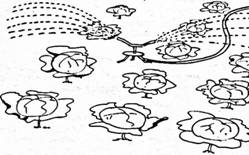
Water is supplied to crops through pipes which have nozzles at one end to spray the water.
the sprinkler irrigation method
DRIP IRRIGATION
This is also known as trickle irrigation. Water is led through plastic pipes which are laid on the ground. The pipes have small holes through which water comes out. The spacing between the holes is determined by the distance between the planting stations of the crops. Water intake by the soil is controlled.
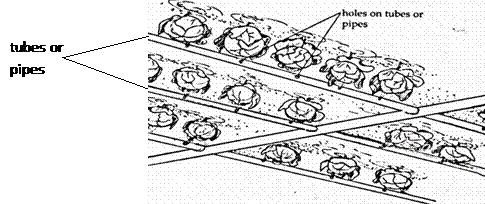
the drip irrigation method
BASIN IRRIGATION
Water is led to basins through furrows. This method is good for fruit trees.
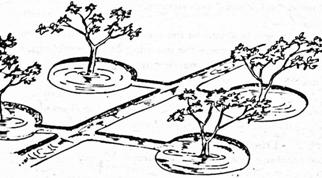
the basin irrigation method
FLOODING IRRIGATION
Water is supplied in a plot through flooding. This method is common in rice fields. The land should be flat.

UNIT 6 SOIL COMPOSITION
The term ‘soil’ means the loose material covering the surface of earth.
THE COMPOSITION OF SOIL
Soil is made up of different materials.
These include the following:
- Inorganic matter
- Organic matter
- Soil water
- Soil air
INORGANIC MATTER
- This is made up of sand, silt and clay particles. This forma the largest part of the soil.
ORGANIC MATTER
- This is made up of living, decaying and decayed plant and animal parts. The decayed matter is called humus.
SOIL WATER
- This is soil moisture.
SOIL AIR
- This is air trapped between the soil particles.
UNIT 7 THE IMPORTANCE OF SOIL THE IMPORTANCE OF SOIL TO CROPS
- Holds plants
- Supplies water to plants
- Provides mineral salts to plants
- Provides air
- It is home of soil organisms
UNIT 8 FARM IMPLEMENTS
NAMES AND PARTS OF FARM IMPLEMENTS
- The wheelbarrow
The wheelbarrow has four main parts:
- Wheel
- Handles
- Barrow
- Frame
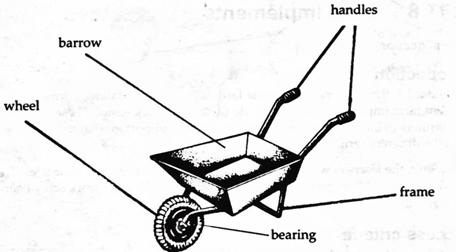
a wheelbarrow
Wheel: it rolls over the ground to enable the barrow to be pushed more easily. Handles : they enable the farmer to hold and push the barrow.
Barrow : this is the basin or box in which the materials being transported are placed. Frame : this is the structure to which all the other parts are attached.
- THE MAIZE SHELLER
This implement is used to shell maize. Major parts of the maize sheller are:
- Loading hopper
- Drum
- Shelling disc
- Steel supporters
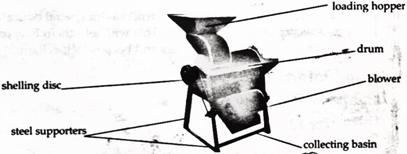
a maize sheller
![]() Loading hopper : this is where maize cobs are placed or loaded for shelling.
Loading hopper : this is where maize cobs are placed or loaded for shelling.
![]() Drum : the cobs slide into a drum where shellers are placed.
Drum : the cobs slide into a drum where shellers are placed.
![]() Shelling disc : the shellers in the drum are attached to a shelling disc which spins during shelling process.
Shelling disc : the shellers in the drum are attached to a shelling disc which spins during shelling process.
Steel supporters – the implement is held upright by strong steel bars.
- A FARM CART
This is used for transporting farm goods. The main parts of a farm cart are:
- Cart body
- Dazzle boom
- Wheels and tyres
- Yoke
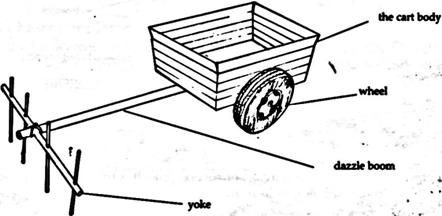
a farm cart
![]() Cart body: this is a box-like structure made of wooden planks bolted together. It is where goods are loaded.
Cart body: this is a box-like structure made of wooden planks bolted together. It is where goods are loaded.
Dazzle boom : this supports the cart body and joins it to a yoke.
Wheels and tyres : they roll on the ground so that the cart can move more easily when pulled by draught animals
Yoke : this is a wooden structure which connects the cart to the necks of the draught animals.
- TREADLE PUMP
This is used for pumping water from a source to a crop field. Major parts of treadle pump are:
- Handle
- Treadles
- Barrel assembly
- Pulley
- Inlet pipe
- Outlet pipe
- WIND MILL
- Bladed turbine
- tower
- A MOTORISED WATER PUMP
- Transporting materials such as farm produce, fertilizers, manure,
- Shelling dry maize
- Transporting farm produce from the farm to the home or market
- Transporting farm inputs such as fertilizer, seed, farm produce, manure, building materials
- Lifting water from wells, boreholes or open sources (rivers or lakes)
- Drawing water
- Drawing water
- Generating electricity
- Dress suitably for the task, for example, avoiding wearing loose clothing that can be caught in a moving or rotating implement
- Using implements properly
- Ensuring that implements are in good state of repair
- Checking implements before use to ensure that bolts and nuts are securely fixed to avoid wobbling
- Following the manufacturer's instructions or procedures when using farm implements
- Greasing all moving parts
- Properly fixing the wheel axle
- It should not be overloaded to avoid loss of balance
- Bolts and nuts should be tightened before use
- Tyres should be properly inflated
- Draught animals should be strong and of the same size
- The yoke should be the correct size for the oxen
- The yoke strap should be strong
- The cart should be fitted with reflectors to avoid accidents
- Check the pulley and rope before use
- Hold the handle firmly
- Check that fasteners are tight to keep the vane in place
- Keep fuel and oil in safe place
- Tighten bolts and nuts before use
- Grease all moving parts before use
- Keep battery acid away from your skin or eyes
- Replace worn out parts
- Load it appropriately
- Clean it well after use
- Paint it when not in use to prevent rusting
- Store it in a shed for protection against the sun and rains
- Grease the wheel axle
- Replace worn out parts
- Grease moving parts to reduce friction
- Clean it properly (dust it)
- Change oil and oil filter regularly
- Set the maize sheller properly
- Paint it if not in use to prevent rusting
- Store it under the shed
- Replace worn out parts
- Grease bearings regularly
- Inflate tyres at the correct pressure
- Avoid overloading it
- Keep the farm cart under the shed if not in use
- Replace worn out parts
- Grease moving parts to reduce friction
- Paint it when not in use
- Change the oil and clean the filter on the compression
- Grease the moving parts
- Replace worn out parts
- Re-paint the rotor
- Service pump
- Tighten fasteners
- Change the oil regularly
- Check the wiring
- Replace worn out parts
- Overhaul the engine
- It is a source of farm record
- It guides the farmer to carry out all farming operations or activities at the appropriate time
- It is easy to till the ground
- It promotes the decomposition of crop residues which improves soil fertility
- It enables the farmer to plant with the first rains
- Site selection
- Clearing land
- Ploughing the land
- Ridging
- Making box ridges
- Ability to germinate
- Large size
- Wholeness (unbroken or undamaged)
- Free from diseases
- Purity (not mixed with any other materials)
- Maturity
- Suitable variety for climate of the area
- Using hoes
- Ploughing
- Using hands
- Using chemicals
- Chisoso (black jack)
- Msonthi
- Bonongwe (Amaranthus)
- Luba
- Namsongole (tares)
- Dawe
- Khovani
- Chilungumwamba
- Denje
- Likodza
- Kalasawene
- Volunteer crops such as maize, millet and sorghum
- Competition for nutrients
- Competition for water
- Competition for sunlight
- Transmission of diseases
- Harbouring pests
- They damage the stems and eat the soft parts of groundnut pods
- Avoiding growing groundnuts in gardens
- They suck plant juice and transmit a virus which causes rosette disease in groundnuts
- Early planting
- Planting closer together so that leaves cover the soil completely
- Practicing crop rotation
- Correct spacing of plants
- Spraying chemicals
- They dig up and eat planted seeds or mature nuts
- Scaring
- Trapping
- They eat up nuts in the garden and in
- Trapping
- They dig up planted seeds and mature
- Scaring
- Planting early
- Recommended spacing to prevent aphids multiplying
- Uprooting the diseased plants and burning them
- Using resistant varieties such as RG1, Nsinjiro
- Early leaf spot
- Late leaf spot
- Spraying the plants with recommended fungicides
- Growing resistant varieties
- Practicing crop rotation
- They attack fresh leaves and shoots especially during the dry season
- The tips of the shoots shrivel and die
- Early planting
- Planting stem cuttings that are not attacked by green spider mites
- They suck juice from the plant
- They cause lumps and knots in the tubers
- They spread cassava mosaic disease
- Planting stem cuttings which are free from white flies
- Early planting
- They dig up mature tubers
- Scaring
- Trapping
- Cassava mosaic. It is caused by virus and transmitted by white flies.
- Bacterial blight. It is caused by bacteria.
- Change shape of the leaves and become yellow
- Using healthy cuttings
- Early planting
- Uprooting and burning diseased plants
- Shoot tips turn brown
- Leaves develop brown patches, wilt and fall off
- Using healthy cuttings
- Early planting
- Uprooting and burning diseased plants
- Practicing crop rotation
- Dig up the plants with a hoe carefully to avoid nuts breaking off and remaining on the ground and pull them down
- Stack groundnuts and leave the plants in the sun with pods up for few days to dry
- Pull off the nuts from the plants, that is, strip off the nuts (kuthothola)
- Spread groundnuts on the mats to dry again for a week
- Heap fermentation
- Soaking fermentation
- peeling the outer covers
- Slicing
- Heap to ferment
- Drying
- Peeling
- Soaking in containers
- Cleaning
- Pounding
- Drying
- Chickens
- Pigeons
- Ducks
- Geese
- Turkeys
- Guinea fowls
- Source of food to people
- Beautification
- Source of manure
- Employment
- Source of raw materials
- Source of income
- Layers
- Broilers
- Free range system
- Semi-intensive system
- Intensive system
- Chickens can find feed for themselves
- Chickens are able to get sunshine
- Manure is well spread all over the field
- The children house does not need expensive materials to construct
- Predators can catch the chickens
- It is difficult to collect eggs at they may be laid in the bush
- Chickens can easily catch diseases
- Difficult to control breeding
- Chickens do not go far away
- Easy to collect manure
- It is easy to control diseases
- It is easy to collect eggs
- Chickens can be fed on locally made feed
- Feed must be provided as chickens cannot find enough feed for themselves
- Deep litter houses
- Battery cages
- Many chickens can be kept in a small area
- More eggs and meat are produced in this system than in the semi-intensive system
- Chickens are well protected from disease and predator attacks
- There is problem of cannibalism and egg eating
- Chickens can easily catch diseases if litter has a lot of moisture
- Litter may not be available when needed
- It is difficult to identify non-laying chickens
- The farmer can keep many chickens on a small piece of land
- Individual record of the chickens can be kept
- Chickens cannot practise egg eating and cannibalism
- No contamination of food and water with droppings
- Clean eggs are collected
- High egg, meat and manure production
- It needs a lot of money to buy the cages
- High level of management needed for maximum profits
- Broad heat and blunt, short beak
- Bright eyes
- Large smooth comb
- Well-built and roomy body
- Strong legs
- A wide, moist vent
- A large smooth comb
- Bright eyes
- Strong and healthy legs
- Strong body
- walking backward
- loss of balance
- vaccination
- failing on one side
- head shaking
- twisting of neck
- paralysis
- coughing
- sneezing
- difficulty in breathing and grasping for air
- kill all the infected birds
- burn or bury all dead birds
- disinfection
- sores or spots or patches on face, wattles, comb, around eyes and beak
- vaccination
- isolation of infected birds
- sneezing
- coughing
- watery discharges from eyes and nose
- vaccination
- cleanliness
- Isolation of infected birds
- blood in droppings
- rough feathers
- weak birds
- Drugs added to drinking water and feed
- Disinfection
- Clean house and equipment
- Greyish dropping
- Blue wattles, combs and face
- vaccination
- internal parasites
- external parasites
- Suck digested feed
- Chicks fails to gain weight
- Cleanliness in houses
- Keep feeding and drinking places dry
- Use piperazine (de-worming )
- Suck digested feed
- Chicks fail to gain weight
- Older birds lose weight
- Reduce eggs production
- Clean the khola
- Keeping litter dry
- Raising the young
- Use piperazine (de-worming)
- Scales on legs
- Cleanliness in the khola
- Wash legs with paraffin or gamatox solution
- Apply petroleum jelly
- Irritating skin
- Birds sand-bathe
- Cleanliness in the
- Dust pesticides into
- Cleaning
- Grading
- Packaging
- Setting a market price
- Storing while awaiting selling
- Transporting
- Shell quality – smooth, even and not cracked
- Cleanliness – dirty eggs may be rejected as they may be contaminated
- Shape – a normal egg is oval: very round or very long eggs do not fit well into the egg trays and as a result are easily broken.
- Colour – local preferences may be for brown or white eggs.
- Size or weight – eggs size must be uniform. Very small eggs are rejected. Extra-large eggs or double yolk may not be suitable for packing for transportation as they might break
- Broilers – young chickens under 12 weeks, which give tender meat (also called friers)
- Roasters – young chickens under 8 months. They are tender but less than broilers.
- Hens – mature female chicken, usually an old layer, more than 10 months old, less tender than a roaster, suitable for stewing.
- Cocks (old roasters) – mature male chicken with course skin, toughened and darkened meat. It is suitable for stewing.
- Apply wood ash from bitter trees.
- Keep the seedbed free from sticks and weeds
- Dig up and destroy them
- Pick and kill them
- Spray with tephrosia liquid (sock 2 kg of crushed tephrosia in pail overnight
- Following recommended spacing
- Using clean farm tools and gentle handling
- Frequent weeding
- mulching
- watering
- weeding
- manure and fertilizer application
- pest control
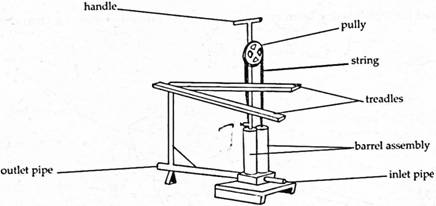
a treadle pump
Handle : the person operating the treadle pump holds the handle for support.
Treadles : these are the two wooden foot pedals. They are used to pump water through a walking motion. Barrel assembly : the two pistons which help to draw the water.
Pulley : this is the metal wheel which helps in lifting the water.
Inlet pipe : This is also called intake or suction pipe. It is used to carry water from water sources such as boreholes, wells, lakes or rivers.
Outlet pipe : this delivers water towards the garden.
Main parts of a wind mill are:
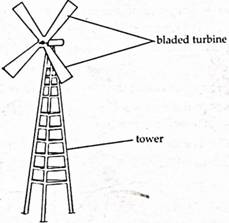
a wind mill Bladed turbine : this rotates in the blowing of the wind.
Tower : this supports the wind turbine
USES OF FARM IMPLEMENT
Farm implement |
Uses |
Wheelbarrow |
building materials |
Maize sheller |
|
Farm cart |
|
Treadle pump |
for irrigating crops |
Motorised pump |
|
Wind mill |
UNIT 9 SAFETY MEASURES IN USING FARM IMPLEMENTS
GENERAL FARM SAFETY RULES IN USING FARM IMPLEMENTS
FARM-CART
TREADLE PUMP
WINDMILL
MOTORIZED PUMP
UNIT 10 MAINTENANCE OF FARM IMPLEMENTS
WAYS OF MAINTAINING FARM IMPLEMENTS WHEELBARROW
MAIZE SHELLER
FARM CART
TREADLE PUMP
WINDMILL
MOTORIZED WATER PUMP
UNIT 11 THE FARMING CALENDAR
MEANING OF THE TERM 'FARMING CALENDAR'
A farming calendar is a list of activities to be done in each month of the year for a given crop.
THE IMPORTANCE OF A FARMING CALENDAR
UNIT 12 LAND PREPARATION FOR GROUNDNUTS AND CASSAVA
Land preparation for growing field crops such as groundnuts and cassava should be done soon after harvesting the preceding crop.
This is what is known by early land preparation.
REASONS FOR EARLY LAND PREPARATION
ACTIVITIES INVOLVED IN LAND PREPARATION
UNIT 13 SEED SELECTION IN GROUNDNUTS AND CASSAVA
In Malawi, most farmers buy seeds from shops.
However some farmers select seeds or planting materials from the previous crop.
FACTORS TO CONSIDER WHEN SELECTING GOOD SEEDS OR PLANTING MATERIALS
UNIT 14 PLANTING GROUNDNUTS AND CASSAVA
Like any other field crops, groundnuts and cassava must be planted at the right time, spacing, seed rate and depth.
Groundnuts
In Malawi, groundnuts are planted with the first or soaking rains of between 25mm and 30mm.
It is usually between October and November in the southern region and November and December in the central and northern regions.
The spacing between ridges and planting stations for groundnuts depends on the variety.
VARIETIES, SEED RATE AND SPACING IN GROUNDNUTS
Variety |
Seed rate (kg/ha) |
Spacing (cm) |
Planting depth |
Chalimbana |
110 |
75 x 15 x 1 seed |
5-7cm |
Chitembana |
120 |
75 x 15 x 1 seed |
5-7cm |
CG7 |
110 |
75 x 15 x 1 seed |
5-7cm |
Nsinjiro |
100 |
75 x 15 x 1 seed |
5-7cm |
Manipintar |
80 |
75 x 15 x 1 seed |
5-7cm |
Mawanga |
80 |
75 x 15 x 1 seed |
5-7cm |
RG1 |
80 |
75 x 15 x 1 seed |
5-7cm |
Malimba |
45 |
75 x 10 x 1 seed |
5-7cm |
Kakoma |
60 |
75 x 10 x 1 seed |
5-7cm |
Baka |
60 |
75 x 10 x 1 seed |
5-7cm |
Cassava
Cassava is also planted with the first soaking rains in all the regions in Malawi.
It is recommended to plant cassava on ridges spaced at 90 centimetres apart and 90 centimetres between planting stations where it would be processed into Kandowole.
For the tubers to be sold fresh at the market, spacing of 90 centimetres between ridges and 45 centimetres between planting stations is used.
Cassava planting materials must be obtained from a middle portion of a well matured plant. Cassava cuttings should be 25 to 30 centimetres long with at least two nodes.
Cuttings should be planted at an angle and two thirds of the cuttings should be planted into the soil. This prevents water from settling down on the cut edges which can cause rotting of the cutting.
The improved varieties of cassava include silira, maunjiri and mkondezi.
There are also local varieties that are grown in Malawi like Manyokola (mbundumali), Gomani and Chitembwere.
Groundnut seed and cassava planting materials that have not germinated or sprouted have to be replaced immediately so that they can almost grow together with the seeds or planting materials of the first planting.
Replanting where germination failed is called 'supplying'.
Supplying is important because it helps to maintain both the plant population and yield of a particular crop.
UNIT 15 WEEDING IN GROUNDNUTS AND CASSAVA
WEEDING GROUNDNUTS AND CASSAVA
The best time to weed is when weeds appear.
It is also recommended to weed while the crops are still young. This does not disturb the developing roots.
METHODS OF WEEDING GROUNDNUTS AND CASSAVA
COMMON WEEDS OF GROUNDNUTS AND CASSAVA
EFFECTS OF WEEDS IN GROUNDNUTS AND CASSAVA
UNIT 16 PESTS AND DISEASES IN GROUNDNUTS AND CASSAVA
THE PESTS OF GROUNDNUTS, DAMAGE DONE AND THEIR CONTROL
Pest |
Damage done |
Control/prevention |
Termites |
that have termites mounds or a history of termites |
|
Aphids |
|
|
|
Birds |
||
Mice |
storage |
|
Monkeys |
nuts |

a termite
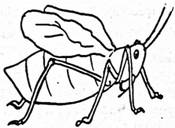
an aphid
THE DISEASES OF GROUNDNUTS
Rosette
Rosette is caused by a virus and spread by aphids. The disease restricts pod formation.
The crop has a stunted growth.
Sometimes the groundnut leaves look wrinkled with dark green or yellow colour.
Control of rosette disease
Leaf spot
This is caused by fungus.
There are two types of leaf spot that attack groundnuts. These are:
Early leaf spot shows reddish brown spots surrounded by a yellow band.
Late leaf spot shows darker and smaller spots without a yellow band around them.
Control of leaf spot
THE PESTS OF CASSAVA, DAMAGE DONE AND CONTROL OR PREVENTION
Pest |
Damage done |
Control/prevention |
Green spider mites |
||
White flies |
||
Mice Hares Wild pigs Monkeys |
The diseases of cassava
THE DISEASES OF CASSAVA, EFFECTS AND CONTROL
Disease |
Effects (damage) |
Control/prevention |
Cassava mosaic |
||
Bacterial blight |
||
|
|
UNIT 17 HARVESTING GROUNDNUTS AND CASSAVA
The success of harvesting depends on the timing of both groundnuts and cassava.
Before harvesting both groundnuts and cassava, it is important to check if they are mature.
Groundnuts
Groundnuts are mature and ready to harvest if the inside of the pod is spotted pale brown. This is usually after three to five months from the time of planting depending on the variety.
STEPS TO FOLLOW WHEN HARVESTING GROUNDNUTS
Cassava
Cassava is usually mature and ready to harvest when it has been growing for one year. Cassava is usually mature when the soil on which it grows starts to crack.
It can be harvested by cutting off the stems with a panga, removing the soil around the roots with a hoe and then pull them out
UNIT 18 PROCESSING AND STORAGE OF GROUNDNUTS AND CASSAVA
Cassava and groundnuts need to be processed and stored properly.
Processing of cassava helps it to stay for a longer period of time and attracts high prices on the market.
Groundnuts
Groundnuts’ inside shells take 3 to 6 weeks to dry. Sometimes groundnuts are dried in stooks for quick drying.
It is not recommended to dry groundnuts on iron sheet roofs.
Pods are then removed by hand or machine from the plant when they start to rattle. Groundnuts are then winnowed to remove soil debris or trash.
After drying, shelling is done by hand or machine.
After shelling, groundnuts are graded to remove mouldy and broken nuts from good ones. Take note that oil nuts such as mawanga and manipintar are usually sold in pods.
Shelled nuts may be roasted, pounded into flour and made into sauce. Sometimes farmers roast, salt groundnuts and put them in small plastic packets. These are sold as an income generating activity at local markets.
CASSAVA
Cassava is best stored in processed form because it does not take long to rot after harvesting. There are two methods of processing cassava.
These are:
HEAP FERMENTATION
This involves:
SOAKING FERMENTATION
This involves:
Fermentation helps to remove the toxic substances from the bitter varieties of cassava and improve taste When slicing cassava, chips or slices are prepared about 2.5 to 7.5 centimetres for easy drying.
Large chips develop moulds especially when harvesting is done in rainy season.
Sweet varieties of cassava are prepared by peeling, cutting the tubers into small pieces and boiling.
STORAGE OF GROUNDNUTS AND CASSAVA
Groundnuts
Dried groundnuts can be stored either in shelled or unshelled form. Unshelled groundnuts are stored in sacks, granary (nkhokwe) or in clay pots. Shelled groundnuts are stored in sacks.
The sacks are stacked on planks or logs to allow free movement of air to prevent moisture which attracts the growth of moulds on the groundnuts
Groundnuts store better in pods because it is difficult for moulds to attack. Before storage, groundnuts need to be winnowed to clean them.
Cassava
Farmers are encouraged to store cassava in processed form such as dried pieces (makaka) or flour. Processed cassava stay longer in storage without getting rotten.
Apply 25 grammes of actellic dust to 50kg of makaka to avoid weevil damage.
Cassava chips should be kept dry and away from wet conditions to prevent them from developing moulds. Mouldy cassava chips are not good for consumption and cannot sell well on the market.
UNIT 19 TYPES AND IMPORTANCE OF POULTRY
Poultry means all domesticated birds.
TYPES OF POULTRY
IMPORTANCE OF POULTRY
TYPES OF CHICKENS
Layers are kept mainly for egg production Broilers are kept mainly for meat production
In Malawi farmers also keep the Black Australorp locally known as Mikolongwe. These are kept for both meat and eggs.
BROILERS
Broilers are big, heavy and grow very fast.
They are usually ready for use at the age of 6 to 8 weeks.
The improved breeds of broilers kept for meat in Malawi include Stabro, Indian River and Ross.
LAYERS
Layers are small, light and grow slowly.
They take about 18 to 20 weeks before they start laying eggs.
There are several improved breeds of layers kept and these include Hyline, White leghorn and Shavers.
UNIT 20 SYSTEMS OF KEEPING CHICKENS 1
Chickens need proper housing to protect them from bad weather, predators and thieves. It is important to provide enough space.
A clean chicken house will help to control diseases and parasites. There are three main systems of keeping chickens.
These are:
FREE RANGE SYSTEM
Chickens are left free all day, getting their own feed in form of green grass, insects and any leftover food. The chickens are not restricted by a fence.
This system is adopted where there is enough land.
ADVANTAGES OF FREE RANGE SYSTEM
DISADVANTAGES OF FREE RANGE SYSTEM
SEMI-INTENSIVE SYSTEM
The chickens are allowed to move freely during the day to eat insects, grass, worms and grit in a fenced area. They are provided with a house to sleep at night.
Feed and water are provided within the fence. Laying nets are provided.
The house provided can either be traditional or deep litter.
ADVANTAGES OF SEMI-INTENSIVE SYSTEM
DISADVANTAGE OF FREE RANGE SYSTEM
UNIT 21 SYSTEMS OF KEEPING CHICKENS 2
INTENSIVE SYSTEM OF KEEPING CHICKENS
The chickens are confined all the time.
This system requires high levels of management and totally depends on commercial feeds.
There are two main houses used to keep chickens under this system. These are
DEEP LITTER HOUSE
Chickens are confined (kept) throughout their life in a house. Part of the wall is built with wire mesh to allow ventilation. The house is built on a raised ground.
The floor is well filled with litter up to 10 to 15 centimetres high.
The litter can be made of sawdust, wood shavings, crashed maize cobs or chopped straws. The litter is turned constantly using a rake.
The old litter is removed when new birds are put into the house. The house has a floor space of 2 to 3 birds per square metre.
The farmer provides laying nests, roosting perches, feed and water troughs.
ADVANTAGES OF DEEP LITTER HOUSE
DISADVANTAGES OF DEEP LITTER HOUSE
THE BATTERY CAGE SYSTEM
This is the most intensive of all the systems. The chickens are put in cages.
The number of chickens per cage varies from 1 to 4.
The cages are made of wire and placed in tiers, generally one above the other. They stretch the whole length of the house.
Each cage has a sloping floor to allow for easy flow of eggs.
Since the droppings fall onto the floor, the lowest tier of cages should be 0.6 to 0.9 metres above the floor for easy cleaning.
Watering and feeding are continuous throughout the length of the cages. Battery house should have adequate light and air should move freely.
The floor is made of concrete.
This system is recommended for layers.
ADVANTAGES OF BATTERY CAGE SYSTEM
DISADVANTAGES OF BATTERY CAGE SYSTEM
UNIT 22 CHICKEN FEED AND FEEDING
TYPES OF FEEDS FOR CHICKENS
Chickens need feed every day. The type of feed depends on the type and the age of chicken. The feed given to the chickens must always be balanced. A balanced food has all the needed nutrients in correct amounts for the chickens to be healthy and provide meat or eggs. These feeds can be brought from the shops or prepared locally on the farm.
The locally prepared feed is made by mixing 1 part maize meal, 1 part maize bran and 1 part bean meal. Instead of bean meal a farmer can use any other protein source such as cotton seed meal, groundnuts meal, fish meal, meat and bone meal. However the beans must be roasted before grinding to make a bean meal. If
the chicken are feed on locally prepared feed, they must be given plenty of green vegetable as the source of vitamins.
Layers, on locally prepared feeds, must be prepared with lime, burnt and crushed bones or eggshells so that they produce eggs with strong shells.
The commercial feed is already balanced. The farmer will buy according to the needs of the chickens whether layers or broilers and their age.
The feeding is done as shown in the tables below:
Feeding of layers
Types of chicken |
Ages |
Types of feed |
Layers |
Day old to 8 weeks |
Chick starter marsh |
9 weeks to 16 weeks |
Growers marsh or pellet |
|
17 weeks on wards |
Layers marsh or pellet |
Feeding of broilers
Types of chicken |
Stage of development |
Types of feed |
Broilers |
Day old to 3 weeks |
Broiler starter marsh |
4 weeks to 5 weeks |
Broiler grower marsh or pellet |
|
6 weeks to 8 weeks |
Broiler finisher marsh or pellet |
Or
Types of chicken |
Stage of development |
Types of feed |
Broilers |
Day old to 4 weeks |
Broiler starter marsh |
5 weeks to 8 weeks |
Broiler finisher marsh |
FEEDING CHICKENS
Chicken feed and water must be available all the time. The feed is placed in feed troughs (feeders) and water is put in water troughs (waterers). Clean water must be provided every day. Always wash the water troughs before putting fresh water.
UNIT 23 BREEDING PRINCIPLES FOR CHICKENS
SELECTION OF CHICKENS FOR BREEDING
It is the aim of every farmer to produce more eggs and chicken meat. To get this, a farmer must start with strong and healthy chicks. Such chicks will be produced if the cock and the hen have the required
characteristics of high eggs and meat production. This required good selection of a hen and a cock to be parents for the wanted chicks. It is recommended to mate cocks of black austrolop (mikolongwe) with a local hen in order to improve meat and egg production. The offspring will have the better resistance to diseases and survive under hard conditions.
CHARACTERISTICS OF A GOOD HEN
CHARACTERISTICS OF A GOOD COCK
UNIT 24 THE DISEASES AND THE PARASITES OF CHICKENS
THE DISEASES OF CHICKENS
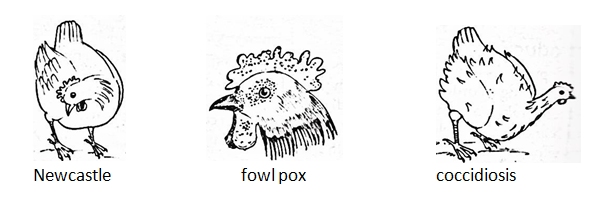
COMMON DISEASES OF CHICKEN
Name |
Causes |
Signs and symptoms |
Prevention |
Treatment |
Newcastle |
virus |
none |
||
|
|
|
||
Fowl pox |
virus |
none but antibiotic can be used for the sores. Iodine can also be applied on sores |
||
Coughs Sneezing |
virus |
no specific treatment |
||
Coccidiosis |
protozoa |
Use suitable drugs. For example, sulphamerazine, sulphamethizine, amprolium |
||
Fowl cholera |
bacteria |
Antibiotics, for example, tetracycline sulfer |
THE PARASITES OF CHICKENS
Two groups of parasites attack chicken. These are:
The internal parasites live inside the chickens, in the intestines. They feed on the food that is the chickens eat. They can block the chicken’s digestive system.
The external parasite live on the surface of the chicken, infesting the skin feathers and legs. They suck blood and cause irritation.
SOME OF THE COMMON PARASITES OF CHICKENS
Parasite |
Signs of infestation or |
Prevention |
Treatment |
Tapeworms |
|||
Roundworms |
birds away from the older birds |
||
Scaly legs mites |
or grease on legs |
||
Fleas and lice |
khola |
feathers |
UNIT 25 MARKETING OF CHICKEN PRODUCTS
MARKETING OF CHICKEN PRODUCTS
Chicken products that a farmer can sell include eggs, chicken meat (or live chickens), and manure.
MARKETING OF EGGS, CHICKENS AND CHICKEN PRODUCTS
Where farmers sell eggs and chickens
Poultry farmers sell chickens and eggs at local market, district council markets, town markets, hotels, restaurants, super markets and other institutions.
Procedures for marketing chickens and chicken products
Marketing of chickens and chicken products involve the following:
Cleaning
Eggs covered with chicken droppings or remains of broken eggs or litter cannot be easily sold. They should be cleaned by wiping them with a moist cloth. However, only very dirty eggs need to be cleaned. Washing eggs should be avoided because it removes the productive coat on the outside surface of the egg.
Dirty eggs become infected easily and lose their quality and become poisonous. It is therefore to ensure that eggs are laid in clean conditions in order to avoid the need for cleaning them.
Chickens must be washed with clean water after plucking the feathers to remove dirt.
Grading
The external qualities of commercial eggs are measured by:
CLASSES OF MARKET CHICKENS
The poultry farmer can sell chickens as:
Storage
Eggs break easily. It is therefore important that they are handled carefully in order to reach the consumer without losing much of their original quality. They must be stored at a cool place as they easily rot.
Eggs absorb strong smells and lose their taste. They should therefore be stored away from strong smelling substances such as paraffin, onions and fish. Chicken meat is stored in refrigerators or cold rooms as it can easily rot.
Transporting chickens and chicken products
Eggs break easily. They must therefore be transported carefully while packed in trays. Egg trays can be transported in wheelbarrows, cars, bicycles. Live chickens can be carried in baskets or boxes.
Setting market prices
The market price for chickens and chicken products must include the cost of production, cost of marketing activities such as the cost of plastic paper for packaging, transport, storage and profit.
Selling chicken manure
Chicken manure can be sold locally to farmers who grow crops and keep fish. Chicken manure can also be sold to the industries for making organic fertilizers.
UNIT 26 TREE NURSERY ESTABLISHMENT
SEED SELECTION
It is important to select good seed for planting to ensure high germination percentage and healthy strong seedlings. Seed can be collected from already existing trees. Ensure that the seed is disease free, plump and from mature fruits. The seed must be whole and able to germinate. Avoid seed which has overstayed by checking the expiry date when using seed which has been bought.
SEED TREATMENT
Some seeds have very hard seed coats which prevent water from entering the seed for germination. They can either be nicked, socked or rubbed with sand paper.
Seed treatment
Tree species |
Seed treatment |
Leucaena |
nick (small cut or notch) |
Kachere |
remove fleshy pulp |
Chamwamba |
remove from pod or shell |
Chitimbe |
nick |
Acacia |
nick |
Msangu |
nick |
gliricidia |
nick |
SEED BED PREPARATION
After selecting the site for a nursery establishment, it must be fenced. The land must be tilled to a depth of more than 30 centimetres to loosen the soil and improve drainage. The beds should 90 centimetres wide and 15 centimetres high. Well rotten manure should be mixed in the ratio of two parts soil, one part manure and one part sand. The seeds can be sown on flat beds to avoid run off. They can also be sown in pots, plastic tubes of opaque beer packets.
SOWING
Make furrows 10 centimetres apart along the width of the seedbed in straight lines for easy cultivation and extraction. Large seeds like gliricidia and acacia must be planted at a depth of 1.5 centimetres. Medium seeds like msangu must be planted at a depth of 1 centimetre. Small seeds like sensibania and Cinderella should be planted at a depth of 0.5 centimetre. The seeds should be sown 5 centimetres apart and covered lightly with the soil.
Tiny seeds may be mixed with sand and spread evenly along the furrow. When sowing seeds in packets, lay the seeds flat in the middle of the container. Push seeds to the required depth with a finger or stick. Mulch the seeds with leaves or grass to reduce evaporation.
UNIT 27 TREE NURSERY MANAGEMENT
Tree nursery management involves a number of activities.
These activities include watering, weeding, thinning, pest and disease control and hardening off seedlings.
Watering
Water seedbeds in the morning and late in the afternoon every day until the seedlings are 4 weeks old. Avoid watering at midday when evaporation is at its highest. Avoid under-watering because it will result into wilting. Start hardening off in the fourth week by watering once in the morning only.
Weeding
Weeding is necessary to reduce competition for nutrients, water, light and space. It also reduces the incidence of pests and diseases. Hand weeding is recommended to avoid damaging the roots. It is necessary to make the soil loose using a small sharp stick.
Thinning
This can be done when there are too many seedlings in the furrow (drills). Seedlings which are very overcrowded grow thin, and tall and heavily compete for space, sunlight and water.
Controlling pests and diseases
Seedlings have to be protected from diseases and pests. Some pests of tree seedlings are ants, termites, cutworms, beetles and caterpillars.
PESTS
PESTS AND THEIR CONTROL MEASURES
Pest |
Control |
Ants and termites |
|
Cutworms |
|
Beetles |
|
Caterpillars |
and spray the filtered solution the following day. Repeat the application 2 to 3 times per week) |
DISEASES
Damping off
This is the common nursery disease caused by fungi.
PREVENTION OF DAMPING OFF DISEASE
Hardening off
This is done to prepare seedlings for the hot and dry conditions in the woodlot. It can be done by reducing the frequency of watering from twice to once a day 4 weeks after germination. Reduce the shading materials to half at the 4th week and remove them completely after the seventh week from date of sowing.
UNIT 28 WOODLOT ESTABLISHMENT
LAND PREPARATION
Seedlings are planted in holes.
Holes should be made in the dry season.
They must be 60 cm in diameter and 60 cm in depth. When digging the holes, separate top soil from sub soil. Mix the top soil with manure.
When replacing the soil into the pit, put in top soil mixed with manure first and then subsoil.
A stick can be inserted in the middle to indicate where the tree seedlings would be transplanted. The distances between the planting stations vary according to tree species and the intended use of the trees.
TRANSPLANTING
It is important to transplant seedlings at the beginning of the rain season to encourage root growth before the end of rain season.
Seedlings should be transplanted on a wet day either early in the morning or late in the afternoon. They should be watered before uprooting for transplanting.
Place seedlings together with soil around the roots in the planting holes.
Cover the seedlings up to the collar mark. Firmly press the soil around the transplanted seedlings to prevent lodging.
UNIT 29 WOODLOT MANAGEMENT 1
WOODLOT MANAGEMENT
To ensure that trees reach maturity, the following management practices need to be done:
MULCHING
Mulching is the process of covering the soil around a crop to conserve moisture.
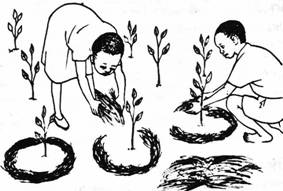
mulching a woodlot Materials used in mulching are cut grass, leaves and crop remains. Mulching is important because It helps in controlling weed growth. After decomposition it improves the soil fertility.
Avoid putting the mulch close to the seedlings because it invites termites.
WATERING
When there is a short break of rainfall and trees show signs of wilting they should be given water. Make a basin of water around the seedling to retain water.
The area around the basin should be 1 square metre.
WEEDING
Use hoes to weed a woodlot during the first 2 growing seasons. Thereafter use slashes to weed a woodlot.
MANURE AND FERTILIZER APPLICATION
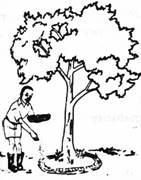
DAP fertilizer can be applied at 50 grammes per tree using the banding method.
the banding method of fertilizer application
Apply two handfuls of manure around tree seedlings.
PEST CONTROL
The major pests of trees are termites and farm animals like goats and cattle.
Termites can be controlled by applying chemicals like Marshal Suscon at the base of the tree. Branches from trees with thorns can be placed around trees to keep livestock away.
A fence can also be erected around the woodlot or around individual trees.
UNIT 30 WOODLOT MANAGEMENT 2
PRUNING
Pruning is the process of removing unwanted tree branches. These include dead, diseased and excess branches.
It is important to start pruning trees while they are young.
When pruning, branches are cut from the bottom upwards to avoid tearing the bark. The cutting must be at an angle.
Always cut using a sharp panga knife or saw. Pruning helps to have straight poles and think trees.
The removal of the diseased branches helps to control the spread of diseases. Trees must be pruned during the dry season so that the cut wounds should heal.
CLEARING FIRE BREAKS
A fire break is clearing around the woodlot to prevent fires.
It measures 3 to 5 metres in the width all around the woodlot.
The fire break must be cleared every year at the end of the rain season. Fire breaks help to protect trees from being burnt by fire.
HARVESTING
Harvesting of trees is done according to the intended purposes. For timber, the trees are harvested when the trunks are thick. For poles and fuel wood, they can be harvested at any time.
Thin or poorly developing trees can be harvested earlier to enable healthier trees to have more space.
The value of the trees can be improved by processing the trees into products such as timber, mortars, pestles, hoe handles, boats and furniture.
REFERENCES
MIE (2007) Agriculture Teacher’s Guide for Standard 6, Domasi; MIE.
Typesetting by Zikomo Masese Banda, an IPTE5 teacher at Kambilonjo Primary School, Kambilonjo Zone, in Ntcheu
UNIT 1 MIRACLES IN THE DESERT
UNIT 2 JESUS’ TEACHINGS THROUGH MIRACLES
UNIT 3 CAUSES AND EFFECTS OF CONFLICTS IN THE FAMILY
UNIT 4 CAUSES AND EFFECTS OF CONFLICTS IN THE SCHOOL
UNIT 5 CAUSES AND EFFECTS OF CONFLICTS IN THE COMMUNITY
UNIT 6 HUMAN RIGHTS AND DEMOCRACY UNIT 7 THE TEN COMMANDMENTS
UNIT 8 THE ARK OF THE COVENANT
UNIT 9 CONFLICT RESOLUTION IN THE FAMILY
UNIT 10 CONFLICT RESOLUTION IN THE SCHOOL
UNIT 11 CONFLICT RESOLUTION IN THE COMMUNITY
UNIT 12 GENDER ISSUES IN THE FAMILY
UNIT 13 GENDER ISSUES IN THE SCHOOL
UNIT 14 GENDER ISSUES IN THE COMMUNITY
UNIT 15 ENTERING THE PROMISED LAND
UNIT 16 JESUS’ MIRACLES OVER NATURE
UNIT 17 JESUS’ MIRACLES OVER DEATH
UNIT 18 THE HOME ENVIRONMENT
UNIT 19 THE SCHOOL ENVIRONMENT
UNIT 20 THE COMMUNITY ENVIRONMENT
UNIT 21 MODERN TECHNOLOGIES IN THE SCHOOL
UNIT 22 MODERN TECHNOLOGIES IN THE CHURCH
UNIT 1 MIRACLES IN THE DESERT WRITTEN
God performed miracles in the desert in order to provide for the Hebrews guidance, protection and daily needs.
MIRACLES IN THE DESERT (Exodus 13:17-22) 1. CROSSING THE RED SEA
When the Hebrews were on their way crossing the Red Sea, God guided them by a pillar of cloud by day and a pillar of fire by night. When they reached the Red Sea, God told Moses to lift up his walking stick (staff) and to hold it out over the sea and the water divided. The Hebrews crossed the sea on dry ground. The Egyptian Army was following them. When the army was in the middle of the sea, God told Moses to hold out his hand over the sea once more. The water started flowing again. The Egyptian Army drowned. God protected the Hebrews from danger. The Hebrews were led by Moses and Aaron from Egypt on to the Promised Land called Canaan.
2. GOD'S PROVISION OF MANNA, QUAILS AND WATER When the Hebrews had no food and water, they started complaining to Moses. God heard their complaint and provided them with food and water. The food was in the form of manna and quails. Manna were cake-like substances. Quails were a kind of birds. These kinds of food were collected just enough for a day without any more to keep for the following day. The daily collection was done for five days. On the sixth day they were collecting food for two days. This was because no collection was done on the seventh day, which was a Sabbath. The Sabbath was to be kept holy. The Hebrews relied on these types of food for forty years. When the Hebrews complained about water, God told Moses to strike a rock with his staff. Water came out of the rock.
UNIT 2 JESUS' TEACHINGS THROUGH MIRACLES
A miracle is an unnatural act or event caused by God. REASONS WHY JESUS PERFORMED MIRACLES
· out of sympathy or mercy
· out of request
· as means of spreading God's message to the world The following were some of the miracles Jesus performed: a) Healing of the Gerasene demoniac (Luke 8:26-29) Jesus drove out demons out of the Gerasene demoniac. By healing the demoniac, who was a Gentile, Jesus wanted to show that his mission on earth was for both Jews and Gentiles. His instructions to the healed man was a means to spread the message to the gentile land. This miracle also showed Jesus' power over demons who are forces of evil. b) Feeding the five thousand Many people followed Jesus to a lonely place. They were five thousand people. Jesus and his disciples had five loaves of bread and two fish. Jesus prayed to God and the food multiplied. He broke the food into pieces and gave it to the people. They ate and were fully satisfied. There were twelve baskets of leftovers. Jesus performed this miracle out of mercy for the people. The five thousand people who came to hear God's word praised him even more after being fed using very little food. Therefore, Jesus provided them with both spiritual and physical needs. c) The healing of Bartimaeus’ eyes (Mark 10:46-52) In Jericho, Jesus healed eyes of Bartimaeus out of request.
UNIT 3 CAUSES AND EFFECTS OF CONFLICTS IN THE FAMILY
CAUSES OF CONFLICTS IN THE FAMILY (Genesis 25:27-28)
Conflicts happen when there are disagreements and misunderstandings between members of the family over an issue. There are many causes of conflicts in the family. The following are some of them:
· children who take alcoholic drinks or smoke chamba do not usually cooperate with their parents or guardians
· parents loving one or two of their children more than the others.
· Unfair distribution of resources
· Forced marriages in order for children and parents or guardians to get economic support In Genesis 25:27-28, Rebecca, the mother of Esau and Jacob, loved Jacob more than Esau and assisted Jacob to get Esau’s blessings. In Genesis 37:1-4, Jacob loved Joseph more than other children
EFFECTS OF CONFLICTS IN THE FAMILY
- Hatred
- Poor relations
- Drug and alcohol abuse
- Stress and anxiety
- Children staying away from school
- prostitution
UNIT 4 CAUSES AND EFFECTS OF CONFLICTS IN THE SCHOOL
CAUSES OF CONFLICTS AT SCHOOL (Genesis 37:23-36)
- ill-treatment
- theft
- gossiping
- discrimination
- jealousy
- lack of communication
THE EFFECTS OF CONFLICTS IN THE SCHOOL
- vandalism
- violence
- poor relationships
- use of abusive language
- hatred
- stress
- anxiety
- harassment
UNIT 5 CAUSES AND EFFECTS OF CONFLICTS IN THE COMMUNITY THE
CAUSES OF CONFLICTS IN THE COMMUNITY (Acts 6:8-15; 2 Samuel 13:7-36)
- jealousy
- cultural practices
- discrimination
- property grabbing
- teenage pregnancy
- gender inequality
- immorality
THE EFFECTS OF CONFLICTS IN THE COMMUNITY
- migration of people
- damage to the environment
- use of abusive language
- hatred
- poor relationships
- violence
- injury
- death
UNIT 6 HUMAN RIGHTS AND DEMOCRACY
VULNERABLE CHILDREN
Vulnerable children are children that lack care, resources, protection from parents or guardians and other members of the society.
GROUPS OF VULNERABLE CHILDREN
- orphans
- street children
- neglected children
- abused children
ORPHANS
An orphan is a person who has lost one or both parents due to death. CHRISTIAN ATTITUDES TOWARDS ORPHANS (Exodus 22:22; Deuteronomy 10:18; Isaiah 1:23; Isaiah 58:7; Job 29:12)
- orphans should be fairly treated, loved, given food and clothes
- orphans should be treated with justice and they should not be oppressed
- orphans should be supplied with necessities of life, for example, school needs, love, shelter, clothes and should not be stigmatised
WAYS OF ASSISTING ORPHANS
- teaching them
- guiding them in Christian and moral values
- providing them with food
- providing them with clothes
- providing them with shelter
- providing them with school needs
- giving them hope
- protecting them
UNIT 7 THE TEN COMMANDMENTS
THE TEN COMMANDMENTS (Exodus 20:1-17)
The history of Israel contains many agreements (covenants) between God and his people. Examples of such agreements were those between God and Abraham, Isaac and Jacob. After some time, God also made an agreement with his people in the wilderness through Moses. This agreement was in the form of laws, which the Israelites were to follow. These laws were called the Ten Commandments.
The first four tell how people should behave towards God. The last six tell how people should behave towards one another.
THE TEN COMMANDMENTS
1. you shall have no other gods before me
2. you shall not make for yourself an image in the form of anything
3. you shall not misuse the name of the Lord your God
4. remember the Sabbath day by keeping it holy
5. honour your father and mother
6. you shall not kill (murder)
7. you shall not commit adultery 8. you shall not steal
9. you shall not give false testimony
10. you shall not covet
THE WORSHIP OF THE ISRAELITES DURING
THE JOURNEY {EXODUS} (Exodus 24:1-5; 20:1-17; 21:18; 32:1-35; 34:1-10)
Whenever God helped the Israelites, they trusted him and worshipped him faithfully. However, when a problem arose, they lost trust and started insulting Moses and God. When the Israelites saw that Moses had taken too long to come back from the mountain, they forced Aaron to make a visible image, which they could worship as a god (idol). When Moses saw that the people were worshipping an idol, he was very angry and in the process, broke the tablets of the Ten Commandments. He destroyed the idol and went back to God and came back with another set of the Ten Commandments. God renewed his covenant with the people of Israel.
UNIT 8 THE ARK OF THE COVENANT
THE ARK OF THE COVENANT (Exodus 25:10-22)
The Ark of the Covenant was a sacred box made of acacia wood. It was covered with pure gold inside and outside. The two stone tablets on which the Ten Commandments were written were put in the Ark of the Covenant. It also contained memories of how God saved his people.
It represented the presence of God. The Ark served as an instrument through which God guided and defended the Israelites in the wilderness. It was also upon the Ark that the highest of Israel’s sacraments the blood of atonement, was presented and received. (Leviticus 16:1-16)
KEEPING THE BIBLE IN A SECURE PLACE
The Bible is not like any other book that the learners read at school and at home. It contains the word of God. The learners need to develop the habit of reading it every day. But as they read it, they need to be aware that they are speaking with God. But as much as the learners should be speaking to God through the Bible every day, they need to have a secure and separate place to keep it. It is not right to place the Bible together with any ordinary books. It is also important that any book that contains the word of God should be handled with a lot of respect. The learners receive documents such as tracks, and the Bible courses, which have to be cared for and not to be left scattered all over the floor. Torn Bible pages should be re-located into the book and not left to be used for any household chores such as lighting fire.
UNIT 9 CONFLICT RESOLUTION IN THE FAMILY
Conflict resolution is the process of bringing disagreements and misunderstandings to an end. When conflicts are not resolved peacefully at an early stage, more serious problems may arise. There are several ways of resolving conflicts peacefully in the family
WAYS OF RESOLVING CONFLICTS IN THE FAMILY
- talking to each other about the conflict
- fair distribution of resources
- showing love
- being considerate when dealing with issues affecting other exercising justice
- guidance and counselling skills
BIBLE STORIES ON THE IMPORTANCE OF RESOLVING CONFLICTS PEACEFULLY (Genesis 13:8-13; 33:1-20; 42:1- 38) In the Bible, a conflict developed between Abram’s herdsmen and Lot’s herdsmen. The conflict did not get worse because Abram used the following ways to stop the disputes:
- he distributed the resources fairly by telling Lot to chaos the best land he wanted
- he respected himself and others
- he exercised justice and patience
What Abram did maintained peace and promoted unity and cooperation. All these apply to peaceful family conflict resolution because Abram and Lot were living together as one family. Esau and Jacob resolved their conflict peacefully by hugging and kissing each other. Joseph forgave his brothers who sold him to the Ishmaelites by welcoming them and giving them food in Egypt.
UNIT 10 CONFLICT RESOLUTION IN THE SCHOOL
Conflicts are part of people’s everyday life. It is important to know ways of handling them because when they are not properly handled, chaos may break at school.
WAYS OF HANDLING (RESOLVING) CONFLICTS PEACEFULLY
- ensuring that those involved in the conflicts discuss the issue
- getting a third person to investigate the matter on both sides and find out who is right and who is wrong
- reconciling the two parties
- providing guidance and counselling to the conflicting parties
- praying to God to help find ways of forging one another
THE IMPORTANCE OF RESOLVING CONFLICTS PEACEFULLY (1 Kings 3:16-28)
- maintains peace
- maintains law
- maintains order
- promotes unity
- promotes cooperation
UNIT 11 CONFLICT RESOLUTION IN THE COMMUNITY
Conflict resolution refers to the settling of differences between and among people.
THREE MAJOR WAYS OF RESOLVING CONFLICTS PEACEFULLY
- negotiation
- mediation
- arbitration
Peaceful conflict resolution calls for tolerance, patience, respect and understanding of what the other person or party feels.
THE IMPORTANCE OF PEACEFUL CONFLICT RESOLUTION IN THE COMMUNITY
- promotes unity
- reduces suffering, loss of life and destruction of property
- enhances a conducive working environment
- promotes cooperation
- restores relationship
- promotes justice, peace, equality and freedom
UNIT 12 GENDER ISSUES IN THE FAMILY
GENDER ROLES IN THE FAMILY
The term ‘gender’ refers to the socially-constructed roles, responsibilities and status. It represents a set of sociological differences between men, women, boys and girls. It is a society’s definition of what males should do and what females should do. Gender issues are amongst the most debatable issues in the world and Malawi in particular because of various socio-cultural and socio-economic reasons.
Gender roles refers to the socially-assigned tasks and responsibilities for males and females in a given society. The family is crucial in deciding and developing gender roles in children. Parents and relatives decide what is expected of males and females including their young children as they assign different roles and responsibilities for boys and girls.
CHRISTIAN APPROACH TO GENDER ROLES
(Genesis 2:18; 25:27-29; Judges 4:4-16; Ruth 2:1-12; Luke 24:1-8) Christians should demonstrate love, fairness and equality in gender issues because the Bible teaches one to love one’s neighbour as one loves oneself. The Bible illustrates that God created a woman to be a man’s helper and not to be abused by the man. In many Malawian cultures, females do more household chores and agricultural tasks than males. This situation prevents females from contributing positively to developmental activities as much as males.
UNIT 13 GENDER ISSUES IN THE SCHOOL
GENDER ROLES AT SCHOOL
It is important for teachers and learners to observe and practice gender equality and gender equity at school.
Gender equity This means giving fair treatment to both females and males.
Gender inequality This occurs when there is unequal treatment of males and females. It also occurs when men or women, girls or boys are not given equal opportunities to do particular tasks just because of their sex. Concern over gender imbalances in access to education arises from the fact that in most Malawian schools, boys are favoured more than girls. For example, the way school activities are planned and conducted encourages gender bias. In co-education schools, girls are usually allocated more traditional chores like sweeping, mopping classrooms and toilets while boys are given lighter tasks like monitoring, litter picking and supervising girls. This gender bias reinforces the feeling that girls are inferior to boys. This attitude in turn affects girls academically since they tend to be afraid of more challenging schoolwork such as mathematics and sciences and leave them for boys without even attempting them.
UNIT 14 GENDER ISSUES IN THE COMMUNITY
GENDER ROLES IN THE COMMUNITY
Traditionally, many societies believe that males and females are different in status. It is assumed that women are inferior to men. Most leadership and decision making positions are held by males. In Malawi, for example, many members of parliament, traditional chiefs, councillors and chief executives are males. In most cases, spouse’s rights are abused. For example, when a husband dies, his relatives may grab all the property the family had. In other societies, husbands also suffer when their wives die. The wife’s relatives grab the property from the widower. In most societies, it is tolerable for a man to marry more than one wife. However, it is almost a taboo for a woman to have more than one husband. The Bible teaches that men and women are equal before God. For example, in Judges 4:4-16, Deborah, the prophet worked with Barak and defeated Sisera. In 1 Kings 17:8-24, a widow in Zarephath assisted Elijah the prophet. In Luke 24:1-8, it is the women who first witnessed Jesus’ resurrection. They were the ones that told the apostles about the resurrection. Both men and women can serve God in the church. They all have talents and have roles to play in the church.
UNIT 15 ENTERING THE PROMISED LAND
THE CROSSING OF THE RIVER JORDAN
(Joshua 3:14-17; 5:13-15) The Israelites were still in the desert on their way to Canaan. God continued assisting them in their daily needs. When they reached the River Jordan, God gave them instructions before crossing it. He told them that: 1. they should consecrate themselves 2. priests carrying the Ark of the Covenant should go before the people 3. people should follow the Ark but keep some distance from it 4. priests carrying the Ark should stand in the middle of the river
When these instructions were followed, the water was divided and the Israelites crossed on dry ground. After crossing the river, Joshua saw a man with a sword near Jericho. This man was the angel of God who was sent to tell Joshua on how to conquer the city of Jericho. The angel told Joshua to remove shoes from his feet because the place he was standing was holy. THE CONQUEST OF JERICHO (Joshua 6:1-27) The angel of the Lord who appeared to Joshua advised him on how to capture Jericho. Following God’s instructions, the Israelites marched around the city of Jericho with soldiers circling it once for six days. Seven priests carried ram’s horn trumpets before the Ark. On the seventh day, they went round the city seven times with priests blowing their horns. When the people heard the sound of the trumpets, in a long blast, they gave a strong shout of joy. Then walls of the city of Jericho fell. This showed God’s continued support for the Israelites.
UNIT 16 JESUS’ MIRACLES OVER NATURE
THE MIRACLE OF CALMING THE STORM
(Matthew 14:22-32) Jesus performed many miracles. He performed these miracles either out of compassion or on request. Jesus used miracles as a means of spreading God’s message to the people. When the disciples were sailing on the Sea of Galilee, they saw Jesus walking on the water. The disciples thought Jesus was a ghost. The fact that Jesus walked on the water clearly shows that he had some power over nature. Then there was a heavy storm on the sea. The disciples were afraid because they lacked faith. Jesus commanded the storm to stop. When the storm calmed down, those who were present declared that truly Jesus was the Son of God because even the winds obeyed him.
TURNING WATER INTO WINE (John 2:1-11)
Jesus attended a wedding in Cana. During the celebrations, they discovered that they had run out of wine. Jesus told them to fill some jars with water. The water eventually turned into wine. This showed that Jesus had power over nature.
UNIT 17 JESUS’ MIRACLES OVER DEATH
THE RAISING OF THE WIDOW’S SON AND JAIRUS’ DAUGHTER FROM THE DEAD
(Matthew 9:18-34; Luke 7:18- 34; Luke 7:11-17; Luke 8:40-56) Death is the ultimate end of life. When death occurs, the relatives of the dead person feel grieved. They know that they have parted forever. Jesus proved that he was the Lord of life and death. The son of a widow at Nain died. When Jesus met the funeral procession, he raised the son from the dead. Those who were present praised God and declared that Jesus was God’s prophet. Jairus, the leader of the synagogue, had a daughter who was sick. Jesus was called but found her already dead. Jesus raised her from the dead because of Jairus’ faith. However, Jesus ordered them to keep this incident a secret because of the wrong Jewish expectation of the Messiah. The Jews thought the Messiah was a political figure who would deliver them from the Roman rule. Yet Jesus was the religious Messiah who came to deliver all the people from the bondage of sin. These miracles showed that Jesus had power over death.
RAISING LAZARUS FROM THE DEAD
(John 11:38-52) Lazarus was the brother of Mary and Martha. They lived in Bethany. Lazarus became sick and the sisters sent for Jesus to come and cure him. Before Jesus came, Lazarus was already dead and had already spent four days in the grave. When he came to see him, Jesus raised Lazarus from the dead by calling out his name and ordering him to come out. Because of this miracle, many Jews believed in Jesus and some Jews plotted to arrest him out of jealousy.
UNIT 18 THE HOME ENVIRONMENT
The term ‘environment’ refers to all living and non-living things surrounding us.
TYPES OF ENVIRONMENT
- physical environment
- social environment
- cultural environment
The physical environment includes soil, water, rocks, mountains or hills, rivers, plants and animals.
The social environment includes family, politics, buildings, roads, bridges and dams. The cultural environment includes customs, traditions, values, language, beliefs, religion, taboos, dress, songs and dances.
CARE FOR THE ENVIRONMENT
God created people and all the things surrounding them so that they could live in peace and support each other. It is important for individuals and families to take care of the things that surround them in order to live happy lives. When people do not take good care of the environment, they cannot obtain enough things necessary for life, for example, food. They can also contract different types of diseases. BIBLE STORIES ON THE CARE FOR THE ENVIRPONMENT (Genesis 1:26; 2:15-18; Ezekiel 34:11-12; Proverbs 12:10) God created people and everything around them. God put people to work on the land and take care of it. People get all the things they need from the environment. They may own a garden and grow crops. They may also raise animals. Every member of a family should take care of the environment for their own benefits and that of future generations.
UNIT 19 SCHOOL ENVIRONMENT
THE THINGS FOUND AROUND THE SCHOOL For the learners to enjoy their lessons at school, the school environment needs to be clean and attractive. A clean environment also protects the learners from accidents and the outbreak of contagious diseases. All this can be achieved by taking care of the school environment through sweeping inside and outside classrooms, slashing tall grass, planting flowers, mopping classrooms and teachers’ offices. The school environment can also be cared for through proper disposal of refuse.
CARE FOR THE SCHOOL ENVIRONMENT
(Genesis 1: 11-12; Genesis 2:15) All the things such as grass, flowers, and trees found around the school were created by God. They were created to help people and other creatures on earth. God takes care of them and makes them grow because he loves them and us. The Bible teaches Christians to love and take care of all things surrounding them in order to live peacefully. The learners should be trained to use rubbish pits to dispose refuse. This will provide the conducive environment for teaching and learning.
UNIT 20 THE COMMUNITY ENVIRONMENT
THE THINGS FOUND AROUND THE COMMUNITY ENVIRONMENT
Every community is blessed in particular ways. It is provided with its own physical, social and cultural environments. All this was created by God. God expects people to conserve and maintain the things that are found in their community. Apart from providing resources for people’s lives, the environment in the community shows the love and the greatness of God.
CARE FOR THE COMMUNITY ENVIRONMENT
(Genesis 1:28-31; Genesis 2:15; Deuteronomy 23:12-14; Luke 13:6-9) The community environment provides several products to people such as food, fresh air and beauty. Other products people get from the environment are water, firewood and medicine. In Genesis 1:28-31, God created people to be in charge of all creation. In Genesis 2:15, the Lord placed people in the Garden of Eden to cultivate it and guard it. In Deuteronomy 23:12-14, God told the Israelites to have a place outside the Camp (home) where they would dig a hole and after helping themselves in it, (emptying their bowels) would cover it up to keep their camp clean. In Luke 13:6-9, the vinedresser pleaded with Jesus and assured him how he would care for the fruitless fig tree by digging around it and applying manure so that it might be productive. It is important for Christians to take care of their community environments.
WAYS OF TAKING CARE OF THE COMMUNITY ENVIRONMENT
- avoiding careless cutting down of trees
- avoiding bush fires
- Encouraging re-afforestation
- Beautification of the communities
UNIT 21 MODERN TECHNOLOGIES IN THE SCHOOL
THE MEANS OF SENDING AND RECEIVING INFORMATION IN THE SCHOOL
There are many ways of sending and receiving messages. For the past years, the letter, telephone, radio and telegraph have been the dominant means of sending and receiving information. Messages have also been sent and received through symbols. For example, fire, drums, whistles, leaves on the road, flag, clothes and trumpet. In schools, many instruments are used to convey information. These include a bell, notice board, chalkboard, telephone, internet, mobile phone, radio, megaphone, posters, placards, banners, T-shirts and sign posts. Through any of these ways, information is sent from the sender to the receiver. Modern technology has improved the sending and receiving of information in school. For example, other schools learn new knowledge through television, videotapes, radios, DVDs, CDs and cassettes. BIBLE STORIES ON THE MEANS OF SENDING INFORMATION (Joshua 6:20; Judges 7:19-20; 1 Corinthians 14:7- 8; Isaiah 7:3-6; Ezekiel 33:1-9; Acts 10:9-16) There are several ways of sending and receiving the information even in the Bible. For example, God communicates to people through angels and prophets. In some of the Bible verses, the trumpet was used to convey information to make soldiers ready for action. In the New Testament era, the Apostle Paul spread Christianity by writing letters to different parts of the Roman Empire. Dreams and visions are also used as means of sending information.
UNIT 22 MODERN TECHNOLOGY IN THE CHURCH
MODERN TEHNOLOGY IN THE CHURCH (Psalms 150:3-5; Psalms 98:4-6; Psalms 149:3)
Over the years, the church has benefited from technology in many areas. This has been in such areas as musical equipment used in worship services. It has also benefited from the invention of the printing press which has helped the publishing of scriptures and hymn books. Today, preachers are taking the gospel to distant areas through ordinary mail, mobile phones, radio, television and the internet. In the church, sermons and worship services are made more attractive when accompanied by guitars, tambourines, flutes, string, cymbals, harps, lyres, trumpets, keyboards and sound amplifying equipment. Worshippers are able to see and hear the gospel more clearly. Preachers are taking advantage of improved transport and communication network to spread the gospel to distant places.
REFERENCES
MIE (2007) Bible Knowledge Teacher’s Guide for Standard 6, Domasi; MIE. MIE (2007)
Bible Knowledge Learner’s Book for Standard 6, Domasi; MIE.
Typesetting by Zikomo Masese Banda, an IPTE5 teacher at Kambilonjo Primary School, Kambilonjo Zone, in Ntcheu
Notes will be here
UNIT Unit 1 |
Body coordination and activities |
Unit 2 |
Rhythmic activities |
Unit 3 |
Self expression |
Unit 4 |
Improving the quality of everyday life |
Unit 5 |
Creativity |
Unit 6 |
Artistic skills |
Unit 7 |
Means of communication |
Unit 8 |
Outdoor activities |
Unit 9 |
Interpretation of artworks |
Unit 10 Artistic performance
Unit 11 Decorative artworks
Unit 12 Home making
References
UNIT 1 BODY COORDINATION ACTIVITIES
Coordination of body parts is important because it prevents falls and injuries.
ACTIVITIES FOR ENHANCING COORDINATION
- flexibility exercises
- dancing
- jogging
- swimming
- walking
- running
IMPORTANCE OF DANCING
- strengthening muscles
- strengthening bones
- enhancing creativity of the mind
- promoting coordination of body parts
- preventing unnecessary body injuries
- helping in holistic growth and development
- promoting a good health life
TRADITIONAL DANCES
Traditional dances are dances that are performed by members of the community. NB: The word ""traditional" suggests originality.
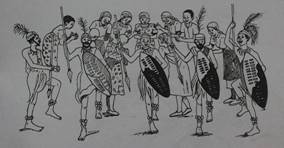
OCCASIONS WHEN DANCES ARE PERFORMED
- weddings
- funerals
- initiation ceremonies
- installation of chiefs
- political gatherings
- festivals
BENEFITS (IMPORTANCE) OF TRADITIONAL DANCES
- identity
- unifying people
- entertainment
TRADITIONAL DANCES AND THEIR ORIGINS
Dance ---- District of origin
Likhuba - - - Nsanje
Utse - - - Nsanje
Mganda - - -Dowa
Msindo - - - Ntcheu
Ingoma - - - Mzimba
Vimbuza - - - Chitipa
When these dances are created and performed by the learners, they may be referred to as educational dances
Educational dances are dances that are created and performed by the learners.
- UNIT 2 RHYTHMIC ACTIVITIES DEFINITIONS OF THE TERM RHYTHM
Rhythm is grouping of sounds and silences Or
Rhythm is grouping of actions and pauses
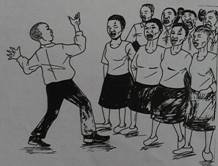
EXAMPLES OF RHYTHMS
- breathing
- heartbeat
- clock ticking
- walking
- singing
- pounding (e.g maize in a mortar)
IMPORTANCE OF RHYTHMIC PATTERNS (RHYTHM IN DANCE)
- assist in setting uniformity
- assist in setting order
MIRRORING ACTIVITIES
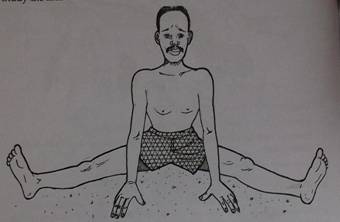 Mirroring activities are activities in which you imitate (follow) a leader. The main purpose of mirroring is to make the activities easy to learn
Mirroring activities are activities in which you imitate (follow) a leader. The main purpose of mirroring is to make the activities easy to learn
EXAMPLES OF MIRRORING ACTIVITIES
- aerobics (majowajowa)
- swimming
- running
- knees up
- body stretching
VALUES OF MIRRORING ACTIVITIES
- promoting discipline
- promoting attention
- promoting unity
- helping in body coordination
- helping in body flexibility
UNIT 3 SELF EXPRESSION
People use various ways to express and communicate feelings and ideas.
WAYS OF EXPRESSING AND COMMUNICATING FEELINGS AND IDEAS
- language
- gestures
- writing
- use of artworks
- performances
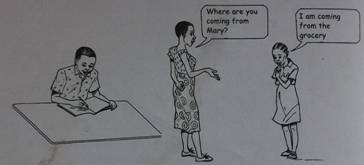
CATEGORIES (FORMS) OF COMMUNICATION AND EXPRESSION
- verbal communication
- non-verbal communication
Verbal communication is usually through language which is culture specific.
Both verbal and non-verbal forms of communication are learned informally during early childhood. Some forms of non-verbal communication convey different messages in different societies.
For example, shaking the head in Malawi may show disapproval where as in India shaking the head in the same way may show approval.
VERBAL AND NON-VERBAL FORMS OF ARTWORK
Verbal communication is communication which uses words
Non-verbal communication is communication which does not use words (communication is through signs and gestures)
ARTWORKS WHICH CAN BE USED TO EXPRESS AND COMMUNICATE FEELINGS, IDEAS AND CONCEPTS
- songs
- drama
- martial arts
- drawings
- posters
The spoken words are the verbal part while gestures are non-verbal forms of artworks.
Drawings and posters are purely non-verbal forms of communication.
Songs, drama and martial arts can be used as both verbal and non-verbal forms of artworks.
IMPORTANCE (EFFECTIVENESS) OF USING VERBAL AND NON-VERBAL FORMS OF COMMUNICATING AND EXPRESSING
Ideas which are difficult to be understood when just said are clarified through gestures, demonstrations and other activities.
THE ADVANTAGES OF USING ARTWORK
- some feelings, ideas and concepts can be well understood
- ideas are clarified
- some concepts can be communicated effectively
- some concepts, ideas and feelings can be communicated efficiently
THE DISADVANTAGES OF USING ARTWORK
- some feelings, ideas and concepts are difficult to communicate through artwork
- communication by artwork can be misconstrued (misinterpreted)
UNIT 4 IMPROVING THE QUALITY OF EVERYDAY LIFE HEALTHY LIFESTYLES
Everyday life is meaningful to individuals, families and communities if efforts are made to improve its quality. A bathing shelter and sun tables are some of the provisions
WAYS OF MAKING A PERSON'S LIFE BETTER
- eating balanced meals
- regular physical exercises
- having enough rest
- bathing regularly
- keeping home surroundings clean
CONSTRUCTING A BATH SHELTER

MATERIALS FOR CONSTRUCTING A BATH SHELTER
- 9 straight poles 2.5 metres long
- 3 long bamboos cut into strips
- adequate grass
- sisal or bark straps for tying
- 1 hoe
- adequate crushed stones
- meter rulers
PROCEDURE FOR CONSTRUCTING A BATH SHELTER
- measure the position of the bath shelter (2m x 1.5m)
- mark out positions for positioning poles
- dig holes one foot deep and fit in the poles firmly
- fix three rows of bamboos strips using sisal
- place grass and work round the frame using remaining bamboo strips and sisal to hold the grass in the middle
- level the inner bathing areas with crushed stones
- make a small drain leading away from the bath shelter
CONSTRUCTING A SUN TABLE
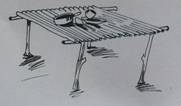
MATERIALS FOR CONSTRUCTING A SUN TABLE
- 4 Y-shaped strong poles 1.5 meters long
- sisal strings
- 20 straight 1 metre long sticks
- 2 (1.7 metre) long sticks
- adequate medium sized stones
PROCEDURE FOR CONSTRUCTING A SUN TABLE
- identify a flat area and measure the position of the sun table 1 x 1.5m
- measure a 0.75 and 0.5 metre area inside the first area
- dig out this space 5cm deep
- dig out holes 25cm deep on the four corners of the outer stretch
- place Y-shaped poles in the holes. Make sure that the Ys face each other. Fill the holes firmly
- place one 1.7 meter stick in the Y-shaped poles facing each other
- place the 1 metre sticks over the two bars
- tie tightly and place closely to the end
- fill the inner hole with stones
SINGING SONGS ON HEALTHY LIVING
It is important to compose songs on healthy living to help improve the quality of life in the community.
THEMES ON HEALTHY LIVING
- prevention of diseases
- eating balanced food
- resting
- hygiene
- environmental protection
CONSERVING THE ENVIRONMENT
The environment is a resource that enhances many artistic activities such as carving, weaving, plaiting, modelling and construction of bath shelters.
However, the level of environmental degradation has reached an alarming proportion.
People have cut down trees for charcoal production and curio making without replacing them.
In addition some of these artistic activities have resulted into land degradation, air pollution, and water pollution.
It is important to conserve the environment.
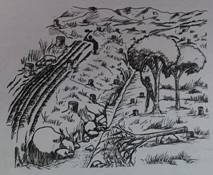
WAYS OF CONSERVING THE ENVIRONMENT
- making flower beds
- planting flowers
- planting tress
- planting lawn
- sweeping the surroundings
- slashing any tall grass
- proper disposing waste (using dustbins and rubbish pits)
- using pulp and plastine when modelling instead of using clay
- avoiding collecting clay for modelling from the same place
EFFECTS OF ENVIRONMENTAL DEGRADATION
- land degradation
- air pollution
- water pollution
IMPORTANCE OF CONSERVING THE ENVIRONMENT
- improves health of people
- adds beauty
- protects the environment
UNIT 5 CREATIVITY
Malawi is experiencing various problems related to HIV and AIDS, gender, child labour, child abuse and environmental degradation.
These problems are commonly known as cross-cutting issues because they affect a cross section of people in the society.
Various artistic activities such as songs, dances and drama can be used to pass messages on these cross- cutting issues.
CROSS-CUTTING ISSUES
Cross-cutting issues are challenges that affect a cross section of people in the society
EXAMPLES OF CROSS-CUTTING ISSUES
- HIV and AIDS
- gender
- democracy
- corruption
- child labour and abuse
- environmental degradation
- human rights violations
CAUSES OF CROSS-CUTTING ISSUES
- lack of knowledge
- misappropriation of resources
- misuse of natural resources
- misuse of human resources
- misuse of financial resources
EFFECTS OF CROSS-CUTTING ISSUES
- environmental degradation
- dissatisfaction of one gender
- wide-range poverty
- illiteracy
- violence
- lawlessness and disorderliness in the society
COMPOSING SONGS ON CROSS-CUTTING ISSUES
Songs are powerful tools for passing on messages on cross-cutting issues because they both entertain and educate.
DRAMATISING SCENES ON CROSS-CUTTING ISSUES
Dramas are powerful tools for passing on messages on cross-cutting issues because they both entertain and educate.
DRAWING POSTERS ON CROSS-CUTTING ISSUES
Posters are also effective in communicating messages on cross-cutting issues because if well drawn and put at strategic places, they easily catch the eye of people and they can get the message from the posters.
IMPORTANCE OF POSTERS IN PLACES (SUCH AS HOSPITALS, ALONG THE ROAD, EDUCATIONAL INSTITUTIONS AND OFFICES)
- posters can be a quick way of passing important information.
- posters can pass information by using only pictures or drawings
- posters can use few words to pass very important messages
- posters can pass information to even very busy persons when they are pasted(pinned) at strategic places
- posters can pass information even to uneducated persons
- posters are a cheap way of disseminating information
- posters grip the attention of people to look at them
UNIT 6 ARTISTIC SKILLS
Various activities that we do in our everyday lives require skills.
Artistic activities like sports, games, making musical instruments, decorating the home, playing musical instruments and producing artistic items require skills.
VARIOUS SPORTS AND GAMES
- football
- netball
- athletics
- hockey
- relay race
- tennis
- boxing
- wrestling
TWO TYPES OF SPORTS
- Team sports
- individual sports
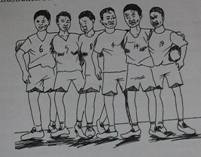
REASONS WHY SPORTS AND GAMES ARE PLAYED
- for enjoyment
- for fun
- for good health
- for socialization
- for competition
SOME COMMON TEAM SPORTS
- football/soccer
- netball
- basketball
- volleyball
- handball
- hockey
IMPORTANCE OF TEAM SPORTS
- encourage cooperation
- encourages unity
- encourages team spirit
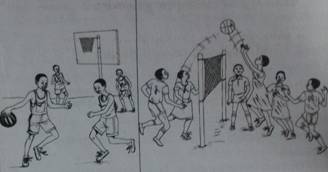
RELEVANCE OF TEAM SPORTS IN SCHOOLS
- fosters leadership skills
- encourages discipline
- reduces school drop out
- promotes sense of belonging
SOME COMMON INDIVIDUAL SPORTS
- golf
- chess
- table tennis
- swimming
BASIC RULES OF VARIOUS TEAM SPORTS AND GAMES
- VOLLEYBALL
- The first team to reach 25 points and by at least two points wins the set.
- The ball can be hit up to three times per side (in addition to blocking) before it must go over the net. A fourth hit is not allowed.
- If two or more teammates contact the ball simultaneously, it is considered one play. Neither player, however, may touch the ball again until another teammate touches it.
- A volleyball player can serve underhand or over hand, but can't step over the end line until after contacting the ball. The serve (or any volleyball hit) can graze the net as it goes over the net.
- The volleyball serve must first be hit by the opposing team with a bump, or underarm pass, before it can be hit with a set, block or attacking shot.
- A team will rotate one spot in a clockwise manner each time it regains the volleyball serve from the opposing team.
- The volleyball can be played off the net on a serve or during a volley.
- A volleyball player can't reach over the net except on a follow-through or to make a block (and only after the opponent contacts the ball). A player's body can go under the net as long as it doesn't interfere with the opposing team.
- Players can switch positions during a rally.
- The ball is in play if it lands on a sideline or end line.
- BASKETBALL
- Two teams each have up to five players on the court at one time.
- Teams score by shooting the basketball through the hoop.
- Each team tries to prevent their opponent from scoring by either stealing the ball or blocking an attempted shot.
- The ball is moved down the court by either passing it to a teammate or dribbling it.
- The game begins with two opposing players in the center circle, each jumping to tip the basketball that the referee tosses up. The team that does not gain the tip-off gains the possession arrow and will be awarded the basketball the next time it is tied up between opposing players. The teams will switch off with the possession arrow on every jump ball situation or at the beginning of a quarter or half. A jump ball will only be used again at the start of an overtime period. The possession arrow will be used during overtime periods.
- A dribbler can’t travel by walking or running with the ball more than 1 and half steps
- Nobody can enter the foul lane on a free throw until the ball hits the rim.
- NETBALL
- You cannot travel with the ball.
- There are only 7 players on the court from each team at all times unless a player has been sent off by the referee
- You cannot snatch or hit the ball out of a player's hands. This is called contact. You must stand beside the player until the ball has been left the player's hands.
- When defending the ball, you must stand 3 feet away from the person with the ball.
- Players cannot hold the ball for more than 3 seconds. This includes throwing it the air, no-one else touches it and you catch it again.
- Players are not allowed to move into the areas that they are not designated to
- When the defence in the circle are called up by the referee, they have to stand beside the shooter.
- The shooter has the decision of shooting the ball or passing the ball.
- When the ball goes out of court, the team who last touched the ball hands the ball over to the opposing team. They have 3 seconds to stand outside of the court at the line where it went out and pass the ball.
THE IMPORTANCE OF THE RULES IN SPORTS AND GAMES
- observing honesty
- maintaining discipline during the entire play time
- reducing body injuries to players
- avoiding unnecessary conflicts
- maintaining integrity
- encouraging fair play
WHO OFFICIATES SOME SPORTS AND GAMES
An official is a person who makes sure that all the agreed rules are followed
- FOOTBALL
Referee
Assisted by two assistant referees
- NETBALL
Umpire
- ATHLETICS
Starter
Assisted by field marshal and track judge
- BASKETBALL
Referee
IMPROVING THE HOME
Homes play an important role in people's lives because most of our time is spent at home.
Activities that take place should therefore provide a healthy and happy life for an individual and the entire household.
It is therefore important to acquire basic skills in cleaning, beautifying and practicing economical use of resources at home to improve lives.
SOME WAYS OF IMPROVING THE HOME
- producing chair backs
- producing table mats
- producing wall hangings
- producing paintings
- producing drawings or pictures
ITEMS USED FOR IMPROVING THE HOME
- chair backs
- table mats
- wall hangings
- paintings
- drawings
- pictures
LOCAL MUSICAL INSTRUMENTS
Musical instruments play an important role in music. They help to make music more pleasant.
TWO MAJOR GROUPS (CLASSES) OF MUSICAL INSTRUMENTS
- TUNED MUSICAL INSTRUMENTS
Tuned musical instruments are those which when played produce two or more pitches. This group has all instruments which are stringed and produce sound by plucking.
Examples are banjo, bangwe, kaligo, and guitar.
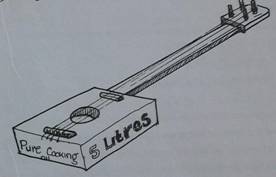
- UNTUNED MUSICAL INSTRUMENTS
Untuned musical instruments are those which have one fixed pitch.
Examples in this group include drums, hoe blades, mkangala, shakers, nkhwendo, wood blocks and clapping hands.
These are also called percussion musical instruments.

- SIMPLE MUSICAL INSTRUMENTS
- shakers
- visekese
- mkangala
- nkhwendo
- drums
- banjos
- acoustic guitars
The simple musical instruments can be made from local materials.
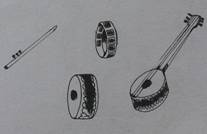
- SOPHISTICATED MUSICAL INSTRUMENTS
- electric guitar
- accordion
- trumpet
- saxophone
- piano
HOW SOME MUSICAL INSTRUMENTS ARE PLAYED
- plucking
- beating
- blowing
- shaking
- stroking
- clicking
- striking
- rubbing
SOME MATERIALS FOR MAKING MUSICAL INSTRUMENTS
- animal hide
- wood blocks
- strings
- nails
- gallons
- tree trunk
- stones
- animal bones
- sticks
- reed
- bamboos
- plastic papers
UNIT 7 MEANS OF COMMUNICATION
Communication is passing on of information from one person to another.
Where there is no proper communication, problems may arise due to misunderstandings. Means of communication are in different forms. These include:
- use of instruments
- sending of envoys
- dressing of some kind
Some of the instruments used for expressing and communicating include:
- horns of different animals
- drums of different sizes
- gongs
- bells
For example, in some societies, announcement of beer is made through a gong which is sounded early in the morning.
The same method is also used in death announcement.
In the past, trumpets were also used to announce victory at war or the coming of enemies into the land.
In some societies, envoys are sent to convey messages of different kinds.
For example, among the Chewa;
- When one brings a white chicken to a chief it means accepting an offence committed
- When one brings a black chicken to a chief it means one has brought a funeral message
In the Bible when something went wrong, the people could wear a sack cloth and smear ashes on the body.
In modern times a widow wears black cloth to show that she has lost a husband.
People also wear rings on certain fingers to communicate that they are either engaged or married.
TRADITIONAL MEANS OF COMMUNICATION
- blowing horns
- hitting gongs
- wearing certain cloth
- beating drums
- mouth whistling
- clapping hands
- writing letters
- singing songs
- telling stories
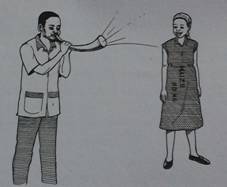
MODERN MEANS OF COMMUNICATION
- through electronic mail (email)
- through telecommunication e.g. telephone and mobile phone
- through sirens
- through mass media e.g. radio, newspaper, internet
- through books
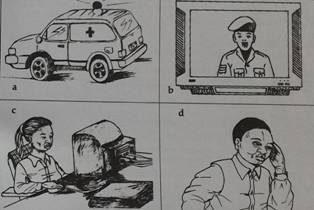
MODERN TECHONOLOGIES OF COMMUNICATION
- phones
- computers
- radios
- newspapers
- books
WAYS PEOPLE COMMUNICATE WITH EACH OTHER IN DISTANT PLACES
- phones
- faxes
- emails
- SMS (short message services)
- letters
- internet
- television
- radio
- newspapers
CULTURE AND COMMUNICATION
Various art forms are used in different cultures to mean different things.
VARIOUS ART FORMS USED IN DIFFERENT CULTURES
- colour
- patterns
- symbols
- designs
- sounds
For example, in China red colour stands for wedding In Malawi red colour is a sign for danger.
In Malawi and America white colour is for wedding.
Various communities have specific patterns and designs which are used to mean different things. For example tattoos (mphini) on human faces are for beautification.
A combination of various decorative patterns are used to produce various designs of products such as hat making.
There are certain sounds, symbols and signs that convey meanings to people.
For example, a cock crowing at night indicates dawn is approaching while the hooting of an own at night is believed to indicate a bad omen.
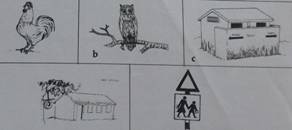
Some symbols indicate an identity of a person or an institution.
For example, a cross on an institution may show that it is a church while a crescent may show that it is a mosque.
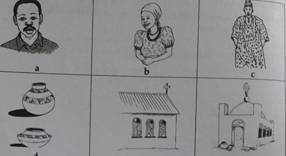
Certain colours have a cultural bearing.
For example, a white flag on a roof or tree indicates a wedding in some societies.

MALAWIAN NATIONAL FLAG COLOURS AND THEIR MEANINGS
THE IMPACT OF TECHNOLOGY IN EXPRESSING AND COMMUNICATING
Modern technology has both good effects and bad effects on people's lives.
GOOD EFFECTS OF MODERN TECHNOLOGY ON THE PEOPLE
- it has improved speed of doing things
- people can travel long distances within a short time
- Modern technology has made it possible for people learn formal education through online (i.e. using internet)
- It is possible to communicate with a friend who is far away within a short period of time.
- it has made it easy and safe to transfer/send money from one person to another
BAD EFFECTS OF MODERN TECHNOLOGY ON THE PEOPLE
- there is no restriction on what should be viewed on television or the internet
- internet is flooded with pornographic materials that can spoil people's minds
- interaction between and among people reduces where people glue to the TV screens and talk less
- it has brought in cyber crime
- television programmes can also influence the youths negatively
- it has increased instances of bad experiences of pedophiles
UNIT 8 OUTDOOR ACTIVITIES
Outdoor activities are educational experiences planned by the teacher to enable the learners gain a complete understanding and appreciation of their environment.
PHYSICAL AND CULTURAL ACTIVITIES AND ARTWORKS IN THE COMMUNITY
There are various physical, cultural and artworks done in the community. Some of these artworks are produced through:
- painting
- carving
- weaving
- modelling
Cultural activities in the community may include:
- traditional dances
- rites of passage ceremonies
Physical activities include:
- swimming
- nature exploration
- mountain climbing
THE IMPORTANCE OF PHYSICAL AND CULTURAL ACTIVITIES AND ARTWORKS IN THE COMMUNITY
The various physical, cultural activities and artworks found in the communities are of great significance.
- Physical activities
- improve the health of members of the community
- increase the people's perspective of the world
- Cultural activities
- give an identity to the communities
- fosters interaction among community members
- increase sense of belonging
- Artifacts or artworks
- are a source of income
- attract tourists
UNIT 9 INTERPRETATION OF ARTWORKS
Traditional dances, songs and modelled items depicting culture are some of the examples of artworks in Malawi.
Some of these artworks have cultural significance or messages which require interpretation.
The songs and dances convey different messages, and the modelled items depict culture of the society. The songs and dances are performed in different situations for different purposes.
OCCASIONS/SITUATIONS WHEN SONGS AND DANCES ARE PERFORMED
- wedding ceremonies
- initiation ceremonies
- installation of chiefs
- funeral ceremonies
- festivals
- community gatherings
- political gatherings
PURPOSES FOR PERFORMING SONGS AND DANCES
- entertainment
- healing
- inducing ancestral spirits
- competition
- advising
- rebuking for bad behaviour
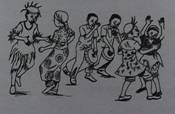
FAMILIAR TRADITIONAL DANCES
- gulewamkulu
- manganje
- tchopa
- vimbuza
- malipenga
- beni
- likwata
- jiri
- uyeni
- chinamwali
- mganda
ART ITEMS SHOWING CULTURAL HERITAGE
People can describe art items found in different areas according to their appearance, shape and decorations.
-
Some art items are associated with a specific group of people, for example, previously each group of people had their own style of modelling and decorating household items.
Culture changes with time, there have also been some changes in the way people make their art items today.SOME COMMON ART ITEMS WHICH DEPICT CULTURE
- carved items
- woven items
- plaited items
- modelled items
Once the items are produced, the learners must attach value to them and be able to mock sell them. The reasons for doing this are:
- To show to the learners that they can earn a living from the art products
- To create a spirit of excellence in the learners
UNIT 10 ARTISTIC PERFORMANCE
Artistic performances are aimed at educating and entertaining the audience.
REASONS FOR DOING ARTISTIC PERFORMANCE
- part of exercises
- form of competition
- educating
- entertaining
- informing
SOME ARTISTIC PERFORMANCES
- drama
- dance
- music
- physical exercises
- sports
- poetry
Performers usually wear appropriate attire to suit the kind of performance. An attire makes the performers look attractive and easily identified
DRAMA STORY LINES
Drama is the performance that aims at educating the audience in an entertaining way. Before drama performance, one has to write story lines and propose actors and actresses.
People who perform in drama are called actors when they are men, and actresses when they are women.
These actors and actresses are characters in the play.The story itself is called a plot and it is divided into acts and scenes.
An act is a larger segment of a plot which is sub-divided into scene (smaller segments). Scene is the smaller segment of a plot.
Story lines may depict different issues.However, a good story in a play leaves the audience in suspense up to the end and teaches a moral lesson.
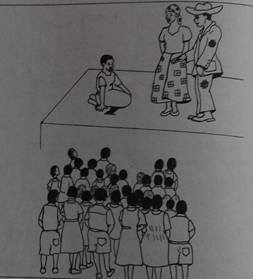
DEVELOPING STORY LINES ON CROSS-CUTTING ISSUESSome cross-cutting issues are:
- HIV and AIDS
- environmental degradation
- pollution
- corruption
- human rights violation
- gender
PRODUCING ATTIRE FOR SPORTS, DANCE AND DRAMA
Performer usually wear appropriate attire to suit the kind of performance.
For example in drama, actors and actresses usually act out different roles. As such they wear attire to portray the character or role they represent.
Likewise in sporting activities, performers have sportswear that suit the type of sport. In dances, the dancers usually wear different kinds of attire that go with the dance.
Some attire can simply be bought or improvised.MATERIALS FOR MAKING ATTIRE FOR DRAMA, SPORTS AND DANCE
- cotton fabric
- pair of scissors
- sewing thread
- embroidery thread
- old clothes
- razor blades
- palm leaves
- banana leaves
- ropes
- elastic
- pins
- paper patterns
REASONS FOR WEARING SPECIAL ATTIRE WHEN DOING PHYSICAL EDUCATION, SPORTS, DANCES AND DRAMA
- To make the performance exciting
- To enable performers perform freely
- To identify themselves
UNIT 11 DECORATIVE ARTWORKS
There are many things that are done in our life to express feelings and emotions in an artistic way.
for example, although a dance may have specific dancing patterns, you will always see that while some are following the patterns prescribed (said/told), others still add some gestures or movements to make their dancing unique, beautiful and attractive.
To achieve this beauty, dancers may use facial expressions or exaggerated movements. All such things constitute what is known as aesthetics.
AESTHETIC ARTWORKS
In music, there are many things or symbols that are used to make the singing more interesting.
Things such as dynamics assist to create beauty and reduce monotony. Dynamics refers to the loudness and softness of sound.
Usually there are various symbols that are used in music to show these dynamics.
This symbol is called a crescendo and it means getting louder

This symbol is called a decrescendo and it means getting softer

This symbol is called a fermata and it means holding the sound of the note for sometime
p
this symbol is called a piano and it means singing softly
pp
this symbol is called a pianissimo and it means singing very softly
mp
this symbol is called a mezzo piano and it means singing moderately soft
mf
this symbol is called a mezzo forte and it means singing moderately loud
f
this symbol is called a forte and it means singing loudly
ff
this symbol is called a fortissimo and it means singing very loudly
Another important element of music which assists to add the beauty of the song is tempo. A song sounds beautiful when it changes speed at various intervals.
This also helps to avoid boredom
DECORATIVE PATTERNS
There are different ways of decorating artworks.
WAYS OF DECORATING ARTWORKS
- tattooing
- engraving
- stamping
- impressing
- polishing
- colouring
- coiling
- incising
- staining
- blending with iron oxide
- burning using a hot metal rod or wire
- Appliqueing
The importance of decorating artworks is that the decorated artworks look attractive and sell easily. You can sew a simple applique on a cloth to make it attractive.
You can use hexagonal woven strips or diagonal woven strips when weaving a mat or carpet to come up with a desired pattern.
You can decorate a pot or a flower vase by tattooing or engraving, stamping or impressing, polishing and colouring.SEWING A SIMPLE APPLIQUE
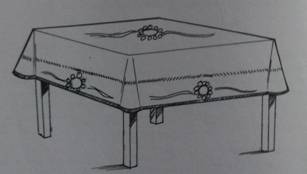
An applique is ornamental needlework in which pieces of fabric in different shapes and patterns are sewn or stuck onto a larger piece to form a picture or pattern
orApplique is the technique of stitching small pieces of fabric onto a larger piece to create a design.
Appliques can be pre-cut or trimmed in place
You can decorate your jeans using applique, sewing flowers and stars on them.
or
Applique is a sewing technique that involves stitching a small piece of fabric onto a larger one to make a pattern or design.
orApplique is an ornamentation, as a cut out, that is sewn on to or otherwise applied to a piece of material
MATERIALS FOR SEWING A SIMPLE APPLIQUE
- cloth
- sewing needles
- sewing thread
- pairs of scissors
DECORATING POTS AND VASES
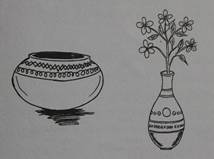
MATERIALS FOR WEAVING AND DECORATING MATS, BROOMS AND CARPETS- palm leaves
- banana leaves
- knife
- dyes
- water
- sewing needles
- thread
- bucket
MATERIALS FOR DECORATING POTS AND VASES
- clay
- pebbles
- old spoons
- shells
- mango seeds
- water
- old baskets
- sisal
- brush
- bones
- wire
- a knife
- fingers
- wood or metal stamps
UNIT 12 HOME MAKING
Home making is certainly an art.
For the home to be comfortable there is need to purchase household items.
Some people try to make their homes comfortable by purchasing very expensive household items. Others may not have enough money to spend on luxury household items.
What such people do is to make the items for themselves and the surplus is sold.PRODUCING AND MARKETING HOUSEHOLD ITEMS
Various household items are made from raw materials found in the locality. These are utensils and articles for everyday use in the home.
Clay and wood can be used to model and carve items like pots, mortar, wooden spoons, cooking sticks and pestles.
Some embroidered items like chair backs can also be made.Clay items should be dried in a shed as direct sunshine causes them to crack.
Wooden items should not be exposed to moisture for fear that they may expand and crack.
CARVING HOUSEHOLD ITEMS
Household items that can be produced through carving include:- wooden spoons
- cooking sticks
- mortars
- pestles
- clubs
- wooden clutches
SOME MATERIALS FOR CARVING HOUSEHOLD ITEMS
- wood blocks
- panga knives
- sandpaper
- an adze axe
- glass
- stones
MODELLING HOUSEHOLD ITEMS
The following are some of the household items that can be produced by modelling:- cooking pot
- spoons
- a mortar
- a bucket
- a pestle
- plates
- Saucers
MATERIALS FOR MODELLING HUSEHOLD ITEMS
- clay
- grass
- wood
- stone
- leaves
HOME RECREATION
There are a number of items that can be made locally to improve the home. When these materials are artistically made, they can be sold at the marketsCOSTING AND LABELLING ITEMS MADE
Marketing is a skill that requires the ability to price, label, display and advertise. Usually customers bargain for a better price.
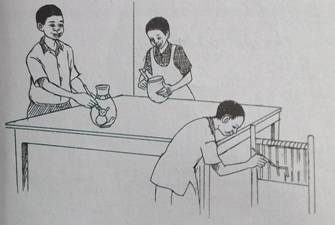
It is important for a seller to exercise customer care through patience and tolerance.
FACTORS TO CONSIDER WHEN COSTING PRODUCTS/ITEMS- Amount of materials used
- Time spent in making the item/product
- Attractiveness of the finished product
- Age group meant for the item
- Availability of the product
- Durability of the product
- Quality of the material
- Demand
- Cost of the materials, if bought
WAYS OF MARKETING VARIOUS ITEMS/PRODUCTS
The following are some of the ways of marketing products that have been drawn, woven, carved, modelled and so forth:- Advertising
- Making a display of finished products
- Organizing a showcase
SOME OF THE ITEMS THAT CAN BE MADE IN THE HOME AND SOLD
- chair backs
- wooden spoons
- cooking sticks
- brooms
- clay pots
- flower vases
- mortars
- pestles
REFERENCES
Standard 6 Teacher’s Guide Standard 6 Learner’s Book
Longhorn, New Horizon, Social Environmental Sciences, Primary School, Atlas, Malawi The internet
UNIT 2 THE MAJOR PHYSICAL FEATURES OF MALAWI
UNIT 3 THE POPULATION OF MALAWI
UNIT 4 THE POPULATION DENSITY OF MALAWI
UNIT 5 POPULATION CHANGE IN MALAWI
UNIT 7 EARLY AFRICAN KINGDOMS: THE NGONI
UNIT 8 EARLY AFRICAN KINGDOMS: THE MWENEMUTAPA
UNIT 15 FARMING AND FISHING IN MALAWI
UNIT 17 DRUG AND SUBSTANCE ABUSE
UNIT 20 SOCIAL SERVICES IN MALAWI
UNIT 22 MINING AND MANUFACTURING
UNIT 24 TRANSPORT AND COMMUNICATION IN MALAWI
GLOSSARY
UNIT 1 THE LOCATION OF MALAWI WRITTEN BY ZIKOMO MASESE BANDA
COUNTRIES THAT SHARE BORDERS WITH MALAWI
- There are many countries in Africa.
- Malawi is one of them.
- It is surrounded by Mozambique, Tanzania and Zambia.
- This makes it a landlocked country.
- A landlocked country is a country surrounded by other countries.
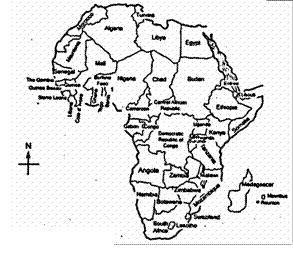
LOCATING MALAWI USING THE CARDINAL POINTS
Malawi is located in the southern part of Africa. Tanzania is to the north and north-east of Malawi.
Zambia lies to the west and Mozambique to the south-west, south and east of Malawi.
UNIT 2 THE MAJOR PHYSICAL FEATURES OF MALAWI
Physical features are natural features of the earth’s surface such as hills, mountains, valleys, lowlands, lakes and rivers.
Or
Physical features are landforms and drainage.
A MAP OF MALAWI SHOWING MAJOR PHYSICAL FEATURES
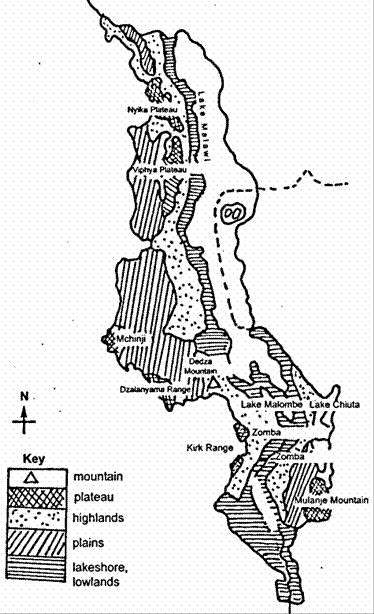
THE MAJOR PHYSICAL FEATURES OF MALAWI
- Highlands
The major highlands in Malawi include mountains, plateaus and ranges.
Major mountains of Malawi are Mulanje in the southern region and Dedza in the central region. Major mountains ranges are Dzalanyama and Kirk Range in the central region.
Plateaus are Zomba and Mulanje in the southern region and Viphya and Nyika in the northern region.
- Plains
The major plains in Malawi include Lilongwe, Mchinji and Kasungu Plains in the centre.
Phalombe Plains in the south.
Nkhamanga Plains in Rumphi and Mzimba in the north.
- Lowlands
The major lowlands in Malawi include lakeshore areas and the Shire Valley in the south.
- Lakes
The major lakes in Malawi are Lake Malawi, Lake Malombe, lake Chilwa and Lake Chiuta.
- Rivers
The major rivers are the Shire, Ruo, Mkulumadzi, Phalombe and Mwanza in the south. Bwanje, Linthipe, Lilongwe, Diamphwe, Bua and Dwangwa in the centre.
North Rukuru, South Rukuru and Kasitu in the north.
THE IMPORTANCE OF PHYSICAL FEATURES
Highlands
- Natural forests grow on them
- They provide a home for animals
- They are a source of rivers
- They beautify the country
- They encourage rainfall
Plains and lowlands
- They are good for farming activities
- People settle there
Lakes and rivers
- They are a home for fish and other water animals
- They provide water for domestic use
- They are a source of electricity
- They provide water for agricultural purposes such as irrigation
UNIT 3 THE POPULATION OF MALAWI
The term ‘population’ means the total number of people living in an area. Population distribution is the spreading of people over a given area.
According to the 1998 population census, the total population of Malawi was 9, 838, 486 However, the population is not evenly distributed.
Some districts and regions have higher populations while others have less.
POPULATION FIGURES OF THE THREE REGIONS
According to statistics found in the 1998 population census, southern region has the highest number of people followed by the central region. The northern region has the least number of people.
UNIT 4 THE POPULATION DENSITY OF MALAWI
Population density is the number of people per unit area.
Or
Population density is the number of people living per square kilometre.
AREAS OF HIGH AND LOW POPULATION DENSITY IN MALAWI
A place in which many people occupy a small area has a dense population. A place where a few people occupy a large area has a sparse population.
The areas of high population density are Blantyre, Thyolo, Mulanje, Chiradzulu, Phalombe, Zomba and Mangochi in the southern region.
Lilongwe, Dowa, Kasungu, Mchinji, Dedza and Salima in the central region. Areas of low population density are most of the districts in the northern region.
POPULATION DISTRIBUTION
Population distribution refers to how people are spread over an area or a country.
There are two aspects of population distribution. These are densely and sparsely populated areas.
Factors that influence densely population in southern region of Malawi
- Tea estates in Mulanje and Thyolo which attract many people who seek employment
- Fertile loam soils used for growing crops such as maize, beans, bananas and potatoes
- Reliable rainfall
- Trade and commerce and manufacturing industries found in Blantyre
- More towns and townships
- Educational facilities
- Fishing and water supply along the lake
- The sugar industry in Nchalo
Factors that influence dense population in central region of Malawi
- The capital city which has all government ministries and departments as well as some industries, trade and commerce
- Fertile loam soils favourable for the growth of tobacco, maize, groundnuts, potatoes and beans
- Many tobacco estates
- Fishing and water supply along the lake
Factors that influence sparse population in regions of Malawi
- Mountainous areas of Mulanje and Zomba, the Kirk Range and Dzalanyama Range, Viphya and Nyika plateaus
- National parks, game reserves and protected areas which include Nyika, Nkhotakota, Liwonde, Lengwe and Majete.
- Areas with poor soils and no or few industries.
EFFECTS OF HIGH AND LOW POPULATION DENSITY IN MALAWI
- Shortage of land for cultivation
- Depletion of natural resources such as forests, trees, fish and wildlife
- Severe soil erosion because of over cultivation and deforestation
- Shortage of social services such as schools, clinics and hospitals
- Overcrowding in schools
- Shortage of drugs
- Overcrowding in towns resulting into population
- Poverty, crime and prostitution in overcrowded areas and squatter areas
- Establishment of squatter or illegal settlements in urban areas
Areas with low population density may not experience the above effects on a large scale.
UNIT 5 POPULATION CHANGE IN MALAWI
Population change refers to the increase or decrease in population. Population increase is also called population growth.
A population may increase because of the following reasons:
- Belief in large families
- Preferring male children to female children
- Availability of health facilities
- Improved medical services
- Movement of people out of an area or movement of people into an area (migration)
Although Malawi has a high birth rate, the following are some of the factors that lead to population decrease:
- A high infant mortality rate and child mortality rate because not many people take children to health clinics for treatment of diseases
- Poor health facilities which have few or no doctors and drugs
- Poor nutrition
- Adoption of family planning methods by some families
EFFECTS OF POPULATION CHANGE
An increase in the population of an area may lead to:
- Shortage of land for settlements and cultivation
- Environmental damage
- Shortage of natural resources
- Shortage of social services
- Lowering of living standards of people
A decrease in population may lead to:
- Shortage of personnel needed to develop an area
- Availability of more land for settlements and farming in areas where people have moved out
- Availability of more space for social services
- Better standard of living
SOLUTIONS TO THE EFFECTS OF POPULATION CHANGE
- Adopt family planning methods
- Vaccinate or immunize children against diseases
- Improve nutrition
- Visit clinics and hospitals
- Attend health education campaigns
UNIT 6 LOCAL GOVERNMENT
Local government refers to the branch of government which has the decentralised function of the central government to local communities.
The local government supplements the services that are provided by the central government.
The local government is made up of a number of institutions that operate in the districts throughout the country.
These are referred to as assemblies. These include:
- District assemblies
- City assemblies
- Municipal assembly
- Town assemblies
FUNCTIONS OF LOCAL ASSEMBLIES
J Promoting democratic culture and participation among citizens
J Planning for development of infrastructure in a district
J Planning for economic development in a district
J Making by-laws
J Collaborating with other assemblies on issues of development
Every assembly is headed by a chairperson and a vice chairperson and serves for a period of five years. For cities and municipals, the heads are referred to as mayor and deputy mayor.
The assembly committee comprises voting members elected from each ward within the assembly area.
It is also composed of non-voting members such as traditional authorities, members of parliament and members of special interest groups, for example, non-governmental organisations (NGOs) and religious institutions.
In addition, each assembly employs a chief executive officer who is responsible for the day-to-day administrative matters of the assembly.
THE IMPORTANCE OF LOCAL GOVERNMENT SERVICES
- The provision of education
- Construction and maintenance of roads, bridges, footpaths, car parks and bus shelters
- Health services
- Promotion of public health
- Provision of emergency services
- Community development
- Provision of security
Most of the services are provided free but there are some which require people to pay.
The local government gets money to pay for the services by the following ways:
- Receiving money from the central government
- Collecting taxes on businesses
- Collecting taxes on land
- Service charges
- Obtaining loans
THE IMPORTANCE OF LOCAL GOVERNMENT INSTITUTIONS
- Provide services to all people
- Encourage more contact and participation by ordinary people in affairs that benefit them
- Facilitate speedy responses from government on development issues
- Promote transparency, accountability and good governance
UNIT 7 EARLY AFRICAN KINGDOMS THE NGONI
The Ngoni were very powerful warriors who came from Zululand in South Africa. They left South Africa in the 1930s.
They fled from Tchaka Zulu, a powerful and cruel king.
They were led by Zwangendaba who died in Maputo in Tanzania.
He was succeeded by his son Mbelwa who led the Ngoni to Malawi and settled in Mzimba. Another group of the Ngoni settled in the central region.
These were led by Ngwane Maseko and later split and settled in various places.
These include:
- The Ngoni of Dedza under Kachindamoto.
- The Ngoni of Lizulu in Ntcheu under Gomani Chikuse
- The Ngoni of Dowa under Chiwere
- The Ngoni of Mwanza
- The Ngoni of Bvumbwe in Thyolo
These people were looking for grazing land and water for their livestock.
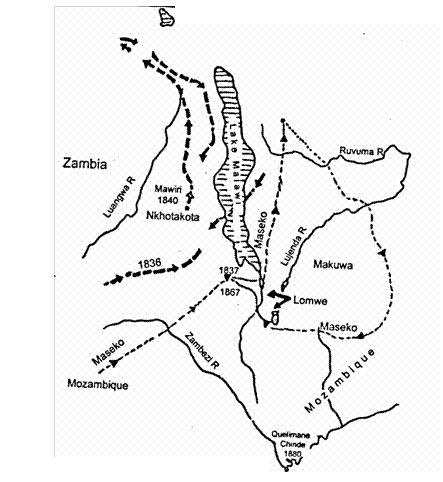
A MAP OF SOUTHERN AFRICAN SHOWING THE MIGRATION ROUTES OF THE NGONI
FACTORS THAT LED TO THE GROWTH OF THE NGONI KINGDOM
- Political organisation
- Military organisation
- Cattle keeping
THE ADMINISTRATIVE STRUCTURE OF THE NGONI KINGDOM
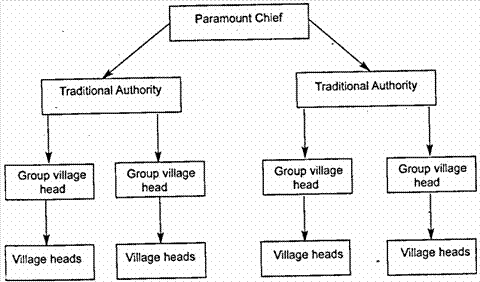
FACTORS THAT LED TO THE DECLINE OF THE NGONI KINGDOM IN MALAWI
- Tribal wars
- competition for leadership
- Missionary intervention
- The death of a strong leader
THE CONTRIBUTIONS OF THE NGONI KINGDOM
- Traditional dances
- The lobola system of marriage
- Patrilineal system of marriage
- Dressing
- Language
- The spirit of solidarity
UNIT 8 EARLY AFRICAN KINGDOMS MWENEMUTAPA KINGDOM
The Mwenemutapa kingdom was founded by Nyatsimba Mutota by 1450. Mwenemutapa Kingdom had Great Zimbabwe as its capital.
The people of the Mwenemutapa Kingdom were the Karanga who spoke the Shona language.
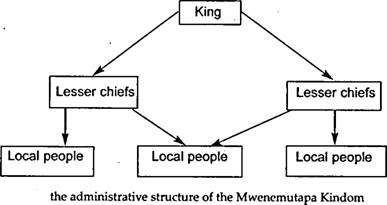
Their king was Mambo.
He was regarded as a living god and was represented by fire. He had lesser kings who ruled in other lands on his behalf.
Mwari was the most powerful god in Mwenemutapa Kingdom.
THE FACTORS THAT LED TO THE GROWTH OF MWENEMUTAPA KINGDOM
- Military organisation
- Political organisation
- Trade in gold, silver and copper
THE FACTORS THAT LED TO THE DECLINE OF MWENEMUTAPA KINGDOM
- Lesser kings fought for their independence
- Interference of the Portuguese in the running of the kingdom
- Invasions from its enemies
THE CONTRIBUTIONS OF THE MWENEMUTAPA KINGDOM
- Stone buildings
- Use of iron tools
- Trade with other nations
- Belief in one god called Mwari
UNIT 9 HIV AND AIDS
H |
stands for |
Human |
I |
stands for |
Immunodeficiency |
V |
stands for |
Virus |
AIDS is a medical term for a combination of illnesses that result from specific weakness of the body’s immune system.
A |
stands for |
Acquired |
I |
stands for |
Immuno |
D |
stands for |
Deficiency |
S |
stands for |
Syndrome |
TRANSMISSION OF HIV AND AIDS
- Having unprotected sexual intercourse with an infected one
- Infected blood entering the body through blood transfusion, syringes, needles or other cutting objects
- Infected persons to unborn child (mother-to-child transmission)
- Breastfeeding
RISKY BEHAVIOURS ASSOCIATED WITH THE SPREAD OF HIV AND AIDS
- Prostitution
- Drug and substance abuse
- Promiscuity
- Cultural beliefs and practices
- Working away from home for a long time
MISCONCEPTIONS ABOUT HIV AND AIDS
- AIDS can be cured by having sexual intercourse with virgins
- Mosquitoes transmit HIV
- ARVs cure HIV and AIDS
- You cannot contract HIV if you have sex with a person with a disability
- Some herbs can cure HIV and AIDS
- You can get HIV by living with one infected with HIV
- You can get HIV by sharing food with one infected with HIV
- You can get HIV by shaking hands with one infected with HIV
- You can get HIV through sneezing or coughing
SIGNS AND SYMPTOMS OF AIDS
Minor signs
- Coughing for more than a month
- Itchy skin diseases
- Shingles (herpes zoster)
- Sores all over the body
- Thrush in the mouth and throat (oral candidiasis)
- Long lasting swollen glands
- Loss of hair texture
- Tuberculosis
- Night sweats
Major signs
- Weight loss greater than 10% of the body weight
- Fever for longer than one month
- Diarrhoea for longer than one month
- Persistent severe fatigue (tiredness)
- Loss of memory
- Repeated abscesses
However, these signs and symptoms can be an indication of another disease. Only a blood test can prove whether a person is HIV-positive or HIV-negative
WAYS OF PREVENTING THE SPREAD OF HIV AND AIDS
- Abstinence
- Being faithful to one’s sexual partner
- Condom use
- Avoiding exposure to blood
- Avoiding harmful cultural practices that promote the spread of HIV and AIDS
- Joining clubs to learn more about HIV and AIDS
THE IMPORTANCE OF VOLUNTARY COUNSELLING AND TESTING
- Knowing one’s body status on HIV
- Choosing the expected behaviour depending on the results
- Continuing to avoid contracting the virus if tested HIV-negative
- Receiving advice on how to cope with it if tested HIV-positive
The whole process comprising counselling and testing is called HIV Testing and Counselling (HTC) WAYS IN WHICH AN HIV-POSITIVE TESTED PERSON MAY COPE WITH THE STATUS
- Taking appropriate steps not to infect others
- Taking appropriate drugs to prevent transmission of the virus to the unborn baby if pregnant
- Eating food that has a balanced diet
UNIT 10 THE WEATHER OF MALAWI
WEATHER
Weather is the state of the atmosphere for a place for a short period of time.
The atmospheric condition of a particular day can be describe in different ways. A day can be described as hot, cold, dry, wet, cloudy, windy, and so forth.
THE ELEMENTS OF WEATHER
- temperature
- humidity
- air pressure
- rainfall
- wind direction
- wind speed
- cloud cover
- sunshine
AFFECTS OF THE ELEMENTS OF WEATHER
- flooding
- good harvest
- drought
- high rate of evaporation
- destruction of the environment
- discomfort
Flooding
Excessive rainfall can cause flooding, which in turn destroys crops, houses and leaves people homeless and without food.
Some roads and bridges may also become impassable because of floods.
Good harvest
Sufficient rainfall will have a positive effect on people's lives since they will harvest enough crops.
Drought
Insfficient rainfall will make people, animals and crops suffer because of shortage of water. This will lead to drought, and in turn, famine.
High rate of evaporation
Excessive sunshine will cause a high rate of evaporation in rivers and lakes and dry up. This affects the formation of rain and people suffer because of lack of water.
Water animals such as fish also suffer.
Destruction of the environment
Heavy winds cause great damage to buildings, crops and trees, and may even cause loss of lives
Discomfort
People feel uncomfortable because of high temperatures. Sometimes people develop diseases and animals eventually die. Low temperatures also affect people's lives in that if it is too cold, people feel uncomfortable and crops are also affected.
WAYS OF PREDICTING WEATHER CONDITIONS LOCALLY
- the springing of new leaves of trees
- sounds or songs some birds and insects
- the colour of the moon
- the surfacing of some small animals and plants
- atmospheric changes
- cloud types
THE IMPORTANCE OF PREDICTING WEATHER
- Farmers are able to decide on the agricultural activities they need to know, what to do, and the types of crops they can grow; when and where
- People will be able to plan for their daily activities, for example, when to do laundry, process flour, travel and not to travel
- People will decide on the type of clothes to wear.
- Pilots will be in a position to know how strong the wind is
- Teachers can plan their lessons according to the weather
INSTRUMENTS FOR MEASURING ELEMENTS OF WEATHER
The elements of weather can be measured using different instruments. An instrument is a tool used to measure something.
Some of the main elements of weather that are often measured are:
- air
- temperature
- rainfall
- wind speed
- wind direction
Most of the instruments used to measure weather are best kept in a special box called Stevenson’s screen.
Stevenson’s screen is designed in such a way that it allows free air movement and prevents the instruments from direct sunshine which can affect the readings of the instruments.
SOME OF THE INSTRUMENTS FOR MEASURING ELEMENTS OF WEATHER
- the rain gauge
- the thermometer
- the anemometer
- the wind sock
- the wind vane
- the weather cock
The rain gauge
Rainfall is measured in millimetres (mm).
An instrument used to measure rainfall is called the rain gauge.

A rain gauge
The rain gauge should be placed in an open area away from the trees and buildings and should also be raised to avoid water from other sources.
The wind sock
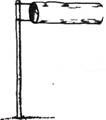
This is an instrument used for measuring wind direction.
The wind sock
A simple wind sock can be made using a cloth made into something like a bag which is tied to a pole. The cloth will be pointing to the direction the wind is going
The thermometer
Temperature is measured in degrees celsius (°C).

The thermometer
The instrument used for measuring temperature is called the thermometer. The thermometer will tell how hot or cold the place is.
In Malawi, the temperature in November is about 20°C while in June, it falls below 13°C.
The anemometer
Anemometer is measured by an Anemometer.
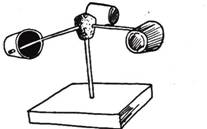
The Anemometer measures how much wind travels per hour.
The anemometer
The wind vane
This is an instrument for measuring wind direction.
A simple wind vane can be made from a simple light metal or piece of timber or cardboard mounted on a pole.

The pointer of the vane points in the direction where wind is coming from.
The wind vane
UNIT 11 THE CLIMATE OF MALAWI
Climate is the average weather condition of an area observed over a long period of time.
Climate has the same elements as weather.
This is because to collect information about climate and to prepare maps and graphs, the elements of weather are observed and measured in weather stations.
The climate of Malawi is tropical climate or Savannah.
It is called tropical climate because Malawi is within the tropics.
THE CHARACTERISTICS OF SAVANNAH OR TROPICAL CLIMATE
- wet and dry seasons
- heavy rains fall in summer
- the annual rainfall is about 762mm
- the summer is hot (around 320C)
- winters are cool
Temperature and rainfall are the most important features of climate.
Therefore, the climate of Malawi can be described according to how hot and dry the area is.
Malawi can then be divided into the following climatic zones:
- hot dry areas
- hot wet areas
- warm wet areas
- cool wet areas
Hot dry areas
This type is found along the Lower Shire Valley. Crops grown include rice, sugar and sorghum.
Hot wet areas
This is found along the lakeshore around Nkhatabay and Nkhotakota districts. Crops grown include tea and rubber.
Warm wet areas
The plains in the northern and central regions for example Mzimba, Kasungu and Lilongwe Plains. Crops grown include tobacco, maize and groundnuts.
Cool wet areas
These areas include high areas as Nyika, Viphya, Dedza and Mulanje. Crops grown include tea and Irish potatoes.
MAJOR FACTORS THAT INFLUENCE THE CLIMATE OF MALAWI
- latitude
- altitude
- distance from the sea
Latitude
Malawi lies in the southern hemisphere within the tropics. Therefore, it has a climate generally called savanna.
The movement of the sun north or south of the equator influences the climate.
In June, the country experiences the cool season because the sun is overhead in the northern hemisphere. In December, the sun is overhead in the southern hemisphere, and therefore, the country experiences the hot season.
Altitude
Altitude refers to the height above the sea level.
This also influences the climate of some areas in Malawi. Highlands in Malawi such as the Viphya and Shire highlands are cooler than that lowlands like the Shire Valley.
This is because the higher one goes, the cooler it becomes.
For every 200 metres one climbs upwards, the average temperature falls by 1oC.
Distance from the sea
Malawi is not very close to the sea.
Most of the winds which bring rain to Malawi are influenced by the Indian Ocean and Congo air mass. As these pass over the oceans, they gather moisture and bring heavy rainfall in Malawi.
UNIT 12 THE SEASONS OF MALAWI
THE CHARACTERISTICS OF THE SEASONS OF MALAWI
Temperature change is affected by heat. Most of Malawi’s heat comes from the sun. This makes the temperature to change from one month to another.
Temperature changes are caused because of the differences in the position of the earth in relation to the sun.
In the months of August, September and October, the sun is overhead in the southern hemisphere. As a result, it gets hot in Malawi. The rains begin in November in some parts of the country. This makes temperatures to lower a little bit.
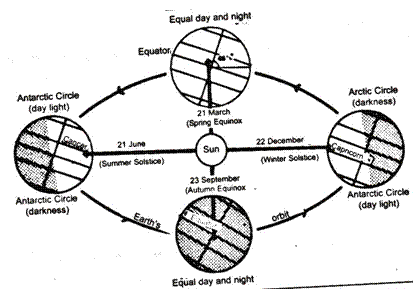
The wet season goes up to April. From May to July, the sun is overhead in the northern hemisphere. It is cool and dry in Malawi.
THE CHARACTERISTICS OF THE SEASONS OF MALAWI
- The cool and dry season
- Hot and dry season
- Hot and wet season
Malawi experiences three types of seasons during the year:
- The cool and dry season
This is from May to July.
In these months, the sun is overhead in the northern hemisphere and it is usually dry with mild temperatures except in higher places, for example, Dedza, Mzuzu and Thyolo where it becomes very cold.
During this season, most harvest takes place and some plants lose their leaves.
- Hot and dry season
This is from August to November.
Temperatures are high and there are no rains. During this season, farmers prepare their gardens in readiness for the rains. Towards the end of this season, most trees bear new leaves.
- Hot and wet season
This is the longest season. It is from November to April.
Temperatures are high, the sky is generally cloudy, and in most cases, it rains. Farmers plant most crops in this season.
UNIT 13 ENVIRONMENT
The term ‘environment’ refers to all the things around us.
COMPONENTS OF THE ENVIRONMENT
- Physical environment
- Social environment
- Cultural environment
EXAMPLES OF EACH OF THE COMPONENTS
Physical environment
- soil
- water
- rivers
- lakes
- mountains
- plants
- animals
Social environment
- roads
- buildings
- vehicles
- bridges
- dams
Cultural environment
- customs
- languages
- taboos
- traditions
- religion
- clothes
THE IMPORTANCE OF THE ENVIRONMENT
- environment is the home of humans, tamed animals as well as wild animals
- environment provides materials for construction
- environment provides land for construction of buildings, bridges and roads
- environment provides medicines
- environment is the source of minerals
- environment is a good source of teaching and learning materials
DESTRUCTIVE AGENTS OF THE ENVIRONMENT
- people
- bush fire
- animals
- running water
- wind
Different things damage the environment. These are called destructive agents. The destruction agents cause soil erosion, removal of vegetation and air pollution.
RIGHTS AND RESPONSIBILITIES OVER THE ENVIRONMENT
Rights
- Right to a clean and healthy environment
- Right to clean water
- Right to clean air
- Right to a safe environment
Responsibilities
- using the toilets and latrines correctly
- disposing refuse properly
- using and taking care of all things they are using
- taking care of water sources
- being mindful of everyone's rights
UNIT 14 FORESTRY
FOREST, FORESTRY AND FOREST RESERVES
There are a lot of forest reserves in Malawi.
These are either planted (exotic) or natural (indigenous).
A forest is a large area of land covered by trees either planted or naturally grown.
A forest reserve is an area which is created by the government for the conservation and management of trees, wildlife and watershed.
Forestry is the practice of planting, caring of trees and the production of timber.
Forestry in Malawi is practised in Chikangawa in Mzimba, Dedza and Zomba Districts.
The following are rest of the major forest reserves in Malawi:
- Dzalanyama
- Kaning'ina in Mzimba
- Thuma
- Phirilongwe
- Namizimu in Mangochi
- Ntchisi
- Chimaliro in Rumphi
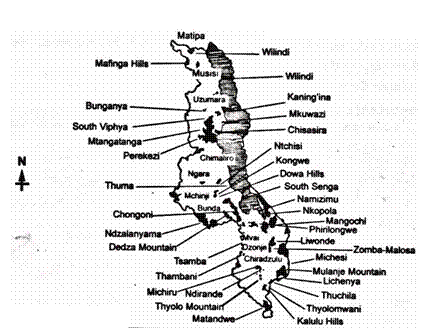
A map of Malawi showing forest reserves
THE IMPORTANCE OF FORESTS
- forests provide shelter and food to animals
- forests regulate climatic conditions
- forests provide wood for pulp and paper
- forests provide firewood for domestic use
- forests provide firewood for curing tobacco
- forests assist in the conservation of water
- forests are sources of medicine
- forests assist in preventing soil erosion
- forests are a source of timber for furniture and the building industry
- forests are useful for recreation and tourism
- forests are sources of poles and rope for various activities
- forests are a sources of government revenue
WAYS OF DESTRUCTION OF FORESTS
- cutting down of trees for charcoal burning and firewood for domestic use and sale
- cutting down trees for burning bricks, making carvings and curing tobacco
- opening new gardens or estates
- uncontrolled bush fires
- opening up a new settlement
WAYS OF CONSERVING FORESTS AND FOREST RESERVES
- avoiding and controlled bush fires
- making firebreaks around forests
- afforestation and re-afforestation
- avoiding careless cutting down of trees
- creating a sense of ownership in the communities around the forest
- making the bricks which will not require firewood
- finding an alternative business for the charcoal burners and firewood sellers
UNIT 15 FARMING AND FISHING IN MALAWI
Farming is an activity in which crops are grown and animals reared.
Examples of crops grown are:
- maize
- groundnuts
- beans
- rice
- tobacco
- tea
Examples of animals reared are:
- cattle
- goats
- chickens
- rabbits
TYPES OF FARMING METHODS
- subsistence farming
- commercial farming
Subsistence farming
The crops grown or animals reared are for food for the family. They are not for sale.
Commercial farming
The crops grown and animals reared are for sale.
Examples of commercial farming are plantation farming in which tea, coffee, sugarcane and rubber are grown, and cattle ranching for meat, and dairy farming for milk, butter and cheese.
FACTORS THAT INFLUENCE FARMING
- relief and drainage
- soils
- rainfall
- temperature
- capital
- transport
- markets
- irrigation
PROBLEMS ASSOCIATED WITH FARMING
- Unreliable rains
- Soil erosion
- Lack of pastures
- Water supplies
- Diseases
- The rapid population growth
- Poverty
- Dependence on one major cash crop
- Inadequate markets
- Illiteracy
MAIN FISHING AREAS IN MALAWI
- lakes
- rivers
Lakes
Lake Malawi, Lake Chiuta, Lake Malombe and Lake Chilwa. Lake Malawi provides the major fishing ground in Malawi
Rivers
Songwe River, North Rukuru River, South Rukuru River, Bua River, Linthipe River, Shire River
TYPES OF FISH
- chambo
- milamba
- ntchira
- usipa
- utaka
- matemba
- kampango
- kadyakoro
METHODS OF CATCHING FISH
- Fish traps (mono)
- Fishing net (khoka)
- Fishing line and hook
- Gill net
- Trawl net
PROBLEMS AFFECTING FISHING IN MALAWI
- Overfishing
- Fishing during breeding periods
- Water pollution
- Poor transportation systems to the markets
- Rapid population growth
WAYS OF CONSERVING FISH RESOURCES
- Enforcing laws about the size of the mesh for the nets so that young fish are not caught
- Enforcing laws about dumping of chemicals in rivers and lakes
- Controlling fishing during fish breeding time
IMPORTANCE OF FISH
- Fish provides food and protein to the people
- Source of money to individuals and the country
- Source of employment
UNIT 16 SOIL EROSION
Soil erosion is the removal of top soil.
TYPES OF SOIL EROSION
- splash erosion
- sheet erosion
- rill erosion
- gully erosion
- wind erosion
PRACTICES WHICH ENCOURAGE SOIL EROSION
- cutting down trees carelessly, which destroys vegetation
- setting harmful bushfires which leave the ground bare
- overgrazing and overstocking which make soil hard and unfertile
- cultivating along river banks which encourages flooding
- poor farming practices along the slopes which promote erosion
WAYS OF CONTROLLING SOIL EROSION
- planting trees and grass to cover bare grounds
- avoiding bushfires to prevent the environment from being damaged
- following good land husbandry practices to maintain soil
- controlling overpopulation of animal which causes erosion
- establishing forests to conserve the environmernt
UNIT 17 DRUG AND SUBSTANCE ABUSE
A drug is any substance used for medical purposes.
A substance is any state of matter that has an intended use by the manufacturer. To abuse is to put a drug or substance to wrong use.
Examples of drugs and substances commonly abused are chamba (hemp), glue, petrol, valium, tobacco, alcohol, mandrax and cocaine.
CAUSES OF DRUG AND SUBSTANCE ABUSE
- Peer pressure
- Curiosity
- Emotional problems
- Relaxation
- Idleness
- Ignorance
- Drive to independence
- Lack of parental care and sopport
- Means of suppressing frustration
EFFECTS OF DRUG AND SUBSTANCE ABUSE
- Dropping out of school
- Mental confusion
- Poor or impaired sense of judgement
- Involvement in crime
- Diseases
- Death
- Overdosing
- Low productivity
- Infertility
- Pressure on medical resources
- Prosecution by a court of law
- Dependence on drugs
PREVENTIVE MEASURES AGAINST DRUG AND SUBSTANCE ABUSE
- putting restrictions on drug and substance abuse
- increasing or raising awareness of the effects of drug and substance abuse
- planning and involving young people in recreational and vocational activities to keep them busy and distract them from getting involved in drugs
- putting proper warning labels on drugs and substances
- encouraging young people to exercise self control and value their bodies
- avoiding self medication
- avoiding taking expired drugs
- keeping drugs and substances away from children
- avoiding bad company
- avoiding use of drugs and substances to ease tension, frustration and stress
- getting prescriptions from qualified personnel only
UNIT 18 CITIZENSHIP
WAYS OF ACQUIRING CITIZENSHIP IN MALAWI
- by birth
- by descent
- by registration
- by naturalisation
- by marriage
A person can acquire citizen ship in Malawi in the following ways:
By birth
Every person born in Malawi with both or one of the parents is a citizen of Malawi.
By descent
Every person born outside Malawi with both or one parent is a citizen of Malawi.
By registration
A person can be a citizen of Malawi if he or she applies for citizenship, for example, a stateless person.
By naturalisation
A foreigner can also apply to become a citizen of Malawi if he or she:
® has resided in Malawi for 7 years
® is of good character
® follows the laws of Malawi
By marriage
If a woman is the wife of a Malawian citizen, she can become a citizen of Malawi.
CHARACTERISTICS OF A GOOD CITIZEN
® helps others with food
® helps others with clothes
® helps others with shelter
® helps others with books
® helps others with pencils
® helps others with pens
® tells the truth always
® attends classes
® educates others
® cooperates with others
® reports crime to police
® brings justice and peace
® participates in self-help projects
Those people with good character and do good things are called good citizens.
CHARACTERISTICS OF A GOOD CITIZEN
® dishonesty
® bullying others
® stealing other people’s property
® beating others
® being impolite to others
® not respecting elders and teachers
® running away from classes
® not doing work given
Those people with unbecoming character are bad citizens.
QUALITIES OF A GOOD CITIZEN
- tolerance
- unselfishness
- cooperation
- honesty (or truthful)
- responsible
- self discipline
- loyalty
- activeness
- forgiveness
THE DUTIES OF A GOOD CITIZEN
- respecting other people
- protecting of the state
- paying rates and taxes
- obeying the law
- educating others
- being independent
- behaving correctly
- assisting the police
- assisting the courts
THE RIGHTS AND RESPONSIBILITIES OF A CITIZEN
A citizen is entitled to rights and is responsible for many things.
All the things that a community or state must do for a citizen are referred to as the ‘rights of a citizen’. What a citizen does to safeguard the rights are the responsibilities of a citizen.
Some of the rights and responsibilities are summarised in the table below
Right |
Responsibility |
Right to access social services and facilities |
|
Right to education |
|
Right to protection |
|
Right to own property |
|
Right to economic welfare (employment) |
its citizens |
Right to vote |
elections |
Right to participate in civic affairs |
|
A CITIZEN IN DIFFERENT COMMUNITIES
A person is a social animal. This makes him or her live with other people in a community. A community is a group of people who live in the same area and have common interests.
THE COMMUNITIES TO WHICH A CITIZEN MAY BELONG
- family
- school
- village or town
- workplace
- state
- church
- club
- peers
- union
- mosque
PATRIOTISM
Patriotism is the positive and supportive attitude or love of one’s country shown by an individual or a group of people.
SYMBOLIC ACTS ASSOCIATED WITH PATRIOTISM
- defending one's nation when attacked
- talking good of one's country
- loving and being proud of one's culture
- loving and being proud of one's environment,
- being proud of one's country's achievements
- associating oneself with other citizens of one's own country
- respecting the national flag and the national anthem by standing at attention when raising the national flag and singing the national anthem
THE IMPORANCE OF BEING PATRIOTIC
- patriotism shows unity
- patriotism shows loyalty
- patriotism shows cooperation
- patriotism shows love
UNIT 19 CHILDREN'S RIGHTS
Human rights are a basic entitlement all people must have because they are people.
CHILDREN'S RIGHTS AND FREEDOMS
- Rights to a name and a family name
- Right to equality
- Right to life
- Right to dignity
- Right to be with or raised by their family or those who will care for them best
- Rights of physically and mentally challenged people
- Right to play
- Right to enough food and clean water
- Right to good health
- Right to education
- Right to liberty
- Right to information
- Right to be protected from all forms of exploitation, torture, cruel treatment or punishment and unlawful arrest
- Freedom of expression or speech
- Freedom of association
CHILDREN'S RIGHTS AND RESPONSIBILITIES
Children's rights |
Children 's responsibilities |
Right to education |
|
Right to parental care or guidance |
|
Right to protection against child abuse |
|
Right to privacy |
|
Right to enough food |
|
Right to good health |
|
Freedom of association with others |
|
Right to be treated fairly before the law |
|
Right to life |
|
Freedom of expression or speech |
|
VIOLATION AND ABUSE OF CHILDREN'S RIGHTS
To violate means to act against or break children's rights. Abuse is the cruel or violent treatment of children.
Both violation and abuse of children’s rights occur at home, school and in the community. They are committed by parents, individuals, teachers and children themselves.
Child abuse affects all children but the most disadvantaged are orphans, abandoned children, street children, domestic workers, child labourers and children with special needs.
EXAMPLES OF CASES OF CHILD ABUSE
- subjecting children to beating, kicking, threats, criticism and shame in public
- sexual abuse such as defilement, rape, molestation, inappropriate touching or fondling of sexual and other sensitive organs, forced marriages
- child neglect, like, deliberate refusal to take care of a child
- child trafficking in which children are forcefully, or with consent of parents or guardians, taken to go elsewhere as domestic or commercial sex workers or estate workers
- child labour, like, forcing children to work under situations not suitable for their age
- withholding support to children
- economic violation in which parents may force children to seek employment, indulge in prostitution, early marriage, theft, drug trafficking and vending in order to earn a living for the family
- denying children education
- forcing children to look after the young ones during school time
- disallowing children to go out and play
- denying children access to hospital or health care centres because of religious or traditional beliefs
- government's inability to provide educational materials and health facilities
- forcing children to undergo initiation in the name of cultural or traditional beliefs
- giving children heavy punishments
INSTITUTIONS THAT PROTECT CHILDREN'S RIGHTS
- the family
- the community
- the school
- the police
- the district welfare offices
- non-governmental organisation (NGOs) dealing with human rights issues
WAYS ASSISTING A CHILD WHO HAD BEEN ABUSED OR SUSPECTED OF BRING ABUSED
- taking the child to a quiet place where she or he can talk freely
- encouraging her or him to give enough information to evaluate whether abuse has occurred
- remaining calm as the child narrates his or her story so as not to upset the child
- reassuring the child that you believe him or her if she or he reveals the abuse
- assuring the child that you are going to talk to persons who can help
- reporting the abuse to the proper local authorities immediately
UNIT 20 SOCIAL SERVICES IN MALAWI
Social services are services that are provided to the people in their communities for them to survive and live a dignified life.
TYPES OF SOCIAL SERVICES
- Education services
- Health services
- Transport services
- Defence force services
- Banking services
- Communicaton services
THE IMPORTANCE OF SOCIAL SERVICES PROVIDED IN MALAWI
- Education provides services such as knowledge, skills, literacy and numeracy
- Health provides services such as medicines, health education and sanitation
- Transport provides services such as road transport, water transport and air transport
- Defence force provides services such as security, law and order and enforcing laws
- Baking provides services such as loans and safety of people's money
- Communication provides services such as internet, telephone, postage stamps, and fax.
UNIT 21 ROAD SAFETY
ROAD SIGNS AND SIGNALS
Road signs and signals assist in preventing road accidents.
ROAD SIGNS
Road signs are illustrations which are put on or along the road. They are either written or drawn.
There are three types of road signs:
- danger warning signs
- regulatory signs
- informative signs
Danger warning signs
All danger warning signs consist of a red triangle accompanied by a word or phrase describing the approaching danger.
Regulatory signs
All regulatory signs have a red circle on top of an inscription,
Informative signs
These are signs that give information.
ROAD SIGNALS
Road signals are messages which are conveyed to road users, for example, a horn, arm movement, indicator lights, traffic lights (robots).
THE IMPORTANCE OF RAOD SIGNS AND SIGNALS
- they give general information to road users concerning important features along the road, distances covered or to be covered
- they help to reduce accidents on the road
- they help to control speed
- they help to warn road users of possible danger
- they control the flow of traffic
ORGANISATION WHICH DEALS WITH ROAD SAFETY IN MALAWI
- Road Traffic Commission
- National Road Safety Council of Malawi
- Police Road Traffic Department
- National Roads Authority
FUNCTIONS OF THE ORGANISATIONS WHICH DEAL WITH ROAD SAFETY IN MALAWI
The Road Traffic Commission
- testing for and issuing driving licences
- conducting vehicle inspection for its road worthiness
- administering acts of parliament
- controlling matters as motor vehicle registration and licence
The National Road Safety Council
- giving guidance to all road users
- cooperating with organisations and authorities concerned with road safety in order to assist the Ministry of Transport in decreasing the accidents
- promoting and giving financial support for research in the field of road safety independently or with other institutions
The Police Road Traffic Department
- ensuring basic road laws are observed
- assisting in case of accidents
- prosecuting traffic offenders
- data collection, maintenance of accidents records and statistical analysis
The National Roads Authority
- checking road accident-prone areas and maintaining them
- putting up road signs
UNIT 22 MINING AND MANUFACTURING
MINING
Mining is the removal or extraction of minerals from the ground.
In Malawi, mining is done on a small scale. At present, the largest mining activity is coal. Coal mining activity is done at mchenga in Rumphi.
Other mining activities are limestone mining in Kasungu and Balaka. Quarrying and sand mining are also done at a small scale.
Mining contributes to the social economic development of the country.
Coal is used as fuel in industries while lime, sand, stones, and cement are used in construction activities.
MANUFACTURING
Manufacturing contributes to the social-economic development of Malawi. It involves the making or the production of goods or things on a large scale. The production is done mostly by machines.
Some of the industries in Malawi are:
- sugar manufacturing industries
- tea manufacturing industries
- cloth manufacturing industries
- soap manufacturing industries
- fertilizer manufacturing industries
- shoe manufacturing industries
- candle manufacturing industries
Sometimes manufacturing is done by hand. But if there is need to produce more, machines are used.
Things that are manufactured include clothes, carpets, simple machine, exercise books, chairs, bread, canned food, sugar, drinks and many others.
FACTORS FOR THE GROWTH OF MANUFACTURING
- Raw materials
- Human resources
- Markets
- Energy sources
- Transport
- Water
THE IMPORTANCE OF THE MANUFACTURING INDUSTRIES
- providing job opportunities
- Transport and communication facilities are developed and improved
- Some manufacturing industries produce raw materials for others
- assisting countries to earn and save money when some of the products are exported and also when raw materials are produced locally
- people get their requirements from within and nearby places
UNIT 23 TOURISM
THE LOCATION OF TOURIST CENTRES IN MALAWI
Malawi has many beautiful places which attract tourists.
The places of interest include beautiful mountains, plateaus, valleys, waterfalls, lakes, wildlife, historical sites, cultural sites, ancient buildings, national parks and game reserves.
Some of the tourist centres in Malawi are as follows:
- Anglican Cathedral on Likoma Island (St Peters)
- Mulanje Mountain
- Old mission site at Cape Maclear in Mangochi
- St Michael's and all angels Church in Blantyre
- Lake Malawi
- Mwalawamphini near Cape Maclear in Mangochi
- Rock paintings in Kasungu National Park, Dedza and Ntcheu
- National parks and game reserves
- Ku Chawe and Chingwe's hole on Zomba Mountain
- The stone house at Livingstonia in Rumphi
- The Providence Industrial Mission (PIM) in Chiradzulu
- Chilema Lay Training Centre in Malosa, Zomba
- Mua cultural museum in Dedza
THE IMPORTANCE OF TOURISM TO MALAWI
- source of foreign exchange
- creating job opportunities in the country
- preserving cultural heritage for future generations
- improving social services
- promoting education by studying historical places and living things in national parks
- promoting contact among people from different areas
- promoting the desire to travel more
- encouraging the government to create more areas of interest
THE PROBLEMS THAT AFFECT TOURISM IN MALAWI
- Poor transport and communication systems
- Long distances to major tourist centres
- Inadequate accommodation
- Unfavourable weather conditions
- Lack of information among tourist centres
- Degradation of the environment leading to the loss of important features and animals
POSSIBLE SOLUTIONS TO THE TOURISM PROBLEMS
- improving hotel facilities
- constructing new roads and maintaining old roads
- improving social services
- improving travel agency services
- training tourist guides
- maintaining national parks, game reserves and lodges
UNIT 24 TRANSPORT AND COMMUNICATION IN MALAWI
MAJOR TYPES OF TRANSPORT AND COMMUNICATION METHODS IN MALAWI
People move from place to place by using different modes of transport. People also use different types of transport to move goods.
The types of transport methods include:
- motor vehicles
- ships
- aeroplanes
- trains
- bicycles
- motor cycles
Just like people and goods, thoughts, ideas, knowledge and information move from one place to another. This is called communication.
The means of communication include:
- letters
- telephones
- faxes
- electronic mail (e-mail)
- radio
- television
THE ROAD TRANSPORT SYSTEM IN MALAWI
Malawi has a network of roads.
The roads connect rural areas with district headquarters. District headquarters are also connected with major towns and cities.
Some of the roads are tarred while the majority are made of gravel.
Malawi is also connected with the countries by major roads. These include:
- Mzuzu – Karonga to Mbeya – Dar-es-Salaam road in Tanzania, commonly referred to as the Northern Corridor
- Lilongwe – Mchinji to Chipata – Lusaka route
- Blantyre – Mwanza to Harare in Zimbabwe
- Blantyre – Mulanje - Muloza to Quilimane in Mozambique
Different types of vehicles are used on the roads.
These include small cars, lorries, buses, trucks and oil tankers which carry petrol, diesel and paraffin. Bicycle are also used on the roads.
THE RAILWAY TRANSPORT SYSTEM IN MALAWI
Malawi has the following railways line:
- The Beira railway line starts from the port of Beira on the Indian Ocean in Mozambique, through Nsanje, Limbe and Blantyre. From there, the line extends northwards through Balaka, Chipoka, Salima, Lilongwe and then Mchinji.
- The Nacala railway line also starts from the Indian Ocean port of Nacala in Mozambique. It enters Malawi through the border of town of Nayuchi to Liwonde on River Shire and then joins the Blantyre
– Balaka railway at Nkaya.
Malawi, therefore, does not have a port of its own at the ocean because it is surrounded by Mozambique, Tanzania and Zambia.
Its exports and imports have to pass through Mozambique and Tanzania. In so doing, Malawi pays customs duty and tansportation.
THE WATER TRANSPORT SYSTEM
Lake Malawi provides a natural waterway running in a north-south direction.
Water transport is the cheapest means of transport as compared to road, rail and air transport systems.
The major lake transport route runs from Monkey-bay (where steamers are assembled) in the south through Chipoka, Nkhotakota, Likoma, Chizumulu, Nkhatabay, Usisya and Chilumba.
These are major ports.
The following are the passenger and cargo steamers that sail on Lake Malawi:
- Passenger steamers are the Chancy Maples, Illala and Mtendere
- Cargo steamers are Karonga Nkhwazi, Ufulu and Mpasa
Likoma and Chizumulu Islands depend upon lake transport for transportation of all their requirements.
THE AIR TRANSPORT SYSTEM
Air transport is the fastest means of travelling. However, it is very expensive.
Malawi has two types of air transport services: domestic and international.
Domestic air services are provided within Malawi.
The major airports are Chileka (Blantyre), Kamuzu International Airport (Lilongwe), Mzuzu and Karonga.
International air services are provided at Chileka International Airport and Kamuzu International Airport, with connections to Nairobi (Kenya), Dar-es-Salaam (Tanzania), Lusaka (Zambia), Harare (Zimbabwe), Johannesburg (South Africa) and onward to Europe and America.
The other major international airways include the British Airways, South African Airways, Kenya Airways and Ethiopian Airways.
Airplanes carry passengers, goods and mail. Some planes also carry fuel and foodstuffs.
THE COMMUNICATION SYSTEM IN MALAWI
Communication is mostly used for passing information from one point to another.
Some of the communication systems are as follows:
- letters
- telegrams
- telephone
- cell phones
- radio
- television
- electronic mail (e-mail)
- newspapers
- magazines
THE IMPORTANCE OF TRANSPORT AND COMMUNICATION IN MALAWI
Road and railway transport
- It makes travelling easier from one part of the country to another for business or visiting friends
- It connects villages with market centres
- Transportation of goods from where they are produced to where they are needed is done easily
- Roads connect Malawi with neighbouring countries as well as distant countries
- Agricultural produce are transported to overseas markets. The products sold to outside markets are called exports.
- Manufactured goods are transported to Malawi by railway lines. Such products obtained from outside the countries are called imports.
- People living along railway lines use trains as passengers and for businesses
Water transpot
- Agricultural products are transported by lake services
- Some people living along Lake Malawi use the water transport to move to various places in the country
- Manufactured goods are transported by water.
Air transport
- It is used to carry passengers within and outside the country
- Mail and some goods are trasported by air
- It makes travelling faster
Communication
- It enables easy exchange of ideas, information and knowledge
- It makes transmission of messages fast
THE PROBLEMS OF TRANSPORT AND COMMUNICATION IN MALAWI
Road transport
- Most roads are untarred making travel difficult especially during the rainy season
- Blantyre and Lilongwe experience traffic congestion during some peak hours of the day
- Air pollution from cars is becoming a problem
- Some people vandalise road signs
- Some bridges are below standard
Rail transport
- Railway lines are confined to specific routes
- It is very expensive to construct a railway line
- Railway line routes to the ports of Beira and Nacala are long. It is therefore expensive to transport goods to and from the ports.
Water transport
- It is too slow
- It requires deep waters for steamers to anchor at the port
- Use of vessels which are too old
Air transport
- It is very expensive. Therefore, very few people in Malawi travel by air
- Fuel and spare parts for aircrafts are expensive. Therefore air transport has very high running costs
Communication
- Many people are too poor to buy or use modern communication equipment
- There is a lot of competition between post offices which use letters and telegram and telecommunication companies that use cellphones, faxes, and e-mails for efficient communication
- Vandalism and theft of communication equipment is common in some areas
GLOSSARY
Abscesses-boils
Abstinence-refraining from doing something for example, sex
Assembly-an administrative structure or institution which is responsible for providing services to the local communities
Birth rate-the number of live births per 1000 people
By-laws: a law made at an assembly level for its function
Central government: the main body of government which has the authority and power to make, implement and manage a country’s resources, disputes and so forth
Death rate: the number of deaths per 1000 people Kingdom: a territory or country ruled by a king
Local government: a branch of government which has the decentralised functions of the central government to local communities
Migration: the movement of people from one area to settle in other area Mortality: the incidence of deaths in a given population
Mountain range: a chain of mountains
Plateau: a highland or mountain with a wide flat top
Population change: an increase or decrease in a given population
Transmit: pass from one person to another
Voluntary: doing without being forced
REFERENCES
MIE (2008) Social Studies Teacher’s Guide for Standard 6, Domasi; MIE. MIE (2008) Social Studies Learner’s Book for Standard 6, Domasi; MIE.
Notes will be here
UNIT 1 SCIENTIFIC INVESTIGATIONS
UNIT 3 MOVEMENT IN HUMAN BEINGS
UNIT 6 NUTRITIONAL DEFICIENCY DISEASES
UNIT 9 INFORMATION AND COMMUNICATION TECHNOLOGIES
UNIT 10 THE EXTERNAL PARTS
UNIT 14 METHODS OF COOKING FOOD
UNIT 15 KITCHEN HYGIENE AND SAFETY
UNIT 16 MEAL PLANNING AND PRESENTATION
UNIT 18 CARE FOR ROOMS IN THE HOME AND ITS SURROUNDINGS
UNIT 22 IMPROVING THE HOME AND ITS SURROUNDINGS
UNIT 23 MANAGING INFORMATION AND COMMUNICATION TECHNOLOGIES
UNIT 1 SCIENTIFIC INVESTIGATIONS
STAGES OF A SCIENTIFIC INVESTIGATION
There are six stages of scientific investigation. These are:
- Knowing the problem
- Making a prediction
- Planning the investigation
- Carrying out the investigation
- Making meaning of the results
- Making conclusions
These six stages can be summarized into three main stages which are:
- Planning stage
- Implementation stage
- Concluding stage
PLANNING STAGE
This stage involves a number of steps.
The first step is to identify the problem to be investigated.
The second step is to write the statement of the problem in the form of a question The third step is to predict or guess the answer to the question or problem.
The predicted answer is called a hypothesis.
The next step is to identify what is going to be observed and measured.
These are the factors that would affect the results of the investigation which are called variables. A variable is anything that can change.
The next step is to identify the materials that will be required to carry out the investigation.
The last step of the planning stage is to come up with steps to be followed in the process of collecting data.
The above steps of the planning stage of an investigation are summarised as follows:
Step 1 identifying the problems to be investigated
Step 2 writing a statement of the problem to be investigated in the form of a question
Step 3 predicting or guessing the answer to the question, that is, coming up with a hypothesis
Step 4 identifying the variables
Step 5 identifying the materials required for carrying out the investigation
Step 6 coming up with the procedures for carrying out the investigation
IMPLEMENTATION STAGE
The second stage of a scientific investigation involves implementing the plans that were developed during the planning stage.
This is the stage which the hypothesis are tested by carrying out the investigation.
During this stage, the variables to be investigated are deliberately changed while keeping the other variables constant.
The variables that are changed are observed and recorded as the investigation is being conducted. The purpose of carrying out an investigation is to collect data through observation.
If one is not satisfied with the data that has been collected, it is necessary to repeat the procedures. The data that is collected should be organised and presented in a meaningful way.
There are several ways of presenting data. These include tables and graphs.
When presenting data in the form of a graph, it is important to remember that:
- a sharp pencil should be used when drawing graph lines
- each graph should be given a title
- a scale that can give a large graph should be chosen so that points are plotted accurately
- the vertical and horizontal axes should be labelled and the units for each axis should be shown
- a line of best fit should be drawn if points do not lie on a straight line or smooth curve
When data has been collected, it should be organised in such a way that it is meaningful. The procedures of organizing data are referred to as data analysis.
One way of analysing data is the use of graphs.
Once the data has been analysed, there is need to interpret it.
The interpretation of data involves determining the relationship between variables using the analysed data.
The methods of determining the relationships between variables include:
- Looking for patterns of data in a table
- Interpreting the shapes of graph lines
In summary, the implementation stage of scientific investigation involves the following:
Step 1 carrying out the investigation according to the plans. Step 2 collecting data and presenting it in a meaningful way. Step 3 analysing the collected data.
Step 4 interpreting the analysed data.
CONCLUDING STAGE
The last stage of a scientific investigation is the concluding stage.
During this stage, the hypothesis is evaluated against the interpretation of the data.
That is, the relationship between variables that has been determined from the data is compared with the hypothesis of the investigation.
If the determined relationship from the analysed data agrees with the hypothesis then the hypothesis becomes the conclusion of the investigation.
If the hypothesis is different from the relationship determined from the results of the investigation then the hypothesis is not true.
What is important is that the conclusion must be based on the results of the investigation and not on the investigator’s wishes.
UNIT 2 THE HUMAN SKELETON
THE HUMAN SKELETON
The skeleton is the hard part of the body.
It is composed of many bones which are joined together at places called joints.
FUNCTIONS OF THE SKELETON
- Giving support to the body
- Protecting some delicate parts of the body such as heart, lungs, brain and the spinal cord
- Assisting in locomotion
- Giving shape to the body
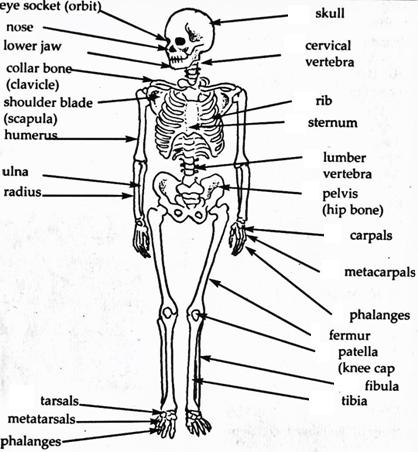
A human skeleton
MUSCLES
Muscles are organs which are attached to bones by tissue called tendons
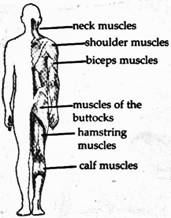
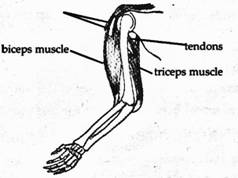
The main muscles of the body
How the muscles of the arm are attached to the bones
The pinna directs sound into the ear canal. At the end of the ear canal is a thin membrane called the eardrum. Sound causes the eardrum to vibrate. This helps us to hear sound.
The wall of the ear canal secretes brown wax which protects the ear passage. However, excessive wax may damage the ear drum or prevent a person from hearing.
THE PROBLEM OF THE EAR
- Damage of the ear drum
- Foreign bodies such as insects and seeds getting into the ear
- Ear infections
CARE FOR THE EAR
- Avoiding removing a foreign body from the ear with a pointed object that can damage the eardrum.
- Avoiding loud sounds
- using a wet cloth to clean the outer ear
- Avoiding using sharp objects to poke the ear
If the foreign body is an insect try:
- Directing some light into the ear so that it may come out
- Putting drops of either water, cooking oil, castor oil or glycerine. If these first aid measures fail, take the person to the hospital.
- THE SKIN
The skin is an organ for feeling. It has different parts for different functions.
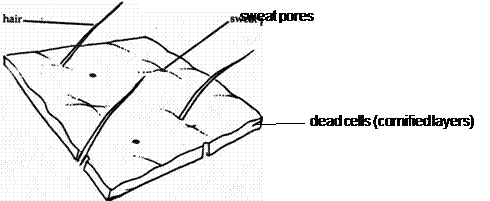
The external parts of a skin
FUNCTIONS OF THE SKIN
- Detecting roughness, softness, coldness and hotness of things. It also detects pain as a way of protection
- controlling body temperature. For example, when it is cold, the skin pores close and when it is hot, the skin pores open to release sweat and heat.
- Preventing germs from entering the body, for example, it acts as a barrier to the entry of germs into the body
- Acting as a shield against water, for example, when swimming or taking a bath
THE PROBLEMS OF THE SKIN
- skin infections such as rashes, scabies, ringworm and boils
- Cancer of the skin
- pimples/acne
CARE FOR THE SKIN
- Bathing regularly
- Avoiding using other people's bathing materials, like bath towers, face towels and sponges
- Protecting the skin against harsh weather conditions
UNIT 5 COMMON ACCIDENTS
Several accidents happen in the home and community. These include cuts, burns, scalds, nose bleeding, suffocation, choking, poisoning and road accidents. These can be caused by sharp objects, falls, fire, hot water and poisoning substances.
EFFECTS OF ACCIDENTS
- loss of blood
- disability
- blindness
- death
CAUSES AND PREVENTION MEASURES OF SOME COMMON ACCIDENTS
Accident |
Causes |
Prevention |
cuts and grazes |
|
and hanging) |
poisoning |
|
|
burns and scalds |
|
and dangerous chemicals |
choking |
|
|
suffocation |
|
|
drowning |
|
boats |
FIRST AID TREATMENT
First aid treatment is the first help given to an injured person before he or she is taken to the hospital. First aid treatment is important because it can save life.
First aid treatment materials are kept in a first aid treatment box or kit
First aid treatment materials may consist of:
- cotton wool for cleaning wounds
- antiseptics for killing germs
- pairs of scissors and safety pins for cutting and doing up bandages
- various sizes of bandages
- plaster of different sizes
- tablets
- triangular and other types of bandages
PROCEDURES FOR CARRYING OUT FIRST AID FOR COMMON ACCIDENTS
Accidents |
First aid treatment |
cuts and grazes |
|
nose bleeding |
|
sprain |
|
choking |
|
drowning |
|
The following additional information can help you to understand how to help a person who has nose bleeding or choked.
NOSE BLEEDING
To stop nose bleeding, follow the steps below:
- Sit quietly
- Pinch the nose firmly for 10 minutes or until the bleeding has stopped
- If this does not control the bleeding, pack the nostrils with cotton wool, leaving part of it outside the nose
- If possible, first wet the cotton with petroleum jelly, then pinch the nose firmly again. Hold it there for ten minutes or more.
- Leave the cotton in place for a few hours after the bleeding stops, then take it out gently.
- If a person's nose bleeds often, smear a little petroleum jelly inside the nostrils twice a day
If bleeding comes from the back part of the nose, it cannot be stopped by pinching.
In this case, have the person bite the cob of maize or other similar objects between her or his teeth while leaning forward.
The patient should sit quietly and try not to swallow anything until the bleeding stops. The cob of maize helps to keep the patient from swallowing. This gives blood a chance to clot. Eating oranges, tomatoes and other fruit may help strengthen the veins so that the nose bleeds less.
CHOKING
The following can be done to help the person who has choked:
- Stand behind the person and wrap your arms around his or her waist
- Put your fist against her or his belly above the navel and below the ribs
- Press into her or his belly with a sudden strong upward jerk. This forces the air from the lungs and should clear the throat. Repeat several times if necessary.
If the victim is much bigger than you, or unconscious do the following:
- Lay her or him on her or his back
- Sit over her or him
- Make a quick strong upward push
- Repeat several times if necessary
- If he or she still cannot breathe, try mouth -to -mouth breathing
To do mouth-to-mouth breathing follow the steps below:
- Open the mouth of the victim
- Remove any particles from the mouth
- Tilt the head of the victim to open the air passage to the lungs
- Pinch the nose of the victim with one of your hands while the other hand is placed just below the chest of the victim
- Breathe into the mouth of the victim while releasing the hand below the chest
- Press the hand below the chest of the victim as you breathe out
- Do this several times until the victim is able to breathe
UNIT 6 NUTRITIONAL DEFICIENCY DIESEASES
Nutritional deficiency diseases occur due to lack of a particular nutrient in the diet.
TYPES OF NUTRITIONAL DEFICIENCY DISEASES
- Kwashiorkor
Kwashiorkor is caused by lack of proteins in the body. It usually affects children below the age of five.

a child with kwashiorkor
FACTORS THAT MAY LEAD TO KWASHIORKOR
- Lack of protein in the diet during infancy
- Shortage of protein foods especially during weaning
- Lack of knowledge about food
- Infections to which children at this age are susceptible to, such as malaria, diarrhoea, measles, TB and intestinal worms
SIGNS AND SYMPTOMS OF KWASHIORKOR
- Loss of weight
- Poor appetite
- Swelling body due to accumulation of too much water (oedema)
- Failure to grow
- Large, protruding abdomen due to an enlarged liver
- Diarrhoea and vomiting
- Skin appearance changes and peels off
- Hair looks thin and straight
- Upper limbs get thin
- Mental retardation
- Marasmus
Marasmus is caused by an overall deficiency of food in the body including protein and carbohydrates. It occurs in children under the age of one.
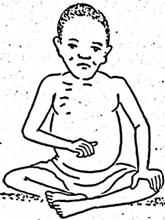
a child with marasmus
CAUSES OF MARASMUS
- Low food supply
- Lack of knowledge of proper weaning practices
- Adhering to food taboos and beliefs
- Long illness or diarrhoea in a child may prevent absorption of food
SIGNS AND SYMPTOMS OF MARASMUS
- Poor appetite
- Not looking alert
- Little fat deposit under the skin
- Wasting of muscles or poor muscle development
- Loose or wrinkled skin
- Stunted growth
- Looking small for his or her age
PREVENTION AND TREATMENT OF KWASHIORKOR AND MARASMUS
Deficiency disease |
Preventive measures |
Treatment |
Suitable foods |
Kwashiorkor |
good time |
should be taken to hospital |
|
Marasmus |
weaning foods and infant feeding practices |
|
|
UNIT 7 FOOD PRESERVATION
To preserve food means to treat it so that it is safe, does not decay or get spoiled.
Food preservation is an old practice for ensuring that people have food throughout the year. This is important because food can be made available throughout the year.
CAUSES OF FOOD DECAY
Micro-organisms cause food decay and spoilage.
These micro-organisms are found in the air, water, soil and almost everywhere.
THE TYPES OF MICRO-ORGANISMS THAT CAUSE FOOD SPOILAGE OR DECAY
- Bacteria
- yeasts
- moulds
To preserve food successfully, the micro-organisms must be destroyed to stop them from growing and multiplying.
Once food is preserved, it should be stored safely, so that the micro-organisms are prevented from coming into contact with it.
THE IMPORTANCE OF FOOD PRESERVATION
- Reducing bulkiness for easy carrying and storage
- Avoiding wastage
- Adding variety to the diet because food can be eaten even when it is out of season
- Improving the flavour, colour and texture of food
- Keeping food longer for future use and in emergencies such as during famine, floods and war
FOOD PRESERVATION TECHNOLOGIES
There are several food preservation technologies. These can be categorised into:
- Indigenous food preservation technologies
- Modern food preservation technologies
INDIGENOUS FOOD PRESERVATION TECHNOLOGIES
These are technologies used to preserve food that have been developed within a given society.
These include:
- Sun drying
The food is exposed to strong sunlight, which evaporates the moisture in it.
This creates unfavourable conditions for the growth and multiplication of micro-organisms.
The types of food which can be preserved in this way include fish, fruit, vegetables, beans and maize.Muscles can contract and relax.
Their ability to contract and relax brings about movement at a joint.
When a muscle contracts, it pulls the bone to which it is attached and moves it in one direction.
JOINTS
Joints are formed when two or more bones meet
Examples of points include the skull, finger, shoulder, elbow, hip and wrist.
TYPES OF JOINTS
- Movable joints
- Immovable joints
- Hinge joints
- Ball and socket joints
- Gliding joints
Joints that allow movement are called movable joints. For example, finger, shoulder and elbow joints. The joints that do not allow movement are called immovable joints. For example, the joints of the skull. Joints that allow to and fro movement are called hinge joints. For example, the knee and elbow joints.
Those that allow rotational movement are called ball and socket joints. For example, shoulder and hip joints.
Joints at which bones move by sliding or gliding over another are called gliding joints. For example, joints of the neck.
UNIT 3 MOVEMENT IN HUMAN BEINGS
Muscles are attached to the bones by special tissue called tendons. The action of muscles allows movement at a joint.
For example, there are two muscles which control movement at the elbow joint.
When the biceps muscles contract, they pull the bones of the lower arm forward and the arm bends at the elbow joint. When the biceps muscles contract, the triceps muscles relax. When the biceps muscles relax, the
triceps muscles contract and pull the bones of the lower arm and stretch the arm. The contraction and relaxation of the biceps and the triceps muscles bend and stretch the arm.
Similarly, when the muscles at the back of the thigh contract, the lower leg is pulled backwards and the leg bends at the knee joints. When these muscles relax and the muscles in front of the thigh contract, the lower leg is pulled forward and the leg straightens.
UNIT 4 SENSE ORGANS
SENSE ORGANS
The human body has five sense organs. These are the nose, tongue, ear, skin and eye. These organs have different functions. The nose is used for smelling; the ear for hearing; the eye for seeing; the tongue for tasting, and the skin for feeling and touching. Tasting, smelling, hearing, seeing, feeling and touching are called senses.
- THE NOSE
The nose is used for smelling and breathing. It has nostrils through which air passes in and out of the body. The nostrils have hairs and mucus which trap some dust and germs, thereby, preventing it from getting into the body.
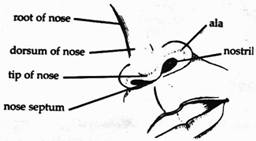
The structure of the nose
THE PROBLEMS OF THE NOSE
- Colds and flu
- Nose bleeding
- Sores
- Foreign bodies such as beans, maize and other seeds getting stuck and causing discomfort in the nose
CARE FOR THE NOSE
Pushing or poking objects into the nose may damage it. If objects such as beans get into the nose, the victim should try to blow them out. If this fails, ask the victim to breathe through the mouth and take him or her to the hospital. The nose should also be cleaned regularly. Apart from this, avoid sniffing unknown substances.
- THE TONGUE
The tongue is used for tasting things. It can detect sweet, salty, sour or bitter things. The tongue also helps during chewing and swallowing of food. It also helps in spitting, speaking and whistling.
The tongue has a rough surface. The bumpy structures on the tongue are called taste buds.
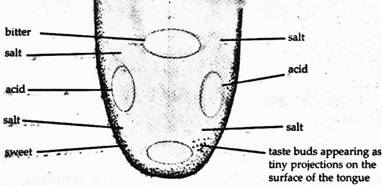
The structure of the tongue
THE PROBLEMS OF THE TONGUE
- sores
- foreign bodies such as fish bones
- swellings
CARE OF THE TONGUE
- avoiding eating foods that are too hot
- avoiding eating too fast
- avoiding talking while eating
- avoiding tasting unknown substances
- avoiding eating spicy foods
It is also important to brush the teeth and the tongue regularly to avoid bad breath.
- THE EYE
The eye is an organ of sight. It has different parts for different functions.
The black spot of the eye is called the pupil. It allows light to get into the eye to see things. The coloured part of the eye is called the iris. This controls the size of the pupil. In dim light, the iris makes the pupil bigger to
allow more light to get in. In bright light, the iris makes the pupil smaller to reduce amount of light that gets into the eye. The eyelid and eyelashes protect the eye from dust and other particles.

The external parts of the eye
THE PROBLEM OF THE EYE
- Eye infections such as trachoma, conjunctivitis and sores
- Foreign bodies such as dust and insects getting into the eye causing pain
- Eye defects such as long sight and short sight
CARE FOR THE EYE
- Always keeping eyes clean and free from flies and dirt
- Eating foods which are rich in vitamin A such as green vegetables, pawpaws, carrots, butter and mangoes.
- Treating eye which has been infected
- Using a soft clean cloth when removing foreign bodies from the eyes
- Avoiding exposing the eyes to direct sunlight or any other bright light
- Wearing protective glasses when taking part in an activity that may cause injury to the eyes
- Not wearing glasses without proper prescription
- THE EAR
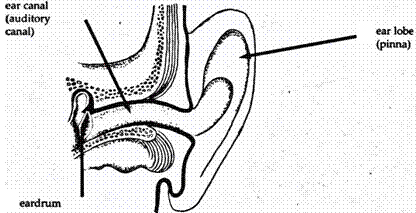
The ear is an organ for hearing. The outer ear consists of the pinna and the ear canal or auditory canal.
The external parts of the ear
- Smoking
Smoke is a preservative used to destroy micro-organisms and prevent their growth. In this way, foods that are smoked are preserved.
Foods which can be smoked include fish and meat.
- Salting
This is one of the oldest food preservation technologies. In this technology, salt draws out water from the food.
The water from the micro-organisms is also removed by the salt.
This creates an environment that is not conducive for the growth of the micro-organisms.
Foods that can be salted and dried include meat, fish, caterpillars, mushrooms, fruit and green vegetables.
MODERN FOOD PRESERVATION TECHNOLOGIES
These are new technologies used to preserve food.
These include:
- Freezing or refrigeration
This technology is used to preserve food by keeping it at low temperatures to inactivate micro-organisms. When freezing, freezers, refrigerators and cold rooms are used.
Foods preserved in this way include meat, fish and vegetables.
- Canning or bottling
This is one of the widely-used technologies of food preservation. Both technologies rely on heating to destroy micro-organisms.
The bottles or cans are filled with food while air is removed.
Then the bottles or cans are immediately sealed, sterilised and cooled.
In most cases, preservatives are added to the canned foods to increase their life.
Canning or bottling is used to preserve foodstuffs such as fruit, fruit juices, milk, beans, fish, peas and meat.
- Jam making
This is a technology used to preserve fruit.
It is based on the fact that a high concentration of sugar kills micro-organisms and prevents their growth. After the jam is made it is sealed in jars cutting off air completely so that it remains fresh for a long time. Jam can be made from fruit such as mangoes, peaches, guavas, plums, apples and strawberries.
STORAGE FACILITIES FOR PRESERVED FOODS
It is important to provide storage facilities for preserved foods in the homes.
The storage facilities include bottles or jars, baskets, cartons, freezers or refrigerators, granaries, sacks and food stores.
THE PROBLEMS OF FOOD PRESERVATION
- Loss of nutrients especially in the case of cooking
- Poor food hygiene. For example, the presence of sand in some vegetables, mushrooms and fish
- Expensive in terms of processing
- Lack of knowledge of food preservation
- Lack of continuous power supply
- Contributing to pollution and deforestation
UNIT 8 MATERIALS PRODUCTION
MATERIALS FOR PRODUCING THINGS
Different materials that people use in their everyday life are made through the use of scientific and technological processes.
Most of these materials are produced in factories using machines.
However, some of these materials such as soap, crayons, vim, floor polish and shoe polish can be made manually.
To produce these materials one requires materials and steps to be followed.
- Crayon production
Crayons are formed by mixing melted candle wax and finely crushed coloured pieces of chalk or dye.
The wax is melted to allow the dye or crushed pieces of chalk to mix well. The mixture is left to cool down for it to solidify.
Resources needed
- candle wax
- finely crushed coloured chalk or dye
- 10cm pieces of pawpaw straws or reed
- metal containers, tins or pots
- sticks
- a source of heat
Process
- heat pieces of candle wax in a pot or any metal container until it completely melts
- add the coloured chalk powder to the melted candle wax
- stir with a stick until it is well mixed
- arrange pawpaw straw or reed upright in a container such as a plastic cup
- carefully pour the contents into the straws in the container
- let them cool down
- peel off the straws
- then the crayons are ready for use
- Shoe polish making Resources needed
- candle wax
- finely-crushed charcoal
- paraffin
- containers
- source of heat
- sticks
- pots
- mortar-and pestle
- sieve
Process
- put the pot or tins with candle wax on fire
- let the wax melt completely
- add powdered charcoal to the wax
- stir to mix well
- immediately add a little amount of paraffin to the contents and keep on stirring until well mixed
- you may pour the contents into storing containers of your choice such as used shoe polish cans
- let the contents cool down
- black shoe polish is ready for use
- Floor polish making
Floor polish and shoe polish almost follow the same scientific process. Candle wax is melted and later mixed with a small amount of paraffin. The paraffin is added to the melted wax in order to let the wax be in a semi solid state as it cools down.
Resources needed
- candle wax
- pots
- paraffin
- sticks
- red oxide
Process
- melt the candle wax in a pot or tin
- add a little paraffin and stir until a desired thickness is acquired
- you may add red oxide powder to obtain red floor polish
- let the contents cool
- the floor polish is ready for use
- Production of cleaning powder
Scouring agents are used for cleaning different materials such as saucepans, cups, buckets, metal sinks. These can be made locally.
Resources needed
- Egg shells
- Powder soap
- Mortars and pestles
- Sieves
- Containers
Process
- grind the egg shells to very fine powder in a mortar
- add a little powdered soap to the contents
- mix well
- the powder is ready for use
- Soap making
Soap is made from animal fat or vegetable fat mixed with a strong alkali such as caustic soda, water and salt. Fat is made up of fatty acids and glycerine.
Soap is formed by the chemical reaction of fat and caustic soda or caustic potash alkalis)
When alkalis are mixed with fat, glycerine is separated and the fatty acids plus the caustic soda form soap.
Resources needed
- fat
- beakers or tins
- water
- salt
- caustic soda
- sources of heat
Procedure
- melt the fat in a beaker or tin for at least one hour
- when the mixture is thick, add salt and boil it for 10 minutes
- let the mixture cool
- remove the layer of soap
UNIT 9 INFORMATIION AND COMMUNICATION TECHNOLOGIES
The term “information and communication technology” refers to the use of computers and other devices to capture, process, store, retrieve, transfer and control information in a variety of forms such as numbers, text, sound or images.
Examples of information and communication technologies are computers, telephones, cell phones, radios, televisions, fax machines and automatic teller machines (ATMs)
USES OF INFORMATION AND COMMUNICATION TECHNOLOGIES AND HOW THEY WORK
The radio
The radio works by detecting waves created at a radio station.
The radio uses electronic systems to process the waves. In this way, people are able to hear music and voices through the receiver’s speakers.
The announcer speaks or plays music into a microphone. The sound passes through the microphone as sound waves. The transmitter picks these waves, then changes them to radio waves. The aerial of the radio receives the radio waves from the transmitter. The speaker of the radio then changes the radio waves into music or a voice.
The telephone
There are two types of systems that are used in transmitting messages through telephones. These are analogue and digital systems.
In the analogue system, the telephones transmit voices over long distances electronically. In this system, the transmission can easily be distorted or be interfered with.
In a digital system, the spoken word is converted into a digital language before being transmitted. The receiver then converts the digital language to sound. There is no interference or distortion in this type of telephone system.
The fax machine
The fax machine is used to transmit information from a document (hard copy) using phone lines. When the document is being sent, first the information on the document is converted into a digital language. The receiver then converts the digital signal into the original language that is on the document. Thus, the printout of the document that comes out of the receiver is exactly the same as the original document.
The cell phone
The spoken voice is converted into a digital language which travels to receiver via a transmitter. The transmitter is used to amplify the digital language. The receiver then converts the digital signal into sound resembling the original voice.
The television (TV)
In the television studio, the cameras capture the pictures which are converted into a digital signal by an encoder. The digital signal travels to a satellite dish which sends the signal via a transmitter to a satellite in space. The satellite processes it and sends the signal back to the dish on the ground which then sends the signal to the television set. The decoder that is connected to the television set converts the signal into pictures and sounds that resemble the original ones. Signals from telephones and cell phones can also be sent by a satellite.
The computer
The computer can be used for collecting information which can be stored or analysed and made available for later use. The uses of the computer include managing accounts, keeping information on spare parts for cars in garages, keeping records of patients, collecting information on laboratory tests and helping diagnose diseases in hospitals, automatic flying of planes, forecasting weather, running the different activities and monitoring progress in factories, running radio and television programmes, sending messages quickly through electronic mail (e-mail) , playing games, and word processing, that is, typing and formatting the typed work.
A computer has three main parts:
- input device
- the central processing unit (CPU)
- output device
The central processing unit is the main part of the computer.
The input devices of a computer are the keyboard and the mouse. The keyboard is used to enter information into the processor. The mouse is also an input device. It is moved around and controls an arrow that is known as a cursor which appears on the computer screen.
The monitor or screen is one of the output devices of a computer. It enables users to see what they are doing. The printer is another output device that produces a printed copy of the information in the computer.
The internet
This is another form of information and communication technology. The internet is a connection of millions of computers around the world. It uses a language that allows different computers in different parts of the
world to communicate with each other. The information on the internet is arranged on websites that can easily be accessed. People use the internet to store and find information quickly.
THE IMPORTANCE OF INFORMATION AND COMMUNICATION TECHNOLOGIES
- source of employment in computer programming, website designing, computer maintenance and administration
- contributing to the improvement in the quality of health services
- can be used for leisure like computer games and movies
- enabling people to have quick access to information
DISADVANTAGES OF INFROMATION AND COMMUNICATION TECHNOLOGIES
- increased unemployment rate in some sectors due to reduced demand for human labour
- exposure to health risks
- the high cost of advanced technologies
UNIT 10 THE EXTERNAL PARTS OF PLANTS
THE EXTERNAL PARTS OF A PLANT AND THEIR USES
A plant has different external parts.
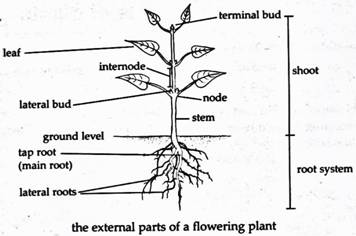
These parts have different functions
- Leaves
These allow air to pass in and out of the plant through small openings called stomates. There are more stomates under the leaf than on top. Leaves also make plant food from water and carbon dioxide using sunlight in a process called photosynthesis.
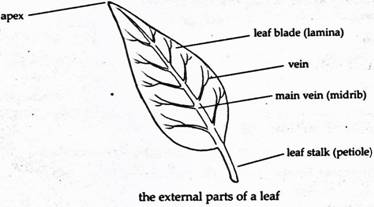
Oxygen is also produced as a by-product of photosynthesis. The veins in the leaf carry water and mineral salts and make the leaf stiff.
- Stems
These connect the leaves, branches and the roots.
Water and mineral salts from the roots pass through the stem to the leaves. Some stems such as sugarcane and Irish potatoes store food for the plant.
- Roots
The roots hold the plant in the soil. Roots take in water and mineral salts from the soil which is conducted to the leaves through the stem.
Some roots such as sweet potatoes and cassava store food for the plant while others do not.
- Flowers
These are the reproductive parts of plants. They produce fruit and seeds.
The colour and smell of some flowers attract some insects and birds.
These help to transfer pollen from the male part to the female part of the flower so that fertilisation of the male and female gametes can take place to form zygotes.
Zygotes develop into a seed.
UNIT 11 LIGHT ENERGY
SOURCES OF LIGHT ENERGY
Objects that give out light energy on their own are called direct sources of light. These include the sun, fire, candle flames, fireflies, neon-worms and stars.
Objects that do not produce light energy on their own are called indirect sources. These include the moon and reflectors.
The direct sources are classified into natural and artificial sources of light energy.
USES OF LIGHT ENERGY
- helping in seeing
- security: light helps to keep enemies away
- photosynthesis: green plants are able to make their own food because of light
- egg production: hens need enough day light length for egg making
- production of electricity: solar cells change light to electrical energy
- plant growth and flowering
- photography/video/filming: one is able to take pictures because of light
- production of Vitamin D in the body
HOW VARIOUS SOURCES PRODUCE LIGHT
The sun produces light because of gases that are burning all the time.
An electric bulb produces light because of the heating of tungsten wire. As electric current passes through the wire, it gets very hot and glows producing light.
These two examples show that light can be produced as a result of chemical reactions and the heating of electricity.
Another way of producing light is by friction or rubbing two things together. When one removes a nylon cloth from the body, it produces sparks of light.
Hitting two stones or metals together can also produce sparks of light. Sparks of light are also produced during the use of grinding machines.
UNIT 12 HEAT ENERGY
SOURCES OF HEAT ENERGY
Food contains chemical energy which releases heat during respiration.
Fuels such as paraffin, wood, gas and charcoal also contain chemical energy which is released as heat when burning.
The burning of substances is, therefore, one of the sources of heat energy. Also, rubbing hands together can produce heat energy.
Heat energy can, therefore, be produced by friction.
Electricity is another source of heat energy. As the electric current flows in a length of wire, it meets some resistance. The more electrical resistance to the flow of electric current, the greater the amount of heat energy produced.
USES OF HEAT ENERGY
- generating electricity
- providing warmth to people and animals
- cooling and heating water
- killing harmful insects and bacteria
- pressing clothes
- drying clothes and hair
- promoting germination of seeds
- fermentation
- smelting ores
- curing tobacco
- baking bricks
- firing of clay pots in kilns
- making of automatic switches to control the degree of hotness and coldness
- shrink fitting – done to have strong joints
- hatching eggs
- breaking rocks
NEGATIVE EFFECTS OF HEAT ENERGY
- Destruction of forests and infrastructure due to bushfires
- Loss of property as a result of fire
- Burns and scalds
- Making dwelling places uncomfortable
- Global warming which causes changes in climate resulting in either drought or heavy rains
- For communication
- For entertainment
- For giving warning signals
- For telling time
- For mating in animals
- For determining the depth of water bodies or distance between two places
- For showing happiness
- For expressing sorrow
- Detecting heart beat
- Detecting minerals
- Detecting the presence of fish in a fishing ground
- Destroying harmful organisms which may be present in food
- Making food more digestible
- Making food taste good (palatable)
- Preserving food
- Improving the appearance (making it appetising)
- Boiling
- It requires little attention
- The liquid in which foods have been cooked may be used for making soups, sauces and gravies
- It softens the fibres
- Several foods can be cooked together in one pot
- It uses a lot of fuel
- Some foods may lose flavour and colour
- Some vitamins can be lost
- Some mineral salts might be lost
- The water should just cover the food
- Use a saucepan with a strong base
- Have the water boiling before adding the food
- Pans should have close-fitting lids to reduce loss of steam
- Steaming
- Direct steaming
- Indirect steaming
- There is no loss of food value
- It requires less attention
- It is economical as three or four dishes can be cooked at the same time
- Food cooked in this way is easily digestible
- It can be done even by people who are weak or have a disability
- It is slow method of cooking
- It is not suitable for cooking some foods such as tough meat
- It requires a lot of heat, therefore, more fuel consumption
- The food does not look appetising
- The water should boil constantly
- Use a tight fitting lid on a saucepan to prevent steam from escaping
- Never allow the food to come in contact with water
- A supply of boiling water should be kept to replenish the water in the saucepan
- Prevention of accidents such as falls, scalds, burns and poisoning
- Helps one to avoid excessive bending and stretching
- Prevents pests such as rats and cockroaches from breeding in the kitchen
- Prevention of diseases such as diarrhoea
- Avoiding food contamination
- bathing every day and wearing clean clothes before beginning to work
- washing hands thoroughly after visiting the toilet
- avoiding handling food when you have an infectious disease such as flu
- keeping finger nails short
- wearing a clean apron or overall
- tying back hair or braids if they are long
- wearing a head scarf to prevent hair falling into food
- keeping all working surfaces clean and in good condition
- emptying and washing kitchen bins regularly and keeping drains clean
- preventing pets from entering the kitchen
- not using dish clothes to wipe spills
- not using chipped crockery and utensils
- not leaving kitchen bins uncovered
- storing food covered and in dry, clean and cool places
- cooking perishable foods as soon as possible
- not leaving food uncovered
- not storing cooked food in the same container with raw food
- thawing frozen food completely before cooking it especially chicken meat
- opening the windows
- washing all equipment and utensils
- putting everything in its correct place
- wiping sinks, window sills and other surfaces
- wiping stoves
- sweeping the floor
- mopping the floor
- washing all cloths, buckets and basins used for washing dishes
- cleaning the cooking centre or stove thoroughly
- removing stains from walls and surfaces
- cleaning drawers and work surfaces with warm soapy water
- cleaning refrigerators thoroughly
- sweeping, washing, rinsing and drying the floor
- cleaning sinks and draining boards by using boiling water and washing soda
- sweeping and smearing the floor if it is made of mud
- sealing cracks on the wall
- removing cobwebs and soot
- cleaning windows
- washing curtains
- spraying or trapping and killing insects
- poor repairs
- untidiness
- poor lighting
- carelessness in handling equipment
- sharp objects
- fire
- slippery floors
- poisonous substances such as paraffin and detergents
- falls due to slippery or wet floors
- cuts caused by sharp objects
- taking poisonous substances
- suffocation caused by polythene bags
- burns
- scalds
- choking
- immediately cleaning any spillage on the floor
- removing broken glass and sweeping the floor properly to remove splinters
- keeping sharp equipment properly out of children’s reach
- turning saucepan handles inwards and out of reach of children
- switching off cookers after use
- cords for electric appliances such as pressing irons and electric kettles should be repaired and carefully insulated
- not having any curtains
- using proper oven gloves or cloth to lift hot dishes from the oven
- saving money, time and energy
- avoiding monotony in the diet
- ensuring that one gets all the required nutrients in the right proportions
- avoiding wastage of food resources
- the number of people
- the nature of work or occupation
- age
- health status
- the time of the day
- season of the year
- the occasion
- the nutritional value of each type of food
- plan meals for the whole day or week and not individual meals. This helps to avoid wastage
- choose suitable methods of cooking to avoid loss of food nutrients
- plan meals that are available if the food is to be bought
- avoid serving the same type of food every day to avoid monotony
- plan meals that have a variety in colour, texture, appearance and taste
- consider the different nutritional needs of the members of the family such as manual workers, sedentary workers, nursing mothers, children, the elderly and the sick
- breakfast which is eaten in the morning
- lunch which is eaten around mid-day
- supper or dinner which is eaten in the evenings
- the foods should be made of attractive colours
- dishes used for serving must be thoroughly cleaned
- the place where food is served should be clean and if possible should be decorated
- the amount of food to be served should be just enough for the number of people
- inclined plane
- lever
- pulley
- wedge
- screw
- wheel and axle
- Inclined plane
- Lever
- Class one levers (first order levers)
-
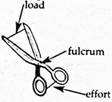
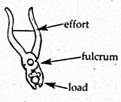
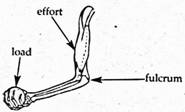
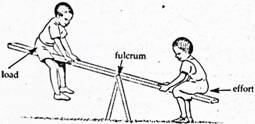
First-order levers- Class two levers (second order levers)
In class two levers, the load is between the effort and fulcrum.
- Class three levers (third order levers)
In class three levers, the effort is between the load and the fulcrum.
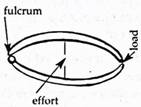
pair of forceps Examples of third-order levers are pair of forceps, fishing rod and tongs.- Pulleys
A pulley is defined as a wheel with a grooved rim in which ropes that lift loads pass through. Each of the pulley system has wheels. Each wheel has a grooved rim.
The pulley system helps to change the direction of pulling. If there are more pulleys, one can even lift heavier loads.TYPES OF PULLEYS
There are three types of pulleys. These are:- fixed pulleys
- movable pulleys
- combined pulleys



types of pulleysFor the fixed pulley, you have to use more effort than the load to be lifted. The advantage of this pulley is that you do not pull or push the pulley up and down and that your body assists in the lifting of the load.
A movable pulley moves with the load. The effort applied in this pulley system is less than the load to be lifted. This is the advantage of the pulley. The disadvantage of this pulley system is that one pulls or pushes the pulley up and down.
The combined pulley makes the effort smaller than the load. The effort is less than half of the weight to be lifted. The disadvantage is that the pulley has to move over a longer distance.
UNIT 18 CARE FOR ROOMS IN THE HOME AND ITS SURROUNDINGS
TYPES OF ROOMS IN A HOUSE
A home may comprise several rooms.
These include sitting room, dining room, bedroom, kitchen, bathroom and toilet.
In a traditional house, the kitchen, toilet and bath shelter are usually built outside the main house.
REASONS FOR CLEANING THE HOME
- promoting the physical and mental health of individuals living in the home
- providing comfort to the occupants of the home
- keeping the original appearance of surfaces in the home
- keeping the surfaces in the home attractive and in good condition
- keeping the home in good condition so that it lasts longer
WAYS OF CLEANING THE HOME
- sweeping
- brushing
- mopping
CARE FOR THE SITTING ROOM AND DINING ROOM
- Sitting room or living room
This room is where family members meet to relax or entertain visitors.
It may also be used for reading, playing indoor games and listening to music.
The furniture for this room, therefore, should provide comfort and an atmosphere of relaxation.
CARE OF THE SITTING ROOM
Daily cleaning
- collect the necessary cleaning equipment and materials
- move light furniture and other objects to one side
- close windows and doors to avoid spreading dust while sweeping
- sweep the floor moving towards the door
- move furniture to the swept area and then sweep the remaining part and move dust together in one place
- collect dust and wrap it in old newspapers and burn it or throw it in a dustbin
- shake mats outside
- dust surfaces and objects.
- clean the floor according to its type. If it is plain concrete or varnished, mop with warm soapy water
- rearrange furniture, magazines or newspapers, if any
- open windows to let in fresh air
- clean and store cleaning materials and equipment
Weekly cleaning
- sweep and dust as in daily cleaning but start with removing cobwebs on the walls and floors
- shake cushions to remove dust and brush off dirt from upholstery furniture
- remove stains on the walls using the correct methods
- clean the floor according to its type
- clean windows thoroughly
- clean furniture and other objects according to their type
- brush and shake mats or rugs, if any
- rearrange furniture neatly.
- clean and store cleaning materials properly
Special cleaning
- carry out daily and weekly cleaning
- clean upholstered furniture and curtains thoroughly
- shampoo carpets, clean or wash mats according to their type
- finish and tidy up the room
- if the floor is made up of mud, smear the floor with mud or cow dung
- Dining room
This room is usually smaller than the living room. It is used for serving meals.
The furniture for this room include the dining table and chairs, the cupboard or sideboard for keeping utensils and table linen.
Sometimes part of the living room or kitchen can be used as a dining room.CARE FOR THE DINING ROOM
Daily cleaning
- collect the necessary cleaning equipment and materials
- move light furniture and other objects to one side
- close windows and doors to avoid spreading dust while sweeping
- sweep the floor moving towards the door
- move furniture to the swept area and then sweep the remaining part and move dust together in one place
- collect dust and wrap it in old newspapers and burn it or throw it in a dustbin
- brush and shake mats outside
- dust surfaces and objects.
- clean the floor according to its type. If it is plain concrete or varnished, mop with warm soapy water
- rearrange furniture, magazines or newspapers, if any
Weekly cleaning
- remove cobwebs from the walls and floors
- sweep and dust as in daily cleaning
- shake cushions to remove dust and brush off dirt from upholstery furniture
- remove stains on the walls using the correct methods
- clean the floor according to its type
- clean windows thoroughly
- clean furniture and other objects according to their type
- brush and shake mats or rugs, if any
- rearrange furniture neatly
- open windows to allow fresh air in the room
- clean and store cleaning materials properly
Special cleaning
- carry out daily and weekly cleaning
- clean upholstered furniture and curtains thoroughly
- shampoo carpets, clean or wash mats according to their type
- finish and tidy up the room
- if the floor is made up of mud, smear the floor with mud or cow dung
CARE OF HOME SURROUNDINGS
Keeping home surroundings clean involves sweeping outside, cutting grass short around the home, removing cobwebs, picking up litter, draining stagnant water, disposing of refuse properly and planting flowers.
It is important to keep the surroundings clean to prevent the spread of diseases such as dysentery, cholera, diarrhoea, food poisoning and worm infections.There are different types of refuse. These are:
- dry refuse
- wet refuse
- Dry refuse
This includes ashes, dust, dry leaves, waste paper, peels, broken glass, food waste and rugs
- Wet refuse
This includes waste and from bathrooms, kitchen and sewage.
These should be disposed of in order to prevent the spread of diseases, avoid bad smell and make the surroundings look attractive.
METHODS OD DISPOSING REFUSE
Dry refuse
This should be collected in dustbins or in rubbish pits. When the bins are full, they can be collected and be emptied in landfills or rubbish pits. Once the rubbish pits are full, they should be covered with soil. Waste paper cab be collected and be recycled.Wet refuse
This refuse should lead into a soak pit. Waste water from washing, bathrooms can be used for watering plants and flowers.UNIT 19 LAUNDRY
Laundry refers to all the processes that are involved in making clothes and household linen clean. These include washing, drying, pressing, airing and storing.
Different materials and equipment are used in all these processes.LAUNDRY MATERIALS
These are sometimes called laundry agents.They include the following:
- water
- soap
- bleaches
- starches
- stain removers
Water
It is one of the most important laundry agents.Clean and soft water is ideal for laundry work.
Soap
This is used with water to remove dirtBleaches
A bleach is a substance used on white articles to brighten them. Bleaches are used only on cotton and linen fabrics.
They help to remove stains.Bleaching can be done naturally or by using chemicals.
Drying white clothes in the open air where there is bright sunlight bleaches clothes naturally.
Starches
This is a laundering material to stiffen and give a smooth finish to garments and articles.When garments and articles are starched they are easy to iron. Starch can be bought in powdered, liquid and spray forms.
Stain removers
Stains are unwanted discolorations on a garment or article. Stains should be removed as soon as they occur.
Some can be removed by using water and soap while others can be removed using stain removers.LAUNDRY EQUIPMENT
Laundry equipment may be large or small.This equipment includes laundry sink, bathtub, basins, pegs, clothes, line, pressing iron, pressing board or table, pails, stand, hangers, pressing sheets and pressing blankets.
When not in use, the equipment should be washed, dried and kept in a cool dry place.STEPS IN LAUNDERING
The main processes in laundering are as follows:
- sorting
- mending
- soaking
- washing
- drying
- pressing
- airing
- storing
THE IMPORTANCE OF LAUNDERING GARMENTS AND ARTICLES
- making garments and articles last long
- making garments and articles look clean and attractive
- preventing bad smells, lice and breeding of germs which cause the spread of diseases such as skin diseases
- promoting good health
- promoting one’s image
TABLE LINEN
Table linen is part of household articles used to decorate the home.These include doilies, chair backs, table cloths, place mats, serviettes and tray cloths. The articles need to be clean and attractive.
This is because families use them when entertaining visitors or serving meals.USES OF TABLE LINEN
- it protects furniture from dust, hot temperatures and spills from food
- it is used for decoration
- it can be used for covering food
- it reduces noise from plates and crockery
LAUNDERING TABLE LINEN
Procedures
- sort according to colour and degree of dirt
- soak in cold water to soften the dirt
- wash in hot soapy water using the friction method
- rinse in hot water first, then in cold water
- use starch if required
- dry in the sun
- dampen the linen before pressing, if necessary
- air outside
- fold and store
UNIT 20 STATES OF MATTER
SOLIDS, LIQUIDS AND GASES
Matter can be classified into solids, liquids and gases.
- SOLIDS
Solids have definite shape and size.
Examples include stones, rubber, wood, flour, bricks and cups.
- LIQUIDS
Liquids flow, can be poured, take the shape of their container and have definite volume. Examples include water, blood, petrol, cooking oil, paraffin and milk.
- GASES
Gases flow in all directions, are easily compressed and fill the container in which they are placed and they do not have a definite shape or size.
Examples include oxygen, carbon dioxide and vapour.USES OF MATTER
- building blocks of structures such as bricks, stones and wire
- as a means of transporting nutrients in living things
- keeping the shape and size of things (turgidity)
- a home of animals
- they are sources of energy for example paraffin and ethane
CHANGES OF STATES OF MATTER
Matter can change its state depending on temperature.Generally, when solids are heated they change into liquids. This is called melting. When liquids are heated they change into gas. This is called evaporation.
When gases are cooled they change into liquid. This is called condensation. Liquids change into solid when cooled. This is called freezing or solidification.
Some solids change from solid state to gaseous state. This process is called sublimation. Iodine can sublimate.
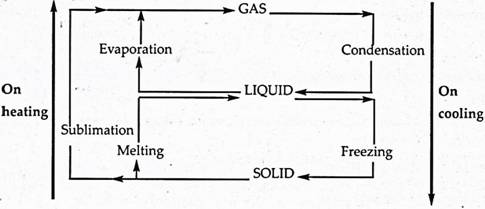
changes of states of matterAPPLICATION OF CHANGES OF STATES OF MATTER
Changes of states of matter can be applied in many ways in everyday life.These include:
- drying clothes
- making ice blocks
- preparation of jelly
- distillation of alcohol
UNIT 21 PACKED MEALS
School children grow fast and are very active.
They, therefore, have a great need for protein, calcium, vitamins, carbohydrates and other nutrients necessary for the body to grow properly.
Therefore, they need to carry nutritious packed meals from home to school. A packed meal is taken during break time to provide energy and refreshment.
Parents and guardians should be discouraged from giving money to school children because they may not buy food, or if they do, it may not be the right kind of food.REASONS FOR TAKING PACKED MEALS TO SCHOOL
- ensures that one has a daily supply of food
- discourages them from stealing from one another
- ensures that they carry clean, safe and nutritious food
FACTORS TO CONSIDER WHEN PLANNING PACKED MEALES
- the nature of food
- the method of cooking
- the nutritive value
- nature of work
- drinks
SUITABLE FOODS FOR PACKED MEALS
- mkate
- fritters
- roasted maize
- roasted groundnuts
- bananas
- oranges
- bean cakes
- boiled cassava
- green maize
- potatoes
- boiled eggs
- fruit juices
SUITABLE MATERIALS FOR CARRYING PACKED MEALS
- plastic paper
- banana leaves
- plastic bottles
- vacuum flasks
- plastic food containers
- aluminium foils
UNIT 22 IMPROVING THE HOME AND ITS SURROUNDINGS
A house can have several rooms.
These include a sitting room, dining room, bedrooms, kitchen, toilet and bathroom. Each of these rooms has a specific function.
WAYS OF IMPROVING VARIOUS ROOMS IN THE HOME
- Sitting room
A good sitting room should have facilities for relaxation and entertainment. These include furniture such as sofa sets or mats.
To make the sitting room cheerful and pleasant:
- clean the room regularly
- ensure it is well ventilated
- improvise furniture
- arrange equipment and furniture attractively
- decorate the room by using items such as mats, floor rugs,, carpets, ornamental plants, pictures and photographs, wooden carvings and paintings
- picture frames should be mended
- damaged pictures should be replaced
- Dining room
A good dining room should have dining chairs, a table, a cupboard or sideboard for storing utensils. This room is usually smaller than a sitting room.
It is used mainly for taking meals.Sometimes part of the living room or kitchen area is used as a dining room.
The dining room can be improved by:
- cleaning it regularly
- improvising furniture
- arranging equipment and furniture properly
- decorating it with items such as floor rugs, ornamental plants, pictures and wood carvings.
- Bedroom
A good bedroom should have facilities for sleeping.
These include beds, mattresses, mats, pillows, sheets and blankets.
A bedside locker or small table is also useful for keeping a bedside lamp or candle. A bedroom should always smell fresh, look attractive and comfortable.
Therefore, it needs plenty of light and ventilation. Light helps to keep insects and pests away.
Big windows provide good ventilation.The bedroom can be improved by:
- cleaning it regularly
- improvising furniture
- arranging equipment and furniture properly
- decorating it with items such as floor rugs, pictures, carpets, lamp shades, bed covers and colourful curtains
- The bathrooms or toilets
In a house with running water, a toilet may be within the house. These should be cleaned with disinfectants frequently.
In addition, the two rooms can be improved by making sure that things are arranged properly, decorating the room with floor rugs, toilet sets and shower curtains.
Windows should be big enough for ventilation.Bath shelters should be well constructed and have a soak pit for proper draining of water.
PLANTING FLOWERS AROUND THE HOUSE
In order to improve the appearance of the surroundings, it is important to plant flowers around the house. Flowers, shrubs or ornamental plants add beauty to the surroundings.
Also, well tendered flower gardens can create a beautiful environment ideal for reading, painting, composing music and writing.
This can give members of the family an opportunity to grow and discover their potentials.RENOVATION OF THE HOME
Apart from improving the various rooms in the house, existing items can be mended or renovated. Hence, new household articles can be made out of available materials.
Items such as table cloths, curtains and bed sheets can be darned, patched and hems repaired. Wooden articles can be re-varnished.
String is cheap and easy to obtain.With a little skill it can be made into many different things that can decorate different rooms in the home.
FLOWER ARRANGEMENTS
The house can also be improved by the use of flowers arranged variously.When using flowers to improve the home consider the following factors:
- the type of occasion
- the colour scheme
- the size of the table
- the shape of the table
PROCEDURES FOR FLOWER ARRANGEMENT
- fit flower supports into the base of a vase. Fill the vase with water
- cut the ends of flower stems evenly to allow easy water uptake
- arrange leaves, ferns or grass to the desired shape
- position flowers according to their size and colour
- look at the arrangement from all directions and add extra leaves or flowers where necessary
- dry the outside of the vase and place it where required. Check the appearance of the arrangement and make necessary alterations
UNIT 23 MANAGING INFORMATION AND COMMUNICATION TECHNOLOGIES
Communication is the process of sending and receiving information. People communicate in different ways.
WAYS OF COMMUNICATING
- verbal communication
- non-verbal communication
Communication can take place verbally by means of talking or singing. This is called verbal communication.
Communication can also take place non-verbally by means of body language and facial expression. This is called non-verbal communication.
With the advancement of technology, different forms of communication have been developed.
These include books, letters, newspapers, magazines, newsletters, television, radio, films or videos, fax, telephone, cell phone, e-mail and internet.
PROBLEMS AFFECTING INFORMATION AND COMMUNICATION
- lack of appropriate information and communication technology
- inability to access and use the available information and communication technology
- high cost of information and communication technology
- vandalism of public information and communication facilities.
- Low levels of literacy which makes it difficult for some people to access certain information
- Poverty which makes it difficult to afford the high cost of information and communication technology
- Poor information and communication services
- Lack of opportunities for training in information and communication
SUGGESTED SOLUTIONS TO PROBLEMS OF INFORMATION AND COMMUNICATION
- Communication should be provided with appropriate information and communication technology
- People should be informed about how to access and use available information and communication technology
- Information and communication technologies should be sold at reasonable prices
- The general public should be sensitised on the importance of public information and communication technologies to minimise vandalism
- The literacy levels among the people should be raised
- Levels of poverty should be reduced
- Information and communication services should be improved
- Personnel working in information and communication including the users should be properly trained
WAYS OF MANAGING INFORMATION AND COMMUNICATION TECHNOLOGIES
- Computers
Computers should be:
- handled by properly-trained persons
- covered after use to avoid dust
- repaired by a qualified person if they have developed a fault
- kept and used in a relatively cool environment
- updated regularly
- Radio
Radios should be:
- handled with care
- given to a qualified person for repairs
- connected to a suitable power supply
- put far from any object that interferes reception
- Cell phone
Cell phone should:
- not be dropped to the ground
- not be in contact with water
- not be used for too long at any particular time
- not be kept or stored in a hot environment
- not be overloaded with information
- be taken to a qualified person for repairs
- be fitted with the right type of battery
- be charged whenever the battery is low
- be switched off in unauthorised places such as banks, planes, fuel stations and places of meetings
- Telephone
Telephone handsets should:
- not be dropped
- be repaired by a qualified person
- not be used for too long to minimise telephone bills
- Fax machine
Fax machine should:
- always remain connected and switched on
- have enough paper for receiving documents
- always have enough toner
- be repaired by a qualified person
- Television set
Television sets should be:
- connected to the power supply
- handled with care
- repaired by a qualified person
- switched off during lightning
- only operated by a person who knows how to do it
DESIGNING INFORMATION AND COMMUNICATION TECHNOLOGIES
Designing new information and communication technologies involves a number of steps.These include:
- identifying the problem
- doing research
- planning
- outlining the technological process
- making the technological device
- testing the technological device
- evaluating the technological process
UNIT 13 SOUND ENERGY
HOW SOUND IS PRODUCED
Sound is produced by a vibrating body or object.
Objects can be set into vibration by plucking, hitting, beating or blowing them. The air in wind instruments is set into vibration by blowing.
Drums vibrate by hitting or beating them. String instruments vibrate by plucking them.
For drums and string instruments to vibrate and produce sound, they must have a certain amount of tension. The production of sound requires a vibrating source.
Musical instruments can be classified as wind, string and percussion instruments.
Examples of sources of sound are vocal cords, stretched pieces of string, reed, drums, insects, animals, cell phones, sirens, motor vehicles, radio and wind instruments.
USES OF SOUND
APPLICATION OF SOUND IN TECHNOLOGY
The technological application of sound include:
UNIT 14 METHODS OF COOKING FOOD
REASONS FOR COOKING FOOD
METHODS OF COOKING FOOD
This involves cooking food in boiling water until it is tender.
Suitable foods for boiling include meat, fish, starchy foods, green vegetables and root vegetables.
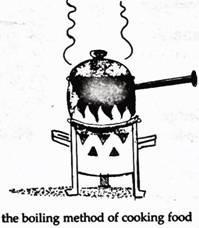
THE ADVANTAGES OF BOILING FOOD
THE DISADVANTAGES OF BOILING FOOD
COOKING FOOD USING THE BOILING METHOD GUIDELINES
This is cooking food in steam rising from boiling water. There are two ways of steaming food.
These are:
DIRECT STEAMING
This is a type of steaming method where the steam gets into contact with the food.
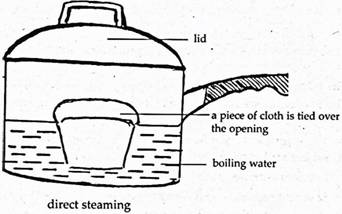
For example, when cooking mkate, the food is wrapped up in banana leaves and placed in a small amount of water.
INDIRECT STEAMING
This is a type of steaming where the steam does not get into contact with the food. The food is placed in another container over a pot of boiling water.
Suitable foods for steaming include fresh fish, liver, root vegetables, pudding, egg and milk custard.
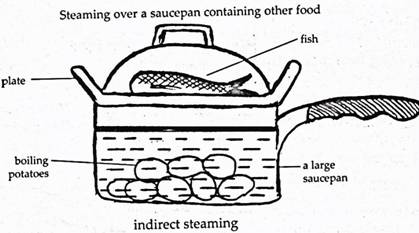
THE ADVANTAGES OF STEAMING FOOD
DISADVANTAGES OF STEAMING FOOD
COOKING USING THE STEAMING METHOD GUIDELINES
UNIT 15 KITCHEN HYGIENE AND SAFETY
The kitchen is a place where food is stored, prepared and cooked.
THE IMPORTANCE OF KITCHEN HYGIENE
KITCHEN HYGIENE
Hygiene in the kitchen starts with people who work in the kitchen.
They should practice personal hygiene which involves:
The kitchen should be kept clean at all times. This involves:
Food should be handled hygienically. The guidelines for food hygiene include:
Daily cleaning of the kitchen
The daily cleaning of the kitchen should include:
Weekly cleaning
In addition to daily cleaning, it is necessary to undertake thorough cleaning once a week which may involve:
Occasional cleaning
Occasional cleaning of the kitchen involves all the other activities done daily and weekly, but also involves:
SAFETY IN THE KITCHEN
The kitchen can be a cause of accidents if it is not properly cared for.
COMMON CAUSES OF ACCIDENTS IN THE KITCHEN
COMMON ACCIDENTS IN THE KITCHEN
SAFETY PRECAUTIONS IN THE KITCHEN
UNIT 16 MEAL PLANNING AND PRESENTATION
A meal is a set of dishes served and eaten together at a specific time. It can be served in the morning, in the afternoon and in the evening. Meals should be nutritionally balanced and contain all food groups.
THE IMPORTANCE OF MEAL PLANNING
FACTORS TO CONSIDER WHEN PLANNING MEALS
GUIDELINES FOR PLANNING MEALS
PLANNING SIMPLE NUTRITIOUS MEALS FOR THE FAMILY
There are three main meals in a day.
These are:
Meals should be planned carefully taking into account factors and guidelines for meal planning.
Examples of menus for different meals of the day
Breakfast |
Lunch |
Supper |
Sample 1 |
Sample 1 |
Sample 1 |
Orange drink Rice porridge Tea with milk |
Stewed beef Boiled kholowa Nsima |
Stewed beans Vegetable salad Steamed rice |
Sample 2 Pawpaw salad Mgaiwa porridge Thobwa |
Sample 2 |
Sample 2 Stewed fish Boiled nkhwani Nsima |
FACTORS TO CONSIDER WHEN SERVING MEALS
UNIT 17 MACHINES
THE USES OF MACHINES
Machines help us to do work easily. A machine amplifies force.
Some machines such as tongs and tweezers assist in holding hot objects
TYPES OF MACHINES
The following are examples of simple machines:
An inclined plane is a simple machine.
It consists of a plank or metal bar inclined to the earth’s surface. The load is pushed along the inclined plane onto a higher place.
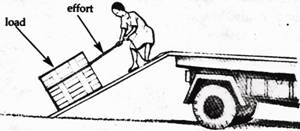

inclined planes
The inclined plane allows a small force called effort to push a heavy load onto the body of a lorry.
![]() An inclined plane provided a mechanical advantage (MA) which is worked out by dividing the load by the effort:
An inclined plane provided a mechanical advantage (MA) which is worked out by dividing the load by the effort:
![]()
![]() MA =
MA =
Load Effort
The load is the weight of the object and effort is the force exerted when moving the load up the inclined plane.
One can obtain a bigger mechanical advantage if longer, smoother surfaces and rollers are used.
A lever is a rigid body pivoted on an axis where it turns. The point where a lever turns is called a fulcrum.
There are many examples of levers such as a bottle opener, a pair of pliers, crowbar, arm, scale, wheelbarrow and a pair of scissors.
CLASSES OF LEVERS
Levers fall into three classes based on the arrangement of effort, fulcrum and load.
In class one levers, the fulcrum is between the load and effort.
![]()
STANDARD 6 LIFE SKILLS
UNIT 1 GROWING UP
CHANGES DURING ADOLESCENCE IN BOYS
- deepening of voice
- development of pimples on their faces
- broadening of shoulders
- growing of pubic hair
- experiencing of wet dreams
- enlargement of penis and testes CHANGES IN GIRLS DURING ADOLESCENCE
- hips getting wider and more round
- the breast beginning to grow
- beginning of menstruation
- development of pimples on their faces
- growth of pubic hair
BEHAVIOR CHANGES IN BOTH BOYS AND GIRLS
- develop interest in sex
- begin to rebel against parental authority
- becoming closer to their peers emotionally and socially PROBLEMS WHICH ADOLESCENTS EXPERIENCE
- peer pressure
- drug and substance abuse
- sexual harassment
- teenage pregnancies
- rape
- contraction of HIV that mau lead to AIDS
DEALING WITH PROBLEMS YOUNG PEOPLE EXPERIENCE
- abstinence
- guidance and counseling
- acquisition of life skills UNIT 2 PERSONAL HYGIENE
EXAMPLES OF GOOD HEALTH HABITS
- proper handling of food
- good eating habits
- eating nutritious food
- washing hands
- cleaning teeth
- doing physical exercises
- rest and sleep
CULTURAL PRACTICES THAT AFFECT GOOD HEALTH HABITS
- not bathing
- not eating certain food
- wife inheritance ( chokolo)
- swapping of spouses
- sexual partners ( chimwanamaye) UNIT. 3 SANITATION
What is sanitation ?
Sanitation is the care of people's surrounding TYPES OF SANITATION
- good sanitation
- bad sanitation
Examples of good sanitation practices
- proper use of the toilets
- proper use of bathrooms
- proper use of rubbish pit
Below is a table illustrating specific waste from various sources
Source of waste |
Types of waste |
People's and animal bodies |
feaces,urine,sweat |
Homes |
dirty water,leftover food, fruit peels,plastic bags,containers, paper |
Industries |
paper, cotton rugs,plastic bags,containers,pieces of glass,chemical wastes |
TOILETS
Toilets help proper disposal of body wastes TYPES OF TOILETS
There are two types of toilets. These are
- Pit latrines
- Water closets
BATHROOMS
There are three types of bathrooms. These are
- Shower
- Bathtub
- Bath shelter RABBISH PITS
All litter and rubbish swept in the home and school should be put in the rubbish pit
UNIT 4 SELF AWARENESS
What is self awareness ?
Is the ability to assess one self in terms of strengths and weakness CHARACTERISTICS OF A PERSON WITH A POSITIVE SELF AWARENESSES
- the person accept responsibilities
- the person makes independent decisions
- the person accepts criticism
THE IMPORTANCE OF SELF AWERANESS
Self awareness is important in that it assists one to develop a consious and honest understanding and evaluation of oneself. One is able to discover one's capabilities, likes,dislikes and values
UNIT 5 SELF ESTEEM
What is self-esteem ?
Self-esteem is the value an individual places on oneself THE IMPORTANCE OF SELF-ESTEEM
- being accepted by others
- being shown love and care
- being rewarded by others for success
- achievements
FACTORS THAT INFLUENCE LOW SELF-ESTEEM
- frequent failures
- exposure to negative comments
- loss of close family member or friends
- gender inequality
- poverty
- abuse
- loneliness
UNIT 6 ASERTIVENESS
Assertiveness is being able to convey one's views and feelings to others without fear THE IMPORTANCE OF ASSERTIVENESS
- avoiding social and health problems
- achieving one's goals
- promoting honest relationships
- Maintaining personal identity
FACTORS THAT INFLUENCE ASSERTIVENESS
- prior knowledge
- the way one was brought up
- one's values and morals
UNIT 7 INTERPERSONAL RELATIONSHIPS
Interpersonal relationships are relationships between or among people.
FACTORS THAT INFLUENCE PEOPLE TO LIVE TOGETHER IN THEIR COMMUNITIES
- neighbourliness
- love
- support
- sharing of common national services
- security
- employment
- cooperation
- relationship
- religion
- ethnicity
- recreation
- culture
FACTORS THAT PROMOTE RELATIONSHIPS
- love
- care
- empathy
- tolerance
- gender sensitivity
- observation of human rights
- respect
- effective communication
- honesty
- politeness
- discipline
- loyalty
FACTORS THAT DESTROY RELATIONSHIPS
- envy
- unfulfilled promises
- jealousy
- rudeness
- poverty
- disrespect
- violence
- theft
- gossip
- lies
UNIT. 8 STRESS AND ANXIETY
What is stress ?
Is the pressure or worry from difficult situations What is anxiety ?
Anxiety is the trouble feeling in the mind caused by fear and uncertainty about the future CAUSES OF STRESS AND ANXIETY
- death of a loved one
- pressure of work
- peer pressure
- chronic illness
- failure to do or achieve something
- poverty
- speaking in front of a crowd of people
- starting and leaving school
- losing a job
- legal problems
- awaiting results of HIV test
- discrimination
EFFECTS OF STRESS AND ANXIETY
GOOD EFFECTS OF STRESS AND ANXIETY
- improve awareness
- promote alertness
- result in good performs
BAD EFFECTS OF STRESS AND ANXIETY
- headaches
- short temper
- overreacting to trivial things
- fatigue
- restlessness
- sleepless ness
- Boredom
- depression
- low job performance
- indigestion
- difficulty concentrating
- in ability to finish tasks that have been started
- heart attacks
- hypertension
- strokes
- ulcers
- asthma
- Cancer
WAYS OF MANAGING STRESS AND ANXIETY
- regular active exercise
- developing a positive mental attitude to problems
- proper planning and organization
- seeking social support
- adequate rest
- trust in God
- relaxation
- having enough sleep
UNIT 9 PROBLEM SOLVING AND DECISION MAKING
Situations and condition that require decision making and problem solving
- physical changes in the body
- adolescence
- sexual relationship
- cultural practices
- peer pressure
- poverty
- orphanhood
- STIs
- drug and substance abuse
- environmental degradation
- violence
- delinquency
THE IMPORTANCE OF WELL THOUGHT AND PROBLEM SOLVING SKILLS
- it promote the ability of resisting situation that may lead people into problems
- it help one to concentrate on productive activities CONSEQUENCES OF MAKING WRONG DECISIONS
It result in improper actions such as
- rape
- harassment
- drug and substance abuse
- criminal activities
- suicide
- teenage pregnancy
- contraction of STIs including HIV/AIDS
- school dropout
- abortion
- death
FACTORS THAT INFLUENCE DECISION MAKING
- gender
- anxiety
- peer pressure
- religious
- one's personality
THE PROCESS OF DECISION MAKING AND PROBLEM SOLVING
- Knowing the problem
- Considering possible solutions
- Examining consequences of each solution
- Choosing the best solution
- Taking necessary action
UNIT. 10 PEACEFUL CONFLICT RESOLUTION
Situations that may lead to conflicts;
- teenage pregnancies
- abortion
- illnesses
- forced marriage
- drug and substance abuse
- risky behaviour
- gender inequities
- violation of human rights
- boy or girl relationship WAYS OF AVOIDING CONFLICTS
- avoiding risky behaviors
- being tolelant
- respecting other people's views
- being patient
- respecting oneself and others
- not provoking other people
- promoting gender equality
WAYS OF RESOLVING CONFLICTS PEACEFULLY
- Negotiation
- Mediation
- Arbitrator
THE IMPORTANCE OF RESOLVING CONFLICTS PEACEFULLY
- helps to promote unity
- it promote cooperation and development
- it create good relationship
- it promote human dignity
- it prevents violence
- it protect life and property
UNIT 11 DRUG AND SUBSTANCE ABUSE
What are drugs ?
Drugs are chemicals that are taking orally or through injunctions to relieve pain or suffering EXAMPLES OF DRUGS
- Paracetamol
- Aspirin
- Penicillin
What is drugs and substance abuse ?
Drugs and substance abuse is the use of drugs and substance for an intended purposes EXAMPLES
- over drinking alcohol
- overdose and under dose of common drug
- taking expired drugs
- taking medicines without the doctors advice ( self medication )
FACTORS THAT CONTRIBUTE TO DRUG AND SUBSTANCE ABUSE
- lack of self control in copying of what others are doing
- lack of self confidence
- influence from friends
- to get excited
- to show off to others that they are courageous
- frustration and loneliness
EFFECTS OF DRUG AND SUBSTANCE ABUSE
- mental disorders
- crime
- death
- exposure to early teenage pregnancies
- STIs including HIV and AIDS
UNIT 12 GUIDANCE AND COUNSELLING
What is counselling ?
Counseling is the process of helping someone to overcome personal challenges PROBLEMS THAT AFFECT THE YOUTHS AS THEY GROW UP
- Physical and emotional changes
- Peer pressure
- Drug and substance abuse
- STIs and HIV
- Sexual relationships
IMPORTANCE OF GUIDANCE AND COUNSELLING
- It assist the learners to avoid risky behaviour
PLACES WHERE TO GET GUIDANCE AND COUNSELING SERVICES
- Family members
- Teachers
- Health professional
- Religious leaders
- Youth clubs
- From counsellors
UNIT 13 MORALS AND VALUES
What are morals ?
Morals are acceptable codes of conduct in any society
What are values ?
Values are beliefs and standards one regards to be important
UNIT 14 CULTURAL PRACTICES THAT FACILITATE THE SPREAD OF HIV
- Wife inheritance ( chokolo)
- Swapping sexual partners (chimwanamaye)
- Kuchotsa fumbi
- Circumcision
- Kulowa kufa GENDER,HIV AND AIDS
Why women have more chances of getting HIV than men ?
- Poverty
- Women are not expected to say no to sex in marriage
- Women receive all the seminal fluids from the man which may have high quantity of HIV UNIT 15 EFFECTIVE COMMUNICATION ON HIV AND AIDS
CHANNELS OF COMMUNICATION ON HIV AND AIDS
- News papers
- Books
- Radios
- Television
FACTORS THAT PREVENT EFFECTIVE COMMUNICATION ON HIV AND AIDS
- Age
- Cultural factors
- Religion
FACTORS PROMOTING EFFECTIVE COMMUNICATION
- tolerance
- empathy
- respect
- patience
- intepersonal relationship
UNIT 16 SEXUALLY- TRANSIMITTED INFECTION
Sexual transmitted infection is an infection passed on from an infected person to a health person mainly through sexual intercourse
COMMON STIs
- Syphilis
- Candidiasis
- Herpes
- Gonorrhoea
- AIDS
SIGNS AND SYMPTOMS OF STIs
- Sore or blister on or around genitals
- Un usual discharge from the penis or vagina
- Pain when urinating
- Excessive itching on the genitals
- Smelly discharge from genitals TRANSMISSION OF STIs INCLUDING HIV
- Unprotected sexual intercourse
- Sharing pants
- Kissing
- Infected mother to her baby during pregnancy PREVENTION OF STIs INCLUDING HIV
- abstinence
- mutual faithful
- not sharing skin piercing instruments
- use of drugs to prevent mother- to - child transmission UNIT 17 VOLUNTARY COUNSELLING AND TESTING
Voluntary testing and counselling ( VCT ) is a service that is offered to anyone who wishes to know whether he or she is infected with HIV
Voluntary means that a person is not forced to go for testing
In counseling, aperson helps someone to arrive at a reasonable decision whether to take an HIV test or not . The one helping is known as a counsellor
And the one receiving help is a client
TESTING means checking whether one is infected with HIV or not
STAGES IN THE VCT PROCESS
- A person goes for VCT
- A person counselled before testing
- A person decides whether to be tested or not
- If a person decides to be tested he or she is counseled results are given
HIV - NEGATIVE
HIV- POSITIVE
SESSIONS FOR VOLUNTARY COUNSELLING AND TESTING
- Pre- testing counseling
- Test process
- Implication of testing
- Risk assessment
- Prevention counselling
- Assessing coping strategies
- Decision to test
- Testing
THE IMPOTENCE OF VOLUNTARY COUNSELLING AND TESTING (VCT)
- It helps one accept one's HIV status
- It reduces HIV and AIDS stigma
- It reduces parents - to - child transmission
- It promote planning and preparation of a will
- It facilitates social support
- It facilitates behavioral change
UNIT 18 THE RIGHTS OF PEOPLE LIVING WITH HIV AND AIDS
What are human Rights ?
Human rights are natural entitlements due to persons by virtue of being human beings
RIGHTS OF PEOPLE LIVING WITH HIV AND AIDS
- Right to equality
- Right to liberty
- Right to human dignity
- Right to health
- Right to employment
- Right to participation SPECIFIC RIGHTS OF PLWA
- Right to live free from harmful discrimination
- Right to be treated with respect and dignity
- Right to confidential and comprehensive pre- and post- test counseling and to give informed consent
- Right to HIV testing and monitoring without being forced
- Right to quality medical care, palliative care and support services WAYS OF PROMOTING THE RIGHTS OF PEOPLE LIVING WITH HIV AND AIDS
- Introduction of HIV and AIDS education in schools and colleges
- Establishment of NGOs that work to promote and protect the rights of people living with HIV and AIDS
- Public awareness campaigns on the rights of people with HIV and AIDS
- Forming associations of people living with HIV and AIDS UNIT 19 VULNERABLE CHILDREN
Who is a vulnerable child ?
A vulnerable child is one who has no one to take care of him or she EXAMPLES OF VULNERABLE CHILDREN
- Street children
- Child labourers
- Child vendors
- Child sex workers
- Young domestic workers
- Child headed households
- Children with special needs
- Children involved in drug trafficking WAYS OF ASSISSTING VULNERABLE CHILDRENS
- giving them good education
- placing them in orphanage
- providing them with support and care
WAYS IN WHICH ORPHANS AND VULNERABLE CHILDREN CAN AVOID CONTRACTING HIV AND AIDS
- taking good parantal advice
- having friends with good behavior
- resisting bad influence from friends
- being at home in good time
- participating in regular sporting activities
- abstaining from sex before marriage
- reading good books
- making right decisions
- self awareness
- attending religious meeting
- being assertive
- having self-esteem UNIT. 20 HOME- BASED CARE
Home based care means looking after the sick in their homes THE IMPORTANCE OF HOME BASED CARE
- It is economical on the part of guardians
- It reduces overcrowding in hospitals
- It allows more people to be involved in caring for those living with HIV and AIDS GROUP OF PEOPLE WHO CAN PROVIDE HOME- BASED CARE
- Family
- Religious groups
- Political readers
- Non - governmental organization THINGS WHICH CARE PROVIDERS NEED TO DO
- Feeding patients with nutritious food
- Bathing them and washing their clothes
- Taking them to the hospital when they are sick
- Chatting with them
- Counseling and comforting them
- Giving them basic items
THE QUALITIES OF HOME- BASED CARE PROVIDERS
- empathy
- patience
- tolerance
- kindness
THINGS HOME- BASED CARE PROVIDERS NEED TO KNOW
- Procedures when bathing a patient
- Laundering for a patient
- Feeding a patient UNIT 21 PLANNING
What is the meaning of the term ' planning' ?
Planing refers to logical sequencing of activities for proper organization and management of resources
STAGES IN THE PLANNING PROCESS
- Identifying goals
- Organising resources
- Choosing course of as action
- Implementing the plan
- Monitoring
- Evaluation
SITUATION THAT CAN CHANGE PLANS
- Death
- In availability of resources
- Un planned pregnancies
- Illnesses including AIDS
- Stress and anxiety
- Conflicting activities
THE IMPORTANCE OF PLANNING
- Is a key to success
- achievements of goals
- helps to avoid contracting STIs including HIV and AIDS
- helps to monitor how the activity is being done
- easy to follow procedures
UNIT 22 ENTREPRENEURSHIP AND HIV AND AIDS
Entrepreneurship is an activity or small scale business through which people generate money HOW ENTREPRENEURSHIP CAN HELP PREVENT THE SPREAD OF HIV AND AIDS
They may not engage themselves in commercial sex through which they may contract HIV and AIDS
FACTORS THAT HINDER THE SUCCESS OF BUSINESSES OF PEOPLE LIVING WITH HIV AND AIDS
- Stigmatisation
- Discrimination
UNIT 23. GENDER AND ENTREPRENEURSHIP
What is gender ?
The term gender refers to roles that men and women do or are expected to do in a particular society
What is entrepreneurship ?
Entrepreneurship is an activity or business through which people make money. FACTORS THAT AFFECT OR SLOW DOWN ENTREPRENEURSHIP
- diseases
- poverty
- discrimination
- lack of capital
- gender biases
SKILLS REQUIRED FOR ENTREPRENEURSHIP
- critical thinking
- planning
- budgeting
- effective communication
- interpersonal relationship skills
HOW GENDER AFFECTS ENTREPRENEURSHIP
Women may be denied access to loans simply because they are females.
End
Compiled by; emmanuel kapachika